
Unfortunately in today’s world, scammers are coming at us from all angles to trick us to get us to part with our hard-earned money. We all need to be vigilant in protecting ourselves online. If you aren’t paying attention, even if you know what to look for, they can get you. There are numerous ways to detect fake sites or emails, phishing, and other scams.
Before we delve into the signs of fake websites, we will first take a closer look at the common types of scam that use websites, what happens when you accidentally access a fake website, and what you can do in case you unknowingly purchased items from it.
Fake or scam websites are fraudulent sites that look legitimate while secretly attempting to steal your personal information, money, or account access.
These deceptive platforms masquerade as trustworthy businesses or organizations, sending urgent messages such as popular shopping websites offering fantastic limited-time deals, banking websites requesting immediate account verification, government portals claiming you owe taxes or are eligible for refunds, and shipping companies asking for delivery fees.
The urgency aims to trick you into logging in and sharing sensitive details—credit card numbers, Social Security information, login credentials, and personal data. Once you submit your data, the scammers will steal your identity, drain your accounts, or sell your details to other criminals on the dark web.
These scam websites have become increasingly prevalent because they’re relatively inexpensive to create and can reach millions of potential victims quickly through email and text campaigns, social media ads, and search engine manipulation.
Cybersecurity researchers and consumer protection agencies discover these fraudulent sites through various methods, including monitoring suspicious domain registrations, analyzing reported phishing attempts, and tracking unusual web traffic patterns. According to the FBI’s Internet Crime Complaint Center, losses from cyber-enabled fraud amounted to $13.7 billion, with fake websites representing a significant portion of these losses.
Visiting a fake website, accidentally or intentionally, can expose you to several serious security risks that can impact your digital life and financial well-being:
Scammers use different tricks to make fake websites look real, but most of them fall into familiar patterns. Knowing the main types of scam sites helps you recognize danger faster. This section lists the most common categories of scam websites, how they work, and the red flags that give them away before they can steal your information or money.
Understanding these common scam types helps you recognize fake sites before they can steal your information or money. When in doubt, verify legitimacy by visiting official websites directly through bookmarks or search engines rather than clicking suspicious links.
For the latest warnings and protection guidance, check resources from the Federal Trade Commission and the FBI’s Internet Crime Complaint Center.
You can protect yourself by learning to recognize the warning signs of fake sites. By understanding what these scams look like and how they operate, you’ll be better equipped to shop, bank, and browse online with confidence. Remember, legitimate companies will never pressure you to provide sensitive information through unsolicited emails or urgent pop-up messages.
Most scams usually start out from social engineering tactics such as phishing, smishing, and fake social media messages with suspicious links, before leading you to a fake website.
From these communications, the scammers impersonate legitimate organizations before finally executing their malevolent intentions. To avoid being tricked, it is essential to recognize the warning signs wherever you encounter them.
Fake emails are among the most common phishing attempts you’ll encounter. If you see any of these signs in an unsolicited email, it is best not to engage:
Smishing messages bear the same signs as phishing emails and have become increasingly sophisticated. These fake messages often appear to come from delivery services, banks, or government agencies. Common tactics include fake package delivery notifications, urgent banking alerts, or messages claiming you’ve won prizes or need to verify account information.
Legitimate organizations typically don’t include clickable links in unsolicited text messages, especially for account-related actions. When in doubt, don’t click the link—instead, open your banking app directly or visit the official website by typing the URL manually.
Social media platforms give scammers new opportunities to create convincing fake profiles and pages. They might impersonate customer service accounts, create fake giveaways, or send direct messages requesting personal information. These fake sites often use profile pictures and branding that closely resemble legitimate companies.
Unusual sender behavior is another indicator of a scam across all platforms. This includes messages from contacts you haven’t heard from in years, communications from brands you don’t typically interact with, or requests that seem out of character for the supposed sender.
Scammers have become increasingly cunning in creating fake websites that closely mimic legitimate businesses and services. Here are some real-life examples of how cybercriminals use fake websites to victimize consumers:
Scammers exploit your trust in the United States Postal Service (USPS), designing sophisticated fake websites to steal your personal information, payment details, or money. They know you’re expecting a package or need to resolve a delivery issue, making you more likely to enter sensitive information without carefully verifying the site’s authenticity.
USPS-themed smishing attacks arrive as text messages stating your package is delayed, undeliverable, or requires immediate action. Common phrases include “Pay $1.99 to reschedule delivery” or “Your package is held – click here to release.”
Scammers use various URL manipulation techniques to make their fake sites appear official. Watch for these red flags:
Always verify package information and delivery issues through official USPS channels before taking any action on suspicious websites or messages:
Reporting fake USPS websites helps protect others from falling victim to these scams and assists law enforcement in tracking down perpetrators.
Remember that legitimate USPS services are free for standard delivery confirmation and tracking. Any website demanding payment for basic package tracking or delivery should be treated as suspicious and verified through official USPS channels before providing any personal or financial information.
According to the Federal Trade Commission, tech support scams cost Americans nearly $1.5 billion in 2024. These types of social engineering attacks are increasingly becoming sophisticated, making it more important than ever to verify security alerts through official channels.
Sadly, many scammers are misusing the McAfee name to create fake tech support pop-up scams and trick you into believing your computer is infected or your protection has expired and hoping you’ll act without thinking.
These pop-ups typically appear while you’re browsing and claim your computer is severely infected with viruses, malware, or other threats. They use official-looking McAfee logos, colors, and messaging to appear legitimate to get you to call a fake support number, download malicious software, or pay for unnecessary services.
Learning to detect fake sites and pop-ups protects you from scam. Be on the lookout for these warning signs:
If you see a suspicious pop-up claiming to be from McAfee, here’s exactly what you should do:
To check if your McAfee protection is genuinely active and up-to-date:
Remember, legitimate McAfee software updates and notifications come through the installed program itself, not through random browser pop-ups. Your actual McAfee protection works quietly in the background without bombarding you with alarming messages.
Stay protected by trusting your installed McAfee software and always verifying security alerts through official McAfee channels such as your installed McAfee dashboard or the official website.
Be prepared and know how to respond quickly when something doesn’t feel right. If you suspect you’ve encountered a fake website, trust your instincts and take these protective steps immediately.
Recognizing fake sites and emails becomes easier with practice. The key is to trust your instincts—if something feels suspicious or too good to be true, take a moment to verify through official channels. With the simple verification techniques covered in this guide, you can confidently navigate the digital world and spot fake sites and emails before they cause harm.
Your best defense is to make these quick security checks a regular habit—verify URLs, look for secure connections, and trust your instincts when something feels off. Go directly to the source or bookmark your most-used services and always navigate to them. Enable two-factor authentication on important accounts, and remember that legitimate companies will never ask for sensitive information via email. Maintaining healthy skepticism about unsolicited communications will protect not only your personal information but also help create a safer online environment for everyone.
For the latest information on fake websites and scams and to report them, visit the Federal Trade Commission’s scam alerts or the FBI’s Internet Crime Complaint Center.
The post Ways to Tell if a Website Is Fake appeared first on McAfee Blog.

Leading off our news on scams this week, a heads-up for DoorDash users, merchants, and Dashers too. A data breach of an undisclosed size may have impacted you.
Per an email sent by the company to “affected DoorDash users where required,” a third party gained access to data that may have included a mix of the following:
You might have got the email too. And even if you didn’t, anyone who’s used DoorDash should take note.
As to the potential scope of the breach, DoorDash made no comment in its email or a post on their help site. Of note, though, is that one of the help lines cited in their post mentions a French-language number—implying that the breach might affect Canadian users as well. Any reach beyond the U.S. and Canada remains unclear.
Per the company’s Q2 financial report this year, “hundreds of thousands of merchants, tens of millions of consumers, and millions of Dashers across over 30 countries every month.” Stats published elsewhere put the user base at more than 40 million people, which includes some 600,000 merchants.
The company underscored that no “sensitive” info like Social Security Numbers (and potentially Canadian Social Insurance Numbers) were involved in the breach. This marks the third notable breach by the well-known delivery service, with incidents in 2019 and 2022
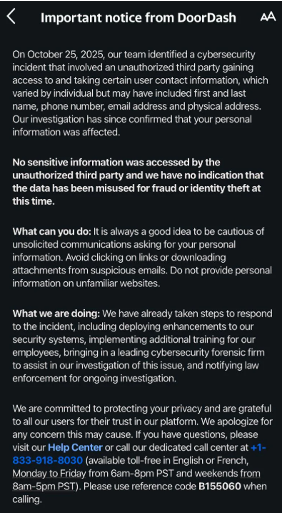
While the types of info involved here appear to be limited, any time there’s a breach, we suggest the following:
Protect your credit and identity. Checking your credit and getting identity theft protection can help keep you safer in the aftermath of a breach. Further, a security freeze can help prevent identity theft if you spot any unusual activity. You can get all three in place with our McAfee+ Advanced or Ultimate plans.
Keep an eye out for phishing attacks. With some personal info in hand, bad actors might seek out more. They might follow up a breach with rounds of phishing attacks that direct you to bogus sites designed to steal your personal info. As with any text or email you get from a company, make sure it’s legitimate before clicking or tapping on any links. Instead, go straight to the appropriate website or contact them by phone directly. Also, protections like our Scam Detector and Web Protection can alert you to scams and sketchy links before they take you somewhere you don’t want to go.
Update your passwords and use two-factor authentication. Changing your password is a strong preventive measure. Strong and unique passwords are best, which means never reusing your passwords across different sites and platforms. Using a password manager helps you stay on top of it all while also storing your passwords securely.
Even as the FAA lifted recent flight restrictions on Monday morning, scammers are still taking advantage of lingering uncertainty, and upcoming holiday travel, with a spate of flight cancellation scams.
Fake cancellation texts
The first comes via a text message saying that your flight has been cancelled and you must call or rebook quickly to avoid losing your seat—usually in 30 minutes. It’s a typical scammer trick, where they hook you with a combination of bad news and urgency. Of course, the phone number and the site don’t connect you with your airline. They connect you to a scammer, who walks away with your money and your card info to potentially rip you off again.
Fake airline sites in search results
The second uses paid search results. We’ve talked about this trick in our blogs before. Because paid search results appear ahead of organic results, scammers spin up bogus sites that mirror legitimate ones and promote them in paid search. In this way, they can look like a certain well-known airline and appear in search before the real airline’s listing. With that, people often mistakenly click the first link they see. From there, the scam plays out just as above as the scammer comes away with your money and card info.
Q: How can I confirm whether my flight is really canceled?
A: Check directly in your airline’s official app or website. Never click links in texts or emails.
Q: How can I spot a fake airline search result?
A: Look for “Ad”/“Sponsored,” confirm the URL, and check that the site uses HTTPS, not HTTP.
Q: Is there a tool that flags fake booking sites?
A: Scam-spotting tools like Scam Detector and Web Protection can identify sketchy links before you click.
In search, first isn’t always best.
Look closely to see if your top results are tagged with “Sponsored” or “Ad” in some way, realizing it might be in fine print. Further, look at the web address. Does it start with “https” (the “s” means secure), because many scam sites simply use an unsecured “http” site. Also, does the link look right? For example, if you’re searching for “Generic Airlines,” is the link the expected “genericairlines dot-com” or something else? Scammers often try to spoof it in some way by adding to the name or by creating a subdomain like this: “genericairlines.rebookyourflight dot-com.”
Get a scam detector to spot bogus links for you.
Even with these tips and tools, spotting bogus links with the naked eye can get tricky. Some look “close enough” to a legitimate link that you might overlook it. Yet a combination of features in our McAfee+ plans can help do that work for you. Our Scam Detector helps you stay safer with advanced scam detection technology built to spot and stop scams across text messages, emails, and videos. Likewise, our Web Protection will alert you if a link might take you to a sketchy site. It’ll also block those sites if you accidentally tap or click on a bad link.
You’ve probably seen plenty of messages sent by short code numbers. They’re the five- or six-digit codes used to send texts instead of by a phone number. For example, your cable company might use one to send a text for resetting a streaming password, the same goes for your pharmacy to let you know a prescription is ready or your state’s DoT to issue a winter travel alert, and so on.
According to NBC News, scammers sent hundreds of thousands of texts using codes used by the state of New York, a charity, and a political organizing group. The article also cites an email sent to messaging providers by the U.S. Short Code Registry, an industry nonprofit that maintains those codes in the U.S. In the email, the registry said attempted attacks on messaging providers are on the rise.
What this means for the rest of us is that just about any text from an unknown number, and now short codes, might contain malicious links and content. It’s one more reason to arm yourself with the one-two punch of our Scam Detector and Web Protection.
What are short codes?
Short codes are 5–6 digit numbers used by pharmacies, utilities, banks, and government agencies to send official alerts.
Why this attack is unusual
Scammers didn’t spoof short codes—they gained access to real ones used by:
Why this matters
Even texts from legitimate short-code numbers can no longer be trusted at face value.
Consumers warned over AI chatbots giving inaccurate financial advice
Why our own clicks are often cybercrime’s greatest allies
TikTok malware scam uses fake software activation guides to steal data
We’ll be back after the Thanksgiving weekend with more updates, scam news, and ways to stay cyber safe.
The post This Week in Scams: DoorDash Breach and Fake Flight Cancellation Texts appeared first on McAfee Blog.

Contactless payments make everyday purchases fast and easy. Yet with that convenience comes a risk: ghost tapping.
In crowded spaces or rushed moments, a scammer could trigger a small tap-to-pay charge or push through a higher amount without your clear consent. Understanding what ghost tapping is, how it happens, and what to do next helps you keep your money and identity secure.
Ghost tapping is a form of contactless fraud where someone attempts to initiate a tap-to-pay transaction without your approval.
Tap-to-pay cards and mobile wallets on phones use a technology called “near-field communication,” or NFC. That lets them communicate with things like a point-of-sale device for payment at a very close range. It’s generally quite safe, particularly because of the “near” part. You have to get very close to make the connection.
Even so, proximity and distraction can be exploited. Attackers may try to skim limited details from RFID (Radio Frequency Identification technology) cards or NFC cards, or nudge you into approving a payment you didn’t intend. If you’ve ever wondered what ghost tapping is, think of it as an opportunistic, in-person scam that abuses the tap-to-pay moment rather than a remote hack.
Most schemes rely on getting close and catching you off guard. A criminal might carry a portable reader, press into a pocket or bag, and attempt a low-value charge. Others set up tampered terminals, rushing you so you don’t check the amount.
You’re at a busy farmer’s market. A scammer with a phone equipped with a point-of-sale app stumbles into you and gets close enough to your card to trigger a transaction. It’s almost like a modern-day pickpocket move, where the bump distracts the victim from the theft as it happens.
In another case, you might come across a phony vendor. Maybe someone’s selling cheap hats outside a football game or someone’s going around your neighborhood selling candy, supposedly to support a charity. In scenarios like these, you tap to pay with your phone just as you’d expect… but with one exception: the “vendor” jacks up the purchase price. They hurry you through the transaction, so quickly that you don’t review the screen before you confirm payment.
We’ve also seen reports of people getting Apple Pay scammed by impostor merchants who exploit quick taps and small screens. While mobile wallets add strong safeguards, poor visibility and social pressure can still lead to losses.
A report posted on the Scam Tracker at the Better Business Bureau (BBB) shows how the phony vendor version of this scam allegedly played out:
“An individual is going door to door in [location redacted] claiming to be selling chocolate on behalf of [redacted] to support special needs students. He says that he can only accept tap-to-pay to get people to pay with a card. He then charges large amounts to the card without the cardholder being able to see the amount. He got my mother for $537… Another victim for $1100… He changes neighborhoods frequently to avoid getting caught.”
Early ghost detecting starts with vigilance. Watch for unfamiliar small charges, especially after crowded events, and alerts tied to contactless transactions. If you see odd activity tied to RFID cards or NFC cards, act quickly.
Common myths persist. Attackers can’t drain accounts from far away, clone full cards via a tap, or bypass wallet protections easily. Most successful cases hinge on proximity, distraction, and human error. Meanwhile, Apple Pay scam stories often involve rushed taps and unverified totals.
Effective ghost detecting focuses on timely alerts, careful review, and immediate response.
The BBB, which recently broke the story of these scams, offers several pieces of advice. We have some advice we can add as well.
From the BBB…
From us at McAfee…
The problem with many card scams is that they can lead to further identity theft and fraud, which you only find out about once the damage is done. Actively monitoring your identity and credit goes beyond single transaction alerts from your bank and can spot an emerging problem before it becomes an even bigger one. You can take care of both easily with timely notifications from our credit monitoring and identity monitoring features, all as part of our McAfee+ plans.
The physical safety of your phone and cards counts as well. While ghost tapping scams are new, old-school physical pickpocketing attempts persist. When it comes to devices and things like debit cards, credit cards, and even cash, keep what you bring with you to the bare minimum when you go out. This can cut your losses if the unfortunate happens. If you have a credit card and ID holder attached to the back of your phone, you may want to remove your cards from it. That way, if your phone gets snatched, those important cards don’t get snatched as well.
In the U.S., credit cards offer you additional protection that debit cards don’t. That’s thanks to the Fair Credit Billing Act (FCBA). It limits your liability to $50 for fraudulent charges on a credit card if you report the loss to your issuer within 60 days.
The post Ghost Tapping: What It Is, How It Works, and How to Stay Safe appeared first on McAfee Blog.

As the holiday season ramps up, so do group dinners, shared travel costs, gift exchanges, and all the little moments where someone says, “Just Venmo me.”
With more people sending and splitting money this time of year, scammers know it’s prime time to target payment apps. Here’s how to keep your Venmo transactions safe during one of the busiest — and riskiest — payment seasons.
Venmo scams come in all shapes, and many of them look like variations of email phishing and text scams. The scammers behind them will pose as Venmo customer service reps who ask for your login credentials. Other scammers offer bogus cash prizes and pyramid schemes that lure in victims with the promise of quick cash. Some scammers will use the app itself to impersonate friends and family to steal money.
Venmo has a dedicated web page on the topic of scams, and lists the following as the top Venmo scams out there:
| · Fake Prize or Cash Reward
· Call from Venmo · Call from Tech Support · Fake Payment Confirmation · Pre-payment for Goods and Services |
· Stranger Posing as a Friend
· Payments from Strangers · Offers to Make Money Fast · Paper Check Scam · Romance Scam |
Venmo has thorough instructions to combat these scams and breaks them down in detail on its site. They also provide preventative tips and steps to take if you unfortunately fall victim to one of these scams. Broadly speaking, though, avoiding Venmo scams breaks down into a few straightforward steps.
1) Never share private details.
Scammers often pose as customer service reps to pump info out of their victims. They’ll ask for things like bank account info, debit card or credit card numbers, or even passwords and authentication codes sent to your phone. Never share this info. Legitimate reps from legitimate companies like Venmo won’t request it.
2) Know when Venmo might ask for your Social Security number.
In the U.S., Venmo is regulated by the Treasury Department. As such, Venmo might require your SSN in certain circumstances. Venmo details the cases where they might need your SSN for reporting, here on their website. Note that this is an exception to what we say about sharing SSNs and tax ID numbers. As a payment app, Venmo might have legitimate reasons to request it. However, don’t send this info by email or text (any email or text that asks you to do that is a scam). Instead, always use the mobile app by going to Settings –> Identity Verification.
3) Keep an eye out for scam emails and texts.
Venmo always sends communications through its official “venmo.com” domain name. If you receive an email that claims to be from Venmo but that doesn’t use “venmo.com,” it’s a scam. Never click or tap on links in emails or texts supposedly sent by Venmo.
4) Be suspicious of the messages you get. Imposters are afoot.
Another broad category of scams includes people who aren’t who they say they are. In the case of Venmo, scammers will create imposter accounts that look like they might be a friend or family member but aren’t. If you receive an unexpected and likely urgent-sounding request for payment, contact that person outside the app. See if it’s really them.
5) When sending money, keep an eye open for alerts from the app.
Just recently, Venmo added a new feature, dynamic alerts, which helps protect people when sending money via the “Friends and Family” option. It pops up an alert if the app detects a potentially fraudulent transaction and includes info that describes the level of risk involved. In the cases of highly risky payments, Venmo might decline the transaction altogether. This adds another level of protection to Friends and Family payments, which are non-refundable in cases of fraud. Further, this underscores another important point about using Venmo: only pay people you absolutely know and trust.
Keep your transactions private. Venmo has a social component that can display a transaction between two people and allow others to comment on it. Payment amounts are always secret. Yet you have control over who sees what by adjusting your privacy settings:
This brings up the question, what if the participants in the transaction have different privacy settings? Venmo uses the most restrictive one. So, if you’re paying someone who has their privacy set to “Public” and you have yours set to “Private,” the transaction will indeed be private.
We suggest going private with your account. The less financial information you share, the better. You can set your transactions to private by heading into the Settings of the Venmo app, tapping on Privacy, and then selecting Private.
In short, just because something is designed to be social doesn’t mean it should become a treasure trove of personal data about your spending habits.
Add extra layers of security. Take extra precautions that make it difficult for others to access your Venmo app.
Online protection software like ours offers several additional layers of security when it comes to your safety and finances online.
For starters, it includes Web Protection and Scam Detector that can block malicious and questionable links that might lead you down the road to malware or a phishing scam, such as a phony Venmo link designed to steal your login credentials. It also includes a password manager that creates and stores strong, unique passwords for each of your accounts.
Moreover, it further protects you by locking down your identity online. Transaction Monitoring and Credit Monitoring help you spot any questionable financial activity quickly. And if identity theft unfortunately happens to you, up to $2 million in ID theft coverage & restoration can help you recover quickly.
The post Venmo 101: Making Safer Payments with the App appeared first on McAfee Blog.

Welcome back to another This Week in Scams.
This week, have attacks that take over Androids and iPhones, plus news that Google has gone on the offensive against phishing websites.
First up, a heads-up for iPhone owners.
In the hands of a scammer, “Find My” can quickly turn into “Scam Me.”
Switzerland’s National Cyber Security Center (NCSC) shared word this week of a new scam that turns the otherwise helpful “Find My” iOS feature into an avenue of attack.
Now, the thought of losing your phone, along with all the important and precious things you have on it, is enough to give you goosebumps. Luckily, the “Find My” can help you track it down and even post a personalized message on the lock screen to help with its return. And that’s where the scam kicks in.
From the NCSC:
When a device is marked as lost, the owner can display a message on the lock screen containing contact details, such as a phone number or email address. This can be very helpful if the finder is honest – but in dishonest hands, the same information can be used to launch a targeted phishing attack.
With that, scammers send a targeted phishing text, as seen in the sample provided by the NCSC below …

What do the scammers want once you tap that link? They request your Apple ID and password, which effectively hands your phone over to them—along with everything on it and everything else that’s associated with your Apple ID.
It’s a scam you can easily avoid. So even if you’re still stuck with a lost phone that’s likely in the hands of a scammer the point of consolation is that, without your ID, the phone is useless to them.
Ignore such messages. The most important rule is Apple will never contact you by text message or email to inform you that a lost device has been found.
Never click on links in unsolicited messages or enter your Apple ID credentials on a linked website.
If you lose your device, act immediately. Enable Lost Mode straight away via the Find My app on another device or at iCloud.com/find. This will lock the device.
Be careful about which contact details you show on your lost device’s lock screen. For example, use a dedicated email address created specifically for this purpose. Never remove the device from your Apple account, as this would disable the Activation Lock.
Make sure your SIM card is protected with a PIN. This simple yet effective measure prevents criminals from gaining access to your phone number.
Now, a different attack aimed at Android owners …
A story shared on Fox this week breaks down how a combination of paid search ads, remote access tools, and social engineering have led to hijacked Android phones.
It starts with a search, where an Android owner looks up a bank, a tech support company, or what have you. Instead of getting a legitimate result, they get a link to a bogus site via paid search results that appear above organic search results. The link, and the page it takes them to, look quite convincing, given the ease with which scammers can spin up ads and sites today. (More on that next.)
Once there, they call a support number and get connected to a phony agent. The agent convinces the victim to download an app that will help the “agent” solve their issue with their account or phone. In fact, the app is a remote access tool that gives control of the phone, and everything on it, to the scammer. That means they can steal passwords, send messages to friends, family, or anyone at all, and even go so far as to lock you out.
Basically, this scam hands over one of your most precious possessions to a scammer.
Skip paid search results for extra security. That’s particularly true when contacting your bank or other companies you’re doing business with. Look for their official website in the organic search results below paid ads. Better yet, contact places like your bank or credit card company by calling the number on the back of your card.
Get a scam detector. A combination of our Scam Detector and Web Protection can call out sketchy links, like the bogus paid links here. They’ll even block malicious sites if you accidentally tap a bad link.
Never download apps from third-party sites outside of the Google Play Store. Google has checks in place to spot malicious apps in its store.
Lastly, never give anyone access to your phone. No bank rep needs it. So if someone on a call asks you to download an app like TeamViewer, AnyDesk, or AirDroid, it’s a scam. Hang up.
Beyond that, you can protect yourself further by installing an app like our McAfee Security: Antivirus VPN. You can pick it up in the Google Play store, which also includes our Scam Detector and Identity Monitoring. You can also get it as part of your McAfee+ protection.
Just Wednesday, Google took a first step toward making the internet safer from bogus sites, per a story filed by National Public Radio.
A lawsuit alleges that a China-based company called “Lighthouse” runs a “Phishing-as-a-Service” operation that outfits scammers with quick and easy tools and templates for creating convincing-looking websites. According to Google’s general counsel, these sites could “compromise between 12.7 and 115 million credit cards in the U.S. alone.”
The suit was filed in the U.S. District Court in the Southern District of New York, which, of course, has no jurisdiction over a China-based company. The aim, per Google’s counsel, is deterrence. From the article:
“It allows us a legal basis on which to go to other platforms and services and ask for their assistance in taking down different components of this particular illegal infrastructure,” she said, without naming which platforms or services Google might focus on. “Even if we can’t get to the individuals, the idea is to deter the overall infrastructure in some cases.”
We’ll keep an eye on this case as it progresses. And in the meantime, it’s a good reminder to get Scam Detector and Web Protection on all your devices so you don’t get hoodwinked by these increasingly convincing-looking scam sites.
Again, scammers can roll them out so quickly and easily today.
Here’s a quick list of a few stories that caught our eye this week:
Alarmingly realistic deepfake threats now target banks in South Africa
Hyundai data breach exposes 2.7 million Social Security numbers
And that’s it for this week! We’ll see you next Friday with more updates, scam news, and ways you can stay safer out there.
The post This Week in Scams: New Alerts for iPhone and Android Users and a Major Google Crackdown appeared first on McAfee Blog.

If you’ve been watching the news, you’ve probably seen the headlines out of Paris: one of the most audacious heists in decades took place at the Louvre, where thieves made off with centuries-old crown jewels worth tens of millions of dollars.
But amid the cinematic drama, a quieter detail emerged that’s almost harder to believe—according to French newspaper Libération (via PC Gamer), auditors discovered that the password protecting the museum’s video surveillance system was simply “Louvre.”
While it’s not yet confirmed whether this played a direct role in the robbery, cybersecurity experts point out that weak or reused passwords remain one of the easiest ways for criminals—digital or otherwise—to get inside.
The Louvre’s cybersecurity audits, dating back to 2014, reportedly revealed a pattern of outdated software and simple passwords that hadn’t been updated in years. Subsequent reviews noted “serious shortcomings,” including security systems running on decades-old software no longer supported by developers.
That situation mirrors one of the most common security issues individuals face at home. Whether it’s an email account, a social media login, or your home Wi-Fi router, using an easy or repeated password is like leaving the front door open. Hackers don’t need to break in when they can just walk through.
As experts here at McAfee have explained, cybercriminals routinely rely on “credential stuffing” attacks, in which they test stolen passwords from one breach against other sites to see what else they can access. If you’ve used the same password for your streaming account and your online banking, it’s not hard to imagine what could go wrong.
A strong password is long, complex, and unique. Cybersecurity experts recommend at least 12–16 characters that mix uppercase and lowercase letters, numbers, and symbols. A short password can be guessed in minutes; a long one can take decades to crack.
If that sounds like a lot to juggle, you’re not alone. That’s why password managers exist.
A password manager takes the work—and the guesswork—out of creating and remembering complex passwords. It generates random combinations that are nearly impossible to crack, then stores them securely using advanced encryption.
The added bonus? You’ll never have to reuse a password again. Even if one account is theoretically compromised in a breach, your others remain protected because each password is unique.
McAfee’s password manager also uses multi-factor authentication (MFA), meaning you’ll need at least two forms of verification before signing in—like a code sent to your phone. That extra step can stop hackers cold, even if they somehow get your password.
To keep your digital treasures safer than the Louvre’s jewels:
Reports of the Louvre’s weak password might make for an easy punchline, but the truth is that millions of people make the same mistake every day—reusing simple passwords across dozens of accounts. Strong, unique passwords (and the right tools to manage them) are still one of the most powerful defenses against data theft and identity fraud.
As scams and breaches continue to evolve, your best defense is awareness and protection that adapts just as fast. McAfee’s built-in Scam Detector, included in all core plans, automatically detects scams across text, email, and video, blocks dangerous links, and identifies deepfakes—stopping harm before it happens.
The post The Louvre Used Its Own Name as a Password. Here’s What to Learn From It appeared first on McAfee Blog.

They’re not hiding in dark alleys—they’re hiding in plain sight. Airports, cafés, hotels, even libraries can harbor dangerous Vampire Wi-Fi networks.
These vampires pass themselves off as legitimate public Wi-Fi hotspots, using names that look innocent enough, such as “FREE_WIFI” and “AT&T_FREE_WIFI”. These can potentially be “evil twin networks,” they often mimic the name of the airport you’re in, or the place where you’re grabbing a quick coffee and some laptop time while you’re on the road. In fact, when you connect to a vampire or evil twin network, you’re connecting to a hacker.
These networks are relatively easy to set up. With just a few hundred dollars of gear, attackers can set up these digital bloodsuckers anywhere. The moment you log on, they begin feeding on your data, using tools called packet sniffers to capture and analyze every bit you send.
So say you’re on the road and log into one of these networks, a hacker on the network can see what you’re connecting to and what data you’re passing along. Your credit card number while you shop. Your password when you bank. That confidential contract you just sent to a client. And your email password when your app regularly checks for mail every few minutes or so.
What tools let hackers snoop? Network analyzers, or packet sniffers as many call them. A bad actor can gather up data with a packet sniffer, analyze it, and pluck out the sensitive bits of info that are of value. Before you know it, you’re a victim of identity theft.
Another common vampire Wi-Fi ploy is to set up a phony login screen that asks for a username and password, often for popular online services like Google and Apple. In this case, the hacker gets the keys to all the personal info, apps, files, and financial info connected to them.
Hackers typically take lengths to make these networks look legitimate, but they may give off signs:
Still, even with some of these flags, they can be tough to spot. And that’s a reason why our mobile security apps for iOS and Android analyze Wi-Fi networks before you connect to them—letting you know if a connection is Safe, Risky, or altogether Unsafe.
Your best bet when using any public Wi-Fi at all is to use a VPN.
A VPN is an app that you install on your device to help keep your data safe as you browse the internet. With your VPN on, your device makes a secure connection to a VPN server that routes internet traffic through an encrypted “tunnel.” This keeps your online activity private on any network, shielding it from prying eyes.
While you’re on a VPN, you can browse and bank with the confidence that your passwords, credentials, and financial info are secure. If a hacker attempts to intercept your web traffic, they’ll only see garbled content, thanks to your VPN’s encryption functionality.
With that, choosing a secure and trustworthy VPN provider is a must. A VPN like ours has both your security and privacy in mind. In a VPN, look for:
Not every VPN offers these features. Selecting one that does gives you the protection you want paired with the privacy you want. You’ll find them all in our VPN, which is also included as part of our McAfee+ plans.
Several other straightforward steps can keep you safer from vampire and evil twin Wi-Fi—and safer while using public Wi-Fi in general:
Vampire Wi-Fi networks aren’t going anywhere. Hackers will keep setting up these traps because they work. People see “free Wi-Fi” and click without thinking twice. But now you know better. You’ve got the tools to spot the red flags, the habits to stay protected, and most importantly, you understand why a quality VPN isn’t optional anymore—it’s essential.
McAfee+ gives you everything we’ve talked about: bank-level encryption, zero-logging policies, independent security audits, and that smart auto-connect feature that kicks in when you need it most. Plus, unlimited data across all your devices, because who has time to ration their security?
Your personal information is worth protecting. Your financial data, your work files, your private conversations, they’re all valuable to the wrong people. Don’t hand them over just because someone dangled “free Wi-Fi” in front of you.
Ready to stop gambling with your data? Get comprehensive protection with McAfee+ and never worry about vampire networks again.
The post Vampire Wifi: How Public Wi-Fi Traps Travelers in Cyber Attacks appeared first on McAfee Blog.

How do hackers hack phones? In several ways. But also, there are several ways you can prevent it from happening to you. The thing is that our phones are like little treasure chests. They’re loaded with plenty of personal data, and we use them to shop, bank, and take care of other personal and financial matters—all of which are of high value to identity thieves. However, you can protect yourself and your phone by knowing what to look out for and by taking a few simple steps. Let’s break it down by first understanding what phone hacking is, taking a look at some common attacks, and learning how you can prevent it.
Phone hacking refers to any method where an unauthorized third party gains access to your smartphone and its data. This isn’t just one single technique; it covers a wide range of cybercrimes. A phone hack can happen through software vulnerabilities, like the spyware campaigns throughout the years that could monitor calls and messages. It can also occur over unsecured networks, such as a hacker intercepting your data on public Wi-Fi. Sometimes, it’s as simple as physical access, where someone installs tracking software on an unattended device.
Hackers have multiple avenues of attacking your phone. Among these common methods are using malicious apps disguised as legitimate software, exploiting the vulnerabilities of unsecure public Wi-Fi networks, or deploying sophisticated zero-click exploits that require no interaction from you at all. The most common method, however, remains social engineering, where they trick you into giving them access. Let’s further explore these common hacking techniques below.
Whether hackers sneak it onto your phone by physically accessing your phone or by tricking you into installing it via a phony app, a sketchy website, or a phishing attack, hacking software can create problems for you in a couple of ways:
Some possible signs of hacking software on your phone include:
In all, hacking software can eat up system resources, create conflicts with other apps, and use your data or internet connection to pass your personal information into the hands of hackers.
This classic form of attack has been leveled at our computers for years. Phishing is where hackers impersonate a company or trusted individual to get access to your accounts or personal info or both. These attacks take many forms such as emails, texts, instant messages, and so forth, some of which can look really legitimate. Common to them are links to bogus sites that attempt to trick you into handing over personal info or that install malware to wreak havoc on your device or likewise steal information. Learning to spot a phishing attack is one way to keep yourself from falling victim to one.
Professional hackers can use dedicated technologies that search for vulnerable mobile devices with an open Bluetooth connection. Hackers can pull off these attacks when they are within range of your phone, up to 30 feet away, usually in a populated area. When hackers make a Bluetooth connection to your phone, they might access your data and info, yet that data and info must be downloaded while the phone is within range. This is a more sophisticated attack given the effort and technology involved.
In August of 2019, then CEO of Twitter had his phone hacked by SIM card swapping scam. In this type of scam, a hacker contacts your phone provider, pretends to be you, then asks for a replacement SIM card. Once the provider sends the new SIM to the hacker, the old SIM card is deactivated, and your phone number will be effectively stolen. This enables the hacker to take control of your phone calls, messages, among others. The task of impersonating someone else seems difficult, yet it happened to the CEO of a major tech company, underscoring the importance of protecting your personal info and identity online to prevent hackers from pulling off this and other crimes.
While a phone call itself cannot typically install malware on your device, it is a primary tool for social engineering, known as vishing or voice phishing. A hacker might call, impersonating your bank or tech support company, and trick you into revealing sensitive information like passwords or financial details. They might also try to convince you to install a malicious app. Another common tactic is the “one-ring” scam, where they hang up hoping you’ll call back a premium-rate number. To stay safe, be wary of unsolicited calls, never provide personal data, block suspicious numbers, and check that your call forwarding isn’t enabled.
Generally, a phone that is powered off is a difficult target for remote hackers. However, modern smartphones aren’t always truly off. Features like Apple’s Find My network can operate in a low-power mode, keeping certain radios active. Furthermore, if a device has been previously compromised with sophisticated firmware-level malware, it could activate upon startup. The more common risk involves data that was already stolen before the phone was turned off or if the device is physically stolen. While it’s an uncommon scenario, the only sure way to take a device offline and completely sever all power is by removing the battery, where possible.
Hacking a phone’s camera is referred to as camfecting, usually done through malware or spyware hidden within a rogue application. Once installed, these apps can gain unauthorized permission to access your camera and record video or capture images without your knowledge. Occasionally, vulnerabilities in a phone’s operating system (OS) have been discovered that could allow for this, though these are rare and usually patched quickly. Protect yourself by regularly reviewing app permissions in your phone’s settings—for both iOS and Android—and revoking camera access for any app that doesn’t absolutely need it. Always keep your OS and apps updated to the latest versions.
This is a long-standing debate with no simple answer. iPhones are generally considered more secure due to Apple’s walled garden approach: a closed ecosystem, a strict vetting process for the App Store, and timely security updates for all supported devices. Android’s open-source nature offers more flexibility but also creates a more fragmented ecosystem, where security updates can be delayed depending on the device manufacturer. However, both platforms use powerful security features like application sandboxing.
The most important factor is not the brand but your behavior. A user who practices good digital hygiene—using strong passwords, avoiding suspicious links, and vetting apps—is well-protected on any platform.
Detecting a phone hack early can save you from significant trouble. Watch for key red flags: your battery draining much faster than usual, unexpected spikes in your mobile data usage, a persistently hot device even when idle, or a sudden barrage of pop-up ads. You might also notice apps you don’t remember installing or find that your phone is running unusually slow. To check, go into your settings to review your battery and data usage reports for any strange activity. The most effective step you can take is to install a comprehensive security app, like McAfee® Mobile Security, to run an immediate scan and detect any threats.
Discovering that your phone has been hacked can be alarming, but acting quickly can help you regain control and protect your personal information. Here are the urgent steps to take so you can remove the hacker, secure your accounts, and prevent future intrusions.
While there are several ways a hacker can get into your phone and steal personal and critical information, here are a few tips to keep that from happening:
Your smartphone is central to your life, so protecting it is essential. Ultimately, your proactive security habits are your strongest defense against mobile hacking. Make a habit of keeping your operating system and apps updated, be cautious about the links you click and the networks you join, and use a comprehensive security solution like McAfee® Mobile Security.
By staying vigilant and informed, you can enjoy all the benefits of your mobile device with confidence and peace of mind. Stay tuned to McAfee for the latest on how to protect your digital world from emerging threats.
The post How Do Hackers Hack Phones and How Can I Prevent It? appeared first on McAfee Blog.
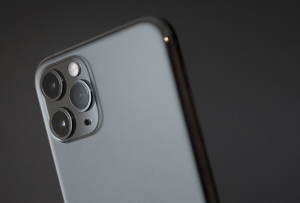
Malicious software, also called malware, refers to any program or code engineered to harm or exploit computer systems, networks and devices. It affects your phone’s functionality, especially if you jailbreak your device—that is, opening your iOS to additional features, apps, and themes.
The risks associated with a malware infection can range from poor device performance to stolen data. Cybercriminals typically use it to extract data—from financial data and healthcare records to emails and passwords—that they can leverage over victims for financial gain.
Thanks to their closed ecosystem, built-in security features, and strict policies on third-party apps, Apple devices tend to be generally resilient against malware infections. It’s important to note, however, that they’re not completely without vulnerabilities.
Read on to learn how you can detect malware on your iPhone and how to remove these infections so you can get back to enjoying your digital activities.
While traditional self-replicating viruses are rare on iPhones, malware is a genuine threat for Apple devices. Malware typically enters through links in deceptive texts or emails or through downloaded, unvetted apps rather than system-wide infection. These are some types of malware that could infect your iPhone:
To keep you safe against malware and other threats, Apple engineers the iPhone with multiple security layers, including:
Together, these features create a highly secure environment for iPhones. However, this robust shield does not eliminate all risks, as threats can still bypass these defenses through phishing scams or by tricking a user into installing a malicious configuration profile.
If your iPhone is exhibiting these odd activities listed below, a manual scan is your first point of order. These quick actions are free to do as they are already integrated into your device.
The disadvantage of doing a manual scan is that it requires effort. In addition, it does not detect sophisticated malware, and only identifies symptoms rather than root causes.
If your iPhone persistently exhibits any of the red flags above despite your quick actions, you may have to investigate using a third-party security app to find the threats that manual checks don’t catch.
Compared with manual or built-in scans, third-party solutions like McAfee Mobile Security offer automated, comprehensive malware scans by detecting a wider range of threats before they enter your digital space. While available at a premium, third-party security suites offer great value as they include full-scale protection that includes a safe browsing feature to protect your digital life and a virtual private network (VPN) for a more secure internet connection.
If the scan confirms the presence of malware on your iPhone, don’t worry. There’s still time to protect yourself and your data. Below is an action plan you can follow to remove malware from your device.
In many cases, hackers exploit outdated versions of iOS to launch malware attacks. If you don’t have the latest version of your operating system, it’s a good idea to update your iOS immediately to close this potential vulnerability. To do this, go to Settings > General > Software Update and follow the instructions to update your iPhone.
It might sound simple, but restarting your device can fix certain issues. The system will restart on its own when updating the iOS. If you already have the latest version, restart your iPhone now.
If updating the iOS and restarting your device didn’t fix the issue, try clearing your phone’s browsing history and data. If you’re using Safari, go to Settings > Clear History and Website Data > Clear History and Data. Keep in mind that the process is similar for Google Chrome and most other popular web browsers.
Malicious software, such as spyware and ransomware, often end up on phones by masquerading as legitimate apps. To err on the side of caution, delete any apps that you don’t remember downloading or installing.
The option to restore to a previous backup is one of the most valuable features found on the iPhone and iPad. This allows you to restore your device to an iCloud backup version that was made before the malware infection. Go to Settings > General > Transfer or Reset iPhone > Erase All Content and Settings > Restore from iCloud Backup.
A factory reset should be your last resort when other removal methods have failed, as it is a complete data wipe. That means it will erase all content and settings, including any malicious apps, profiles, or files, returning the software to its original, out-of-the-box state. That’s why it’s crucial to back up your essential data such as photos and contacts first. Also, remember to restore to an iCloud backup version *before* the malware infection to avoid reintroducing the infection. For the highest level of security, set the iPhone up as new and manually redownload trusted apps from the App Store. When you are ready to reset, go to Settings > General > Transfer or Reset iPhone > Erase All Content and Settings > Set Up as New iPhone.
Spyware is designed to be sneaky, but it leaves subtle traces. Pay attention to your iPhone’s behavior, such as the camera or microphone unexpectedly activating as indicated by a green or orange dot in the status bar, sudden battery drain, or your device overheating for no reason. Another major red flag is a spike in data usage when you aren’t actively using your phone.
For a deeper look, do this 5-minute check to see which apps have accessed your data, camera, and microphone. Look for any activity that seems suspicious or that you don’t recall authorizing.
If you suspect your iPhone has been compromised, it’s important to act quickly. Here’s a step-by-step process to remove it, restore your privacy, and prevent future threats.
A common tactic used by scammers is the fake virus pop-up. These alarming messages appear while you are browsing, often using logos from Apple or other trusted companies, and claim your iPhone is infected. Their goal is to create panic, urging you to click a link, download a fake app, or call a fraudulent support number. Never interact with these pop-ups. Here’s a quick response plan when dealing with fake virus pop-up ads:
Never enter personal information, passwords, or payment details on a page that appears from a pop-up ad.
The best way to protect your iOS device is to avoid malware in the first place. Follow these security measures to safeguard your device:
Can my iPhone get a virus from opening an email?
Simply opening an email is very unlikely to infect your iPhone. However, clicking a malicious link or downloading an attachment from a phishing email can lead you to a harmful website or trick you into compromising your information. It’s the action you take, not opening the email itself, that creates the risk.
How do I know if a virus warning is real or fake?
Any pop-up in your browser that claims your iPhone has a virus is fake. Apple does not send notifications like this. These are scare tactics designed to trick you into clicking a link or calling a fake support number. The safest response is to close the browser tab and clear your browsing data.
Does my iPhone really need antivirus software?
It’s a misconception that iPhones are immune to all viruses. While Apple’s built-in security provides a strong defense, it doesn’t offer complete protection. Cybercriminals are increasingly using phishing, smishing, AI voice cloning, deepfake videos and other social engineering methods to target iPhone users. A comprehensive security app provides layered protection beyond the iOS integrated security. Think of it as adding a professional security guard to already-strong walls.
What is the best way to check my iPhone for a virus or malware for free?
You can perform manual checks for free by looking for suspicious apps, checking for unusual battery drain and data usage, and reviewing your App Privacy Report. While helpful for spotting obvious issues, these manual checks aren’t foolproof. A dedicated security app offers a more reliable and thorough analysis.
Can an iPhone get malware without jailbreaking it?
Yes. While jailbreaking significantly increases the risk, malware can still infect a non-jailbroken iPhone. This typically happens through sophisticated phishing attacks, installing malicious configuration profiles from untrusted sources, or, in very rare cases, by exploiting an unknown vulnerability in iOS, known as a “zero-day” attack.
Is an iPhone malware scan truly necessary?
Given the value of the personal data on our phones, a regular malware scan provides significant peace of mind. A reputable security app can identify vulnerabilities you might miss, such as outdated software or risky system settings, helping you maintain a strong security posture.
Keeping your iPhone secure from malware is an achievable goal that puts you in control of your digital safety. By combining smart habits with powerful security tools, you can confidently protect your personal information from emerging threats.
McAfee is committed to empowering you with the resources and protection needed to navigate the online world safely. McAfee Mobile Security provides full protection against various types of malware targeting the Apple ecosystem. With safe browsing features, a secure VPN, and antivirus software, McAfee Security for iOS delivers protection against emerging threats, so you can continue to use your iPhone with peace of mind. Download the McAfee Mobile Security app today and get all-in-one protection.
The post A Guide to Remove Malware From Your iPhone appeared first on McAfee Blog.

We use our smartphones for everything under the sun, from work-related communication to online shopping, banking transactions, and social media. For this reason, our phones store a lot of personal data, including contacts, account details, and bank account logins.
High online usage also makes your devices vulnerable to viruses, a type of malware that replicate themselves and spread throughout the entire system. They can affect your phone’s performance or, worse, compromise your sensitive information so that hackers can benefit monetarily.
In this article, we will give you a rundown of viruses that can infect your phone and how you can identify and eliminate them. We will also provide some tips for protecting your phone from viruses in the first place.
iPhones and Android devices run on different operating systems, hence differences in how they resist viruses and how these affect each system.
While iOS hacks can still happen, Apple’s operating system is reputed to be highly resistant from viruses because of its design. By restricting interactions between apps, Apple’s operating system limits the movement of a virus across the device. However, if you jailbreak your iPhone or iPad to unlock other capabilities or install third-party apps, then the security restrictions set by Apple’s OS won’t work. This exposes your iPhone and you to vulnerabilities that cybercriminals can exploit.
Android phones, while also designed with cybersecurity in mind, rely on open-source code, making them an easier target for hackers. Additionally, giving users the capability to install third-party apps from alternative app stores such as the Amazon or Samsung Galaxy app stores makes Android devices open to viruses.
Cybercriminals today are sophisticated and can launch a variety of cyberattacks on your smartphone. Some viruses that can infect your phone include:
Ultimately, contracting a virus on your phone or computer comes down to your browsing and downloading habits. These are the most common ways it could happen:
Now that you know how your phone could be infected by a virus, look out for these seven signs that occur when malicious software is present:
Most pop-up ads don’t carry viruses but are only used as marketing tools. However, if you find yourself closing pop-up ads more often than usual, it might indicate a virus on your phone. These ads might be coming from apps in your library that you didn’t install. In this case, uninstall them immediately as they tend to carry malware that’s activated when the app is opened or used.
When you accidentally download apps that contain malware, your device has to work harder to continue functioning. Since your phone isn’t built to support malware, there is a good chance it will overheat.
If your contacts receive unsolicited scam emails or messages on social media from your account, especially those containing suspicious links, a virus may have accessed your contact list. It’s best to let all the recipients know that your phone has been hacked so that they don’t download any malware themselves or forward those links to anybody else.
An unusually slow-performing device is a hint of suspicious activity on your phone. The device may be slowing down because it is working harder to support the downloaded virus. Alternatively, unfamiliar apps might be taking up storage space and running background tasks, causing your phone to run slower.
Are you finding credit card transactions in your banking statements that you don’t recognize? It could be an unfamiliar app or malware making purchases through your account without your knowledge.
A sudden rise in your data usage or phone bill can be suspicious. A virus might be running background processes or using your internet connection to transfer data out of your device for malicious purposes.
An unusually quick battery drain may also cause concern. Your phone will be trying to meet the energy requirements of the virus, so this problem is likely to persist for as long as the virus is on the device.
You may have an inkling that a virus resides in your phone, but the only way to be sure is to check. An easy way to do this is by downloading a trustworthy antivirus app that will prevent suspicious apps from attaching themselves to your phone and secures any public connections you might be using.
Another way to check your phone is to follow these step-by-step processes, depending on the type of phone you use:
Once you have determined that a virus is present on your iPhone or Android device, there are several things you can do.
Caring for your phone is a vital practice to protect your information. Follow these tips to stay safe online and help reduce the risk of your phone getting a virus.
You have come to heavily rely on your smartphones for many online activities and storage of much of your personal data, including contacts, account details, and bank account logins. This puts your devices at high risk of being infected by viruses that impact not just your phone’s performance but also of being compromised by cybercriminals.
To help you protect your device and personal information, the award-winning McAfee Mobile Security solution regularly scans for threats transmitted through suspicious links in text messages, emails or downloads, and blocks them in real time. McAfee Mobile Security is a reputable security application that filters risky emails and phishing attempts so your inbox stays secure, while providing a secure virtual private network. It is also capable of spotting deepfake videos so you can stay ahead of misinformation. With McAfee, you can rest easy knowing your mobile phone is protected from the latest cyberthreats.
The post 7 Signs Your Phone Has a Virus and What You Can Do appeared first on McAfee Blog.
Cybercriminals are getting smarter. They’re now using a development toolkit called .NET MAUI to create fake apps that look and feel like the real thing—banking apps, dating apps, and even social media. But instead of helping you, these apps secretly steal your private info.
We break down the full research from McAfee Labs here:
.NET MAUI is a tool used by developers to build apps that work on many devices—like phones, tablets, and computers—all from one set of code.
That’s great for app creators. But now, hackers are using it too. While McAfee is able to detect this malware, the decision to build with .NET MAUI helps hide their dangerous code from most antivirus software. Think of it like a thief wearing an invisibility cloak—unless you’re really looking, you won’t see them.
Hackers are creating apps that look like they’re from real companies. For example, one fake app pretended to be IndusInd Bank, asking users to enter sensitive information like:
Once you hit submit, that info goes straight to the hacker’s server.

Figure 1. Fake IndusInd Bank app’s screen requesting user information
Normal Android apps have code in a format security tools can scan. These fake apps hide their code in binary files so it can’t be easily detected. That lets them stay on your phone longer—stealing quietly in the background.
In another case, hackers made an app that pretended to be a social media platform. This one targeted Chinese-speaking users and was even trickier than the fake bank app.
Here’s what it did:
And instead of using regular internet traffic, it sent stolen data through secret encrypted channels—so even if someone intercepted it, they couldn’t read it.

Figure 2. Various fake apps using the same technique
These apps aren’t in the Google Play Store. Instead, hackers are sharing them on:
So if someone sends you a link to a cool new app that’s not from the Play Store—be extra careful.
Here are a few easy ways to stay safe:
Hackers are getting creative, but you can stay one step ahead. These new .NET MAUI-based threats are sneaky—but they’re not unstoppable.
With smart habits and the right tools, you can keep your phone and your personal info safe. Want real-time protection on your phone? Download McAfee+ and get ahead of the latest threats.
The post New Android Malware Sneaks Past Security by Pretending to Be Real Apps appeared first on McAfee Blog.

Social media connects us to friends, trends, and news in real time—but it also opens the door to scammers looking to exploit trust and curiosity. From fake giveaways to impersonation scams, fraudsters use sophisticated tactics to trick users into handing over personal information, money, or access to their accounts.
Even the most internet-savvy users can fall victim to these deceptive schemes. That’s why it’s crucial to recognize the red flags before it’s too late. Whether it’s a DM from a “friend” in trouble, a deal that seems too good to be true, or a sudden request to verify your account, scammers prey on urgency and emotion to pull you in.
Here’s a look at some of the most common social media scams—and how you can stay one step ahead to protect yourself and your accounts.
Fraudsters use various tactics to lure unsuspecting users into their schemes, including:
Recognizing these red flags can help you stay safe:
Follow these precautions to reduce your risk of falling victim:
If you suspect you’ve fallen victim to a social media scam, take immediate action:
Social media scams are becoming more sophisticated, but you can protect yourself by staying informed and cautious.
Always verify messages, be skeptical of too-good-to-be-true offers, and use strong security measures to safeguard your accounts.
By recognizing these scams early, you can avoid financial loss and keep your personal information safe online.
McAfee helps protect you from online threats with advanced security tools, including identity monitoring, safe browsing features, and real-time malware protection. Stay one step ahead of scammers with trusted cybersecurity solutions.
The post The 9 Most Common Social Media Scams—and How to Spot Them Before It’s Too Late appeared first on McAfee Blog.

Authored by Anuradha, Sakshi Jaiswal
In 2024, scams in India have continued to evolve, leveraging sophisticated methods and technology to exploit unsuspecting individuals. These fraudulent activities target people across demographics, causing financial losses and emotional distress. This blog highlights some of the most prevalent scams this year, how they operate, some real-world scenarios, tips to stay vigilant and what steps to be taken if you become a victim.

This blog covers the following scams:
Scam Tactics:
Fraudsters on WhatsApp employ deceptive tactics to steal personal information, financial data, or gain unauthorized access to accounts. Common tactics include:
Case 1: In the figure below, a user is being deceived by a message originating from the +244 country code, assigned to Angola. The message offers an unrealistic investment opportunity promising a high return in just four days, which is a common scam tactic. It uses pressure and informal language, along with a link for immediate action.
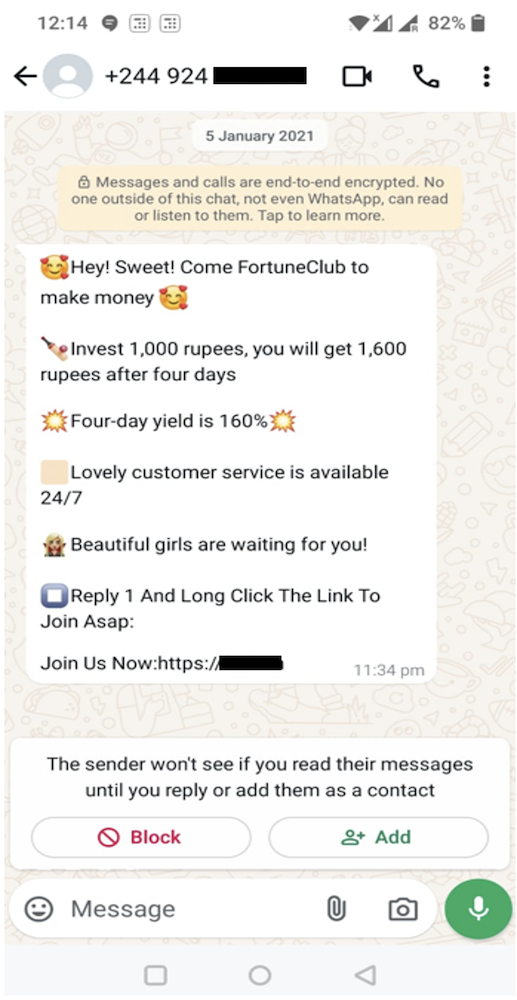
Case 2: In the figure below, a user is being deceived by a message originating from the +261 country code, assigned to Madagascar. The message claims that you have been hired and asks you to click a link to view the offer or contact the sender which is a scam.
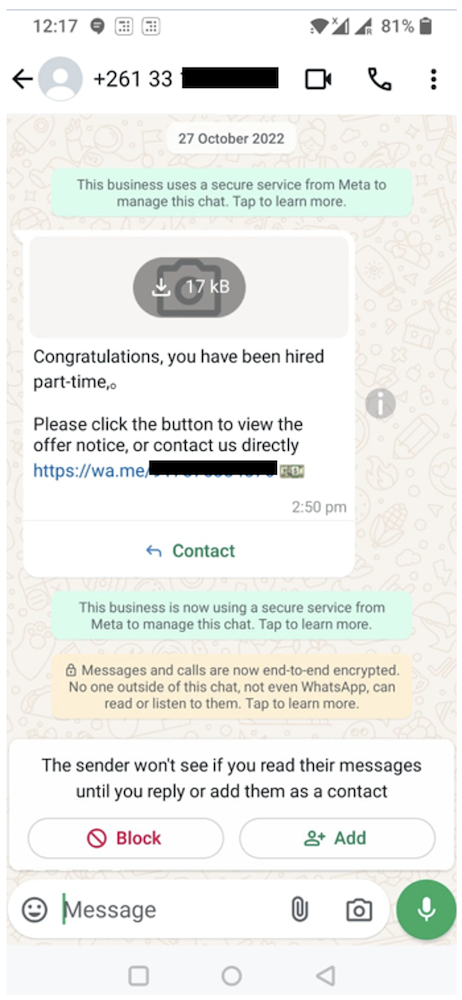
Case 3: In the figure below, a user is being deceived by a message originating from the +91 country code, assigned to India. Scammers may contact you, posing as representatives of a legitimate company, offering a job opportunity. The recruiter offers an unrealistic daily income (INR 2000–8000) for vague tasks like searching keywords, which is suspicious. Despite requests, they fail to provide official company details or an email ID, raising credibility concerns. They also ask for personal information prematurely, a common red flag.

Case 4: In the figure below, a user is being deceived by a message originating from the +84 country code, assigned to Vietnam. The offer to earn money by watching a video for just a few seconds and providing a screenshot is a common tactic used by scammers to exploit individuals. They may use the link to gather personal information, or your action could lead to phishing attempts.
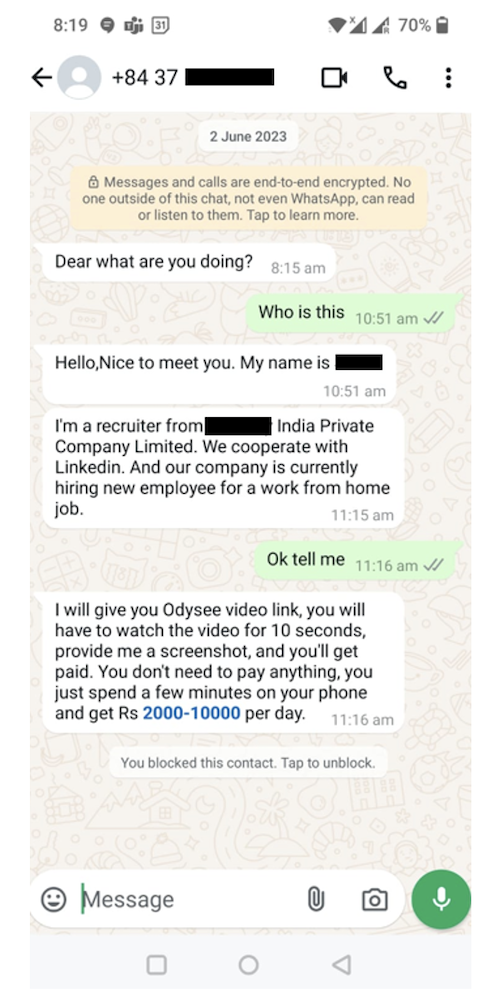
Case 5: In the figure below, a user is being misled by a message originating from the country codes +91, +963, and +27, corresponding to India, Syria, and South Africa, respectively. The message claims to offer a part-time job with a high salary for minimal work, which is a common tactic used by scammers to lure individuals. The use of popular names like “Amazon” and promises of easy money are red flags. The link provided might lead to phishing attempts or data theft. It’s important not to click on any links, share personal details, or respond to such unsolicited offers.
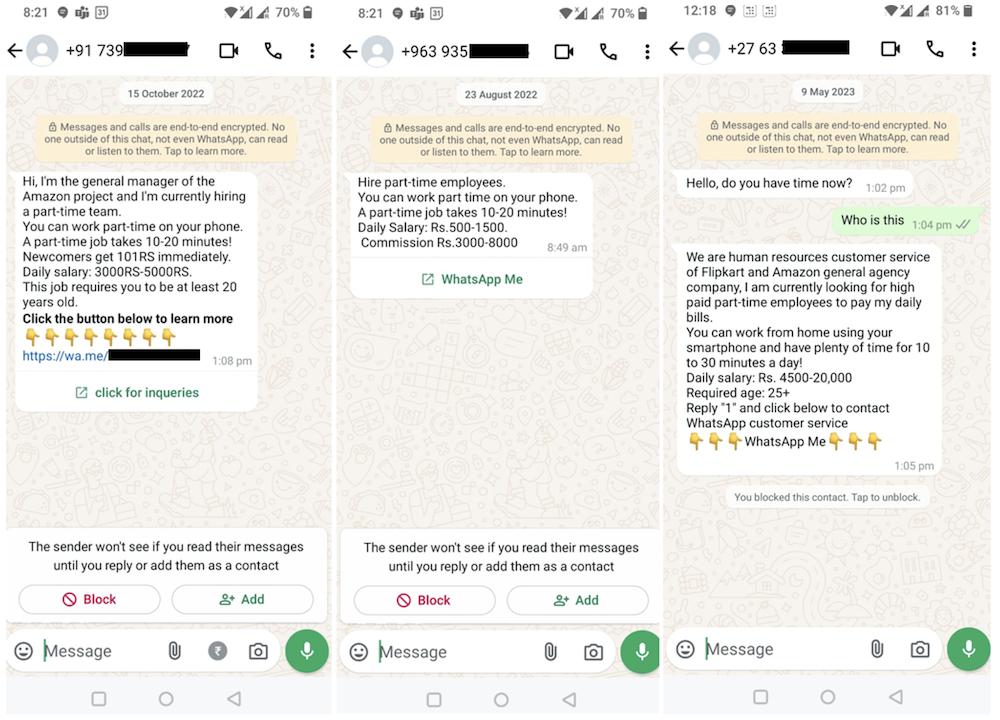
Case 6: The messages encourage you to post fake 5-star reviews for businesses in exchange for a small payment, which is unethical and often illegal. Scammers use such tactics to manipulate online ratings, and the provided links could lead to phishing sites or malware. Avoid engaging with these messages, clicking on the links, or participating in such activities.
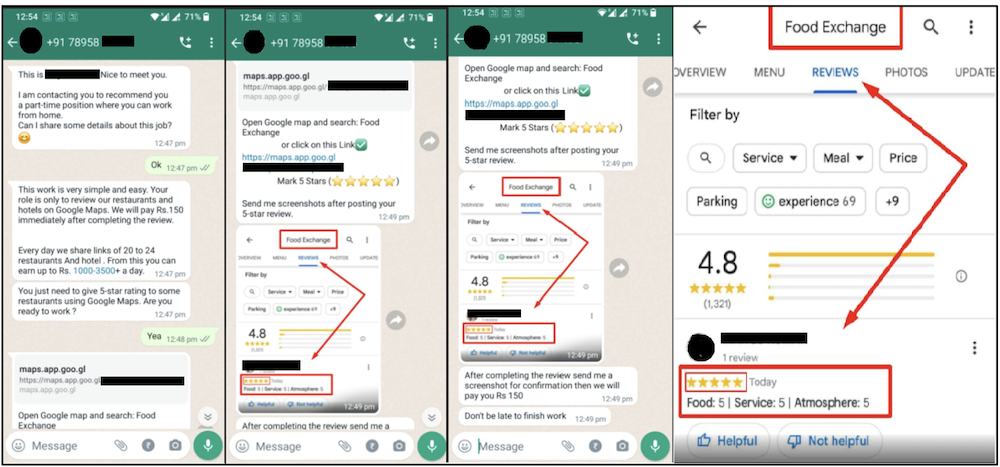
How to Identify WhatsApp Scams:
Impact:
Prevention:

Scam Tactics:
How to Identify Instant Loan Scam:

Impact:
Prevention:
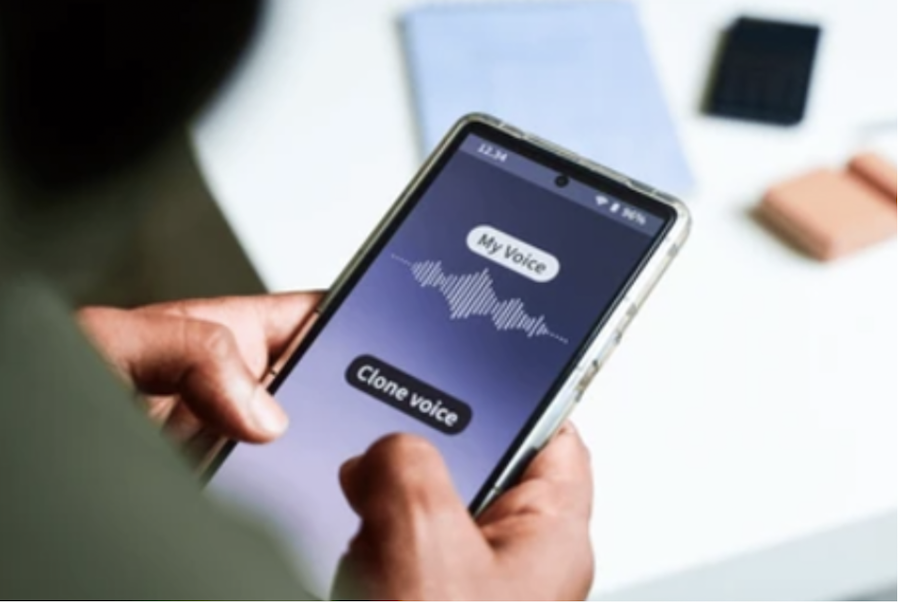
Voice-cloning scams use advanced AI technology to replicate the voices of familiar people, such as friends, family members, or colleagues, to manipulate victims into transferring money or providing sensitive information.
Scam Tactics:
How to Identify AI Voice-Cloning Scams:
Impact:
Prevention

Scam Tactics
Scammers use various methods to deceive victims into revealing credit card information or making unauthorized payments:
How to identify Credit card scam:
Impact:
Prevention:

Scam Tactics:
In fake delivery scams, fraudsters pose as delivery services to trick you into providing personal information, card details, or payment. Common tactics include:
How to Identify Fake Delivery Scams:
Impact:
Prevention:

Scam Tactics:
Scammers pose as police officers or government officials, accusing victims of being involved in illegal activities like money laundering or cybercrime. They intimidate victims by threatening arrest or legal action unless immediate payment is made to “resolve the matter.”
How to Identify Digital Arrest Scam:
Impact: Daily losses from such scams run into lakhs, as victims panic and transfer money or provide sensitive information under pressure.
Prevention:
What to Do if You Fall Victim
If you’ve fallen victim to any of the mentioned scams—Digital Arrest Scam, Instant Loan Scam, Voice Cloning Scam, WhatsApp Scam, Fake Delivery Scam or Credit Card Scam—it’s important to take immediate action to minimize damage and protect your finances and personal information. Here are common tips and steps to follow for all these scams:
As scams in India continue to grow in number and sophistication, it is crucial to raise awareness to protect individuals and businesses from falling victim to these fraudulent schemes. Scams such as phishing, fake job offers, credit card scams, loan scams, investment frauds and online shopping frauds are increasingly targeting unsuspecting victims, causing significant financial loss and emotional harm.
By raising awareness of scam warning signs and encouraging vigilance, we can equip individuals to make safer, more informed decisions online. Simple precautions, such as verifying sources, being cautious of unsolicited offers, and safeguarding personal and financial information, can go a long way in preventing scams.
It is essential for both individuals and organizations to stay informed and updated on emerging scam tactics. Through continuous awareness and proactive security measures, we can reduce the impact of scams, ensuring a safer and more secure digital environment for everyone in India.
The post Rising Scams in India: Building Awareness and Prevention appeared first on McAfee Blog.

McAfee threat researchers have identified several consumer brands and product categories most frequently used by cybercriminals to trick consumers into clicking on malicious links in the first weeks of this holiday shopping season. As holiday excitement peaks and shoppers hunt for the perfect gifts and amazing deals, scammers are taking advantage of the buzz. The National Retail Federation projects holiday spending will reach between $979.5 and $989 billion this year, and cybercriminals are capitalizing by creating scams that mimic the trusted brands and categories consumers trust. From October 1 to November 12, 2024, McAfee safeguarded its customers from 624,346 malicious or suspicious URLs tied to popular consumer brand names – a clear indication that bad actors are exploiting trusted brand names to deceive holiday shoppers.
McAfee’s threat research also reveals a 33.82% spike in malicious URLs targeting consumers with these brands’ names in the run-up to Black Friday and Cyber Monday. This rise in fraudulent activity aligns with holiday shopping patterns during a time when consumers may be more susceptible to clicking on offers from well-known brands like Apple, Yeezy, and Louis Vuitton, especially when deals seem too good to be true – pointing to the need for consumers to stay vigilant, especially with offers that seem unusually generous or come from unverified sources.
McAfee threat researchers have identified a surge in counterfeit sites and phishing scams that use popular luxury brands and tech products to lure consumers into “deals” on fake e-commerce sites designed to appear as official brand pages. While footwear and handbags were identified as the top two product categories exploited by cybercrooks during this festive time, the list of most exploited brands extends beyond those borders:
By mimicking trusted brands like these, offering unbelievable deals, or posing as legitimate customer service channels, cybercrooks create convincing traps designed to steal personal information or money. Here are some of the most common tactics scammers are using this holiday season:
With holiday shopping in full swing, it’s essential for consumers to stay one step ahead of scammers. By understanding the tactics cybercriminals use and taking a few precautionary measures, shoppers can protect themselves from falling victim to fraud. Here are some practical tips for safe shopping this season:
McAfee’s threat research team analyzed malicious or suspicious URLs that McAfee’s web reputation technology identified as targeting customers, by using a list of key company and product brand names—based on insights from a Potter Clarkson report on frequently faked brands—to query the URLs. This methodology captures instances where users either clicked on or were directed to dangerous sites mimicking trusted brands. Additionally, the team queried anonymized user activity from October 1st through November 12th.
The image below is a screenshot of a fake / malicious / scam site: Yeezy is a popular product brand formerly from Adidas found in multiple Malicious/Suspicious URLs. Often, they present themselves as official Yeezy and/or Adidas shopping sites.

The image below is a screenshot of a fake / malicious / scam site: The Apple brand was a popular target for scammers. Many sites were either knock offs, scams, or in this case, a fake customer service page designed to lure users into a scam.
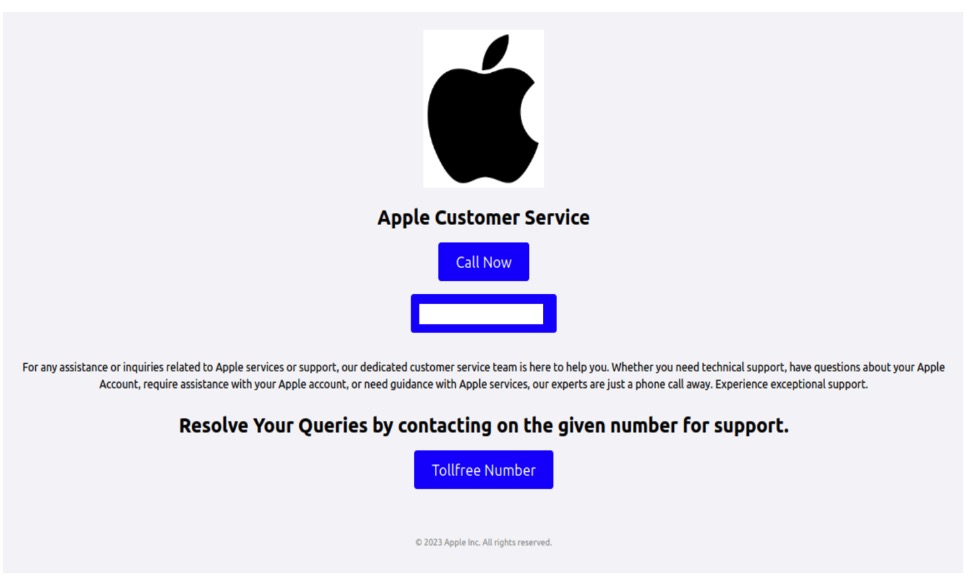
The image below is a screenshot of a fake / malicious / scam site: This particular (fake) Apple sales site used Apple within its URL and name to appear more official. Oddly, this site also sells Samsung Android phones.

The image below is a screenshot of a fake / malicious / scam site: This site, now taken down, is a scam site purporting to sell Nike shoes.

The image below is a screenshot of a fake / malicious / scam site: Louis Vuitton is a popular brand for counterfeit and scams. Particularly their handbags. Here is one site that was entirely focused on Louis Vuitton Handbags.

The image below is a screenshot of a fake / malicious / scam site: This site presents itself as the official Louis Vuitton site selling handbags and clothes.

The image below is a screenshot of a fake / malicious / scam site: This site uses too-good-to-be-true deals on branded items including this Louis Vuitton Bomber jacket.

The image below is a screenshot of a fake / malicious / scam site: Rolex is a popular watch brand for counterfeits and scams. This site acknowledges it sells counterfeits and makes no effort to indicate this on the product.

The post This Holiday Season, Watch Out for These Cyber-Grinch Tricks Used to Scam Holiday Shoppers appeared first on McAfee Blog.

Two-step verification, two-factor authentication, multi-factor authentication…whatever your social media platform calls it, it’s an excellent way to protect your accounts.
There’s a good chance you’re already using multi-factor verification with your other accounts — for your bank, your finances, your credit card, and any number of things. The way it requires an extra one-time code in addition to your login and password makes life far tougher for hackers.
It’s increasingly common to see nowadays, where all manner of online services only allow access to your accounts after you’ve provided a one-time passcode sent to your email or smartphone. That’s where two-step verification comes in. You get sent a code as part of your usual login process (usually a six-digit number), and then you enter that along with your username and password.
Some online services also offer the option to use an authenticator app, which sends the code to a secure app rather than via email or your smartphone. Authenticator apps work much in the same way, yet they offer three unique features:
Google, Microsoft, and others offer authenticator apps if you want to go that route. You can get a good list of options by checking out the “editor’s picks” at your app store or in trusted tech publications.
Whichever form of authentication you use, always keep that secure code to yourself. It’s yours and yours alone. Anyone who asks for that code, say someone masquerading as a customer service rep, is trying to scam you. With that code, and your username/password combo, they can get into your account.
Passwords and two-step verification work hand-in-hand to keep you safer. Yet not any old password will do. You’ll want a strong, unique password. Here’s how that breaks down:
Now, with strong passwords in place, you can get to setting up multi-factor verification on your social media accounts.
When you set up two-factor authentication on Facebook, you’ll be asked to choose one of three security methods:
And here’s a link to the company’s full walkthrough: https://www.facebook.com/help/148233965247823
When you set up two-factor authentication on Instagram, you’ll be asked to choose one of three security methods: an authentication app, text message, or WhatsApp.
And here’s a link to the company’s full walkthrough: https://help.instagram.com/566810106808145
And here’s a link to the company’s full walkthrough: https://faq.whatsapp.com/1920866721452534
And here’s a link to the company’s full walkthrough: https://support.google.com/accounts/answer/185839?hl=en&co=GENIE.Platform%3DDesktop
1. TapProfileat the bottom of the screen.
2. Tap the Menu button at the top.
3. Tap Settings and Privacy, then Security.
4. Tap 2-step verification and choose at least two verification methods: SMS (text), email, and authenticator app.
5. Tap Turn on to confirm.
And here’s a link to the company’s full walkthrough: https://support.tiktok.com/en/account-and-privacy/personalized-ads-and-data/how-your-phone-number-is-used-on-tiktok
The post How to Protect Your Social Media Passwords with Multi-factor Verification appeared first on McAfee Blog.

So, what does your phone know about you? Taken all together it knows plenty — sometimes in ways that feel like your phone is watching you.
It all comes down to the data that courses through your phone and your apps, along with a phone’s built-in tracking capabilities. Indeed, your phone certainly knows plenty about you. And companies keep tabs on that. Here’s how…
The apps on our phones entertain us, inform us, and help us shop. Many of them also track our activities and location — and then sell or share that info with third parties. From there, that info can end up with data brokers who sell that info to anyone who’ll pay. That includes advertisers, spammers, insurance companies, hackers, law enforcement, private investigators, and so on. It’s all legal, and it’s all part of a multi-billion-dollar industry worldwide.
Still, you can take charge of your privacy amidst all this data and info gathering. Several steps can reduce what your phone collects and shares with others.
For starters, though, let’s look at several of the things your phone knows about you.
Unless you’ve turned it off completely, your phone can track you in several ways with several degrees of accuracy:
GPS: The Global Positioning System, or GPS as many of us know it, is a system of satellites run by the U.S. government for navigation purposes. First designed for national defense, the system became available for public use in the 1980s. It’s highly accurate, to anywhere between nine to 30 feet depending on conditions and technology used, making it one of the strongest tools for determining a phone’s location. This is what powers location services on cell phones, and thus can help an app recommend a great burger joint nearby.
Cell towers: Cell phone providers can track a phone’s location by the distance it is to various cell phone towers and by the strength of its signal. The location info this method provides is a bit coarser than GPS, providing results that can place a phone within 150 feet. It’s most accurate in urban areas with high densities of cell phone towers, although it does not always work well indoors as some buildings can weaken or block cell phone signals.
One of the most significant public benefits of this method is that it automatically routes emergency service calls (like 911 in the U.S.) to the proper local authorities without any guesswork from the caller.
Public Wi-Fi: Larger tech companies and internet providers will sometimes provide free public Wi-Fi hotspots that people can tap into at airports, restaurants, coffeehouses, and such. It’s a nice convenience, but connecting to their Wi-Fi might share a phone’s MAC address, a unique identifier for connected devices, along with other identifiers on the smartphone.
Taken together, this can allow the Wi-Fi hosting company to gather location and behavioral data while you use your phone on their Wi-Fi network.
Bluetooth: Like with public Wi-Fi, companies can use strategically placed Bluetooth devices to gather location info as well. If Bluetooth is enabled on a phone, it will periodically seek out Bluetooth-enabled devices to connect to while the phone is awake. This way, a Bluetooth receiver can then capture that phone’s unique MAC address. This provides highly exact location info to within just a few feet because of Bluetooth’s short broadcast range.
In the past, we’ve seen retailers use this method to track customers in their physical stores to better understand their shopping habits. However, newer phones often create dummy MAC addresses when they seek out Bluetooth connections, which helps thwart this practice.
Certain apps pair location info with other info they collect while you use that app. In some cases, an app shares that precise combination of info with third parties. (It all depends on the terms in the user agreement you accepted once you installed it.)
What does that look like in the real world? Third parties might know:
Those are just a few examples of many.
Just to emphasize what we said above, not every app sells shares or sells your info to third parties. However, that gets into the complicated nature of user agreements. The language that covers what’s collected, for what reasons, what’s done with it, and who it’s shared can be tough to tease out because it’s often written in some form of legalese.
Broadly though, apps need to request permission to access location tracking services. In the past, we’ve seen some sketchy apps request location permissions even though they have no reason to. Examples include coupon apps, wallpaper apps, productivity apps, and plenty of games too. When apps like those ask for permission to access location tracking services, raises a red flag that your privacy is in jeopardy.
Depending on what apps and services you use, your phone might know a lot about your health. That can include range of info, as apps can track things like step counts, vital signs, and menstrual cycles. Other apps manage health conditions or work as symptom checkers. In all, this data can get very private. Unfortunately, sometimes that data winds up in the hands of third parties.
With that, we’ve seen cases where people’s medical info was shared without their knowledge by medical apps and services.
In April 2024, The U.S. Federal Trade Commission (FTC) ruled against an online mental health service that “disclosed consumers’ sensitive personal health information and other sensitive data to third parties for advertising purposes…”[i] Also according to the complaint, the company gave third parties personal data about its users including names, medical and prescription histories, pharmacy and health insurance info, and other health info.
Also in April 2024, U.S. healthcare provider Kaiser Permanente disclosed that more than 13 million people had some of their personal data shared by third parties via tracking technologies on its websites and apps. Companies such as Microsoft (Bing), Google, and X (Twitter) were all named.[ii] That info possibly included how people interacted with and navigated through their website or mobile app, along with search terms used in Kaiser’s health encyclopedia.
So, is someone on the other end of your smartphone listening to your recordings when you use Siri or Google Assistant? Possibly, yes. Companies make constant improvements to their devices and services, which may include the review of commands from users to make sure they are interpreted correctly. There are typically two types of review — machine and human. As the names suggest, a machine review is a digital analysis. Human reviews entail someone listening to and evaluating a recorded command or reading and evaluating a transcript of a written command.
However, several manufacturers let you opt out of those reviews. In fact, you’ll find that they post a fair share of articles about this collection and review process, along with your choices for opting in or out as you wish:
Turn off your phone or switch to Airplane Mode. Disconnect. Without a Wi-Fi or data connection, you can’t get tracked. While this makes you unreachable, it also makes you untraceable, which you might want to consider if you’d rather keep your whereabouts and travels to yourself for periods of time.
Turn off location services altogether. As noted above, your smartphone can get tracked by other means, yet disabling location services in your phone settings shuts down a primary avenue of location data collection. Note that your maps apps won’t offer directions, and your restaurant app won’t point you toward that tasty burger when location services are off, but you’ll be more private than with them turned on.
Provide permissions on an app-by-app basis. Another option is to go into your phone settings and enable location services for specific apps in specific cases. For example, you can set your map app to enable location services only while in use. For other apps, you can disable location services entirely. Yet another option is to have the app ask for permissions each time. Note that this is a great way to discover if apps have defaulted to using location services without your knowledge when you installed them.
On an iPhone, you can find this in Settings -> Privacy & Security -> Location Services. On an Android, go to Settings -> Locations -> App Locations Permissions.
Turn off app tracking. As you’ve seen, some apps will ask to track your activity and potentially share it with data brokers and other third parties. You can halt this by turning off app tracking. On an iPhone, go to Settings -> Privacy & Security -> Tracking and disable “Allow Apps to Request to Track.” On an Android phone, go to Settings -> Privacy and Security, then turn on “Do Not Track.”
And just as you can with location services, you can set apps to make tracking requests on an app-by-app basis. You’ll see it on the same screen that has the global “Do Not Track” option.
Opt yourself out of cell phone carrier ad programs. Different cell phone carriers have different user agreements, yet some might allow the carrier to share insights about you with third parties based on browsing and usage history. Opting out of these programs might not stop your cell phone carrier from collecting data about you, but it might prevent it from sharing insights about you with others.
To see if you take part in one of these programs, log into your account portal or app. Look for settings around “relevant advertising,” “custom experience,” or even “advertising,” and then figure out if these programs are worth it.
Delete old apps. And be choosy about new ones. Fewer apps mean fewer avenues of potential data collection. If you have old, unused apps, consider deleting them, along with the accounts and data associated with them. Our Online Account Cleanup Online Account Cleanup can make quick work of it. It scans for accounts you no longer use, shows how risky they are, and helps you delete them, along with your personal info. In all, breaches and leaks are a numbers game. The fewer you keep, the better, when it comes to protecting your personal info.
Remove your info from data broker sites. As we’ve seen, the personal info on your smartphone can wind up on data broker sites. And they’ll sell it to practically anyone. Our Personal Data Cleanup can help you remove your personal info from several of the sketchiest brokers out there. Running it periodically can help keep your info off those sites if it crops up again.
[i] https://www.ftc.gov/news-events/news/press-releases/2024/04/proposed-ftc-order-will-prohibit-telehealth-firm-cerebral-using-or-disclosing-sensitive-data?utm_source=govdelivery
[ii] https://www.hipaajournal.com/kaiser-permanente-website-tracker-breach-affects-13-4-million-individuals/
The post Every Step You Take, Every Call You Make: Is Your Phone Tracking You? appeared first on McAfee Blog.

With its built-in location services, your smartphone can point you to plenty of places. To the location of your vacation rental. To the quickest route around a traffic jam. And to a tasty burger. It’s a tremendous convenience. Yet, there’s a flip side. Your smartphone also tracks your location. Getting to know how your phone tracks you and how you can limit that tracking can make you far more private online.
The basic privacy issue with location services is this: many companies use your activities and apps as a way of gathering info on you. They might collect that info for their own purposes, and they might sell that info to third parties.
As to why some companies do that, the answer typically boils down to a handful of things. They will:
So, it’s a bit of a tradeoff. You might use an app to show you the closest Indian restaurant to your hotel — but depending on the user agreement for that app, the company behind it might collect your info for their own financial gain.
We can boil that down yet further. Sometimes what you gain in convenience you lose in privacy.
Let’s look at how smartphones track your movements and follow that up with ways you can limit that tracking.
Unless you’ve turned it off completely, your phone can track you in several ways with several degrees of accuracy:
GPS: The Global Positioning System, or GPS as many of us know it, is a system of satellites operated by the U.S. government for navigation purposes. First designed for national defense, the system became available for public use in the 1980s. It’s highly accurate, to anywhere between nine to 30 feet depending on conditions and technology used, making it one of the strongest tools for determining a phone’s location. This is what powers location services on cell phones, and thus can help an app recommend a great burger joint nearby.
Cell towers: Cell phone providers can track a phone’s location by the distance it is to various cell phone towers and by the strength of its signal. The location info this method provides is a bit coarser than GPS, providing results that can place a phone within 150 feet. It’s most accurate in urban areas with high densities of cell phone towers, although it does not always work well indoors as some buildings can weaken or block cell phone signals.
One of the most significant public benefits of this method is that it automatically routes emergency services calls (like 911 in the U.S.) to the proper local authorities without any guesswork from the caller.
Public Wi-Fi: Larger tech companies and internet providers will sometimes provide free public Wi-Fi hotspots that people can tap into at airports, restaurants, coffeehouses, and such. It’s a nice convenience, but connecting to their Wi-Fi might share a phone’s MAC address, a unique identifier for connected devices, along with other identifiers on the smartphone.
Taken together, this can allow the Wi-Fi hosting company to gather location and behavioral data while you use your phone on their Wi-Fi network.
Bluetooth: Like with public Wi-Fi, companies can use strategically placed Bluetooth devices to gather location info as well. If Bluetooth is enabled on a phone, it will periodically seek out Bluetooth-enabled devices to connect to while the phone is awake. This way, a Bluetooth receiver can then capture that phone’s unique MAC address. This provides highly accurate location info to within just a few feet because of Bluetooth’s short broadcast range.
In the past, we’ve seen retailers use this method to track customers in their physical stores to better understand their shopping habits. However, newer phones often create dummy MAC addresses when they seek out Bluetooth connections, which helps thwart this practice.
So, just to emphasize what we said above, not every app sells shares or sells your info to third parties. However, that gets into the complicated nature of user agreements. The language that covers what’s collected, for what reasons, what’s done with it, and who it’s shared with often finds itself buried in a wall of legalese.
Ultimately, it’s up to you to determine what your comfort level is in any kind of convenience in exchange for a loss of privacy. Everyone has their own comfort levels.
With that, you can take several steps to limit tracking on your smartphone to various degrees — and boost your privacy to various degrees as a result:
Turn off your phone or switch to Airplane Mode. Disconnect. Without a Wi-Fi or data connection, you can’t get tracked. While this makes you unreachable, it also makes you untraceable, which you might want to consider if you’d rather keep your whereabouts and travels to yourself for periods of time.
Turn off location services altogether. As noted above, your smartphone can get tracked by other means, yet disabling location services in your phone settings shuts down a primary avenue of location data collection. Note that your maps apps won’t offer directions and your restaurant app won’t point you toward that tasty burger when location services are off, but you’ll be more private than with them turned on.
Provide permissions on an app-by-app basis. Another option is to go into your phone settings and enable location services for specific apps in specific cases. For example, you can set your map app to enable location services only while in use. For other apps, you can disable location services entirely. Yet another option is to have the app ask for permissions each time. Note that this is a great way to discover if apps have defaulted to using location services without your knowledge when you installed them.
On an iPhone, you can find this in Settings -> Privacy & Security -> Location Services. On an Android, go to Settings -> Locations -> App Locations Permissions.
Delete old apps. And be choosy about new ones. Fewer apps mean fewer avenues of potential data collection. If you have old, unused apps, consider deleting them, along with the accounts and data associated with them.
Use a VPN. A VPN can make your time online more private and more secure by obscuring things like your IP address and by preventing snoops from monitoring your activity.
Turn off app tracking. As you’ve seen, some apps will ask to track your activity and potentially share it with data brokers and other third parties. You can halt this by turning off app tracking. On an iPhone, go to Settings -> Privacy & Security -> Tracking and disable “Allow Apps to Request to Track.” On an Android phone, go to Settings -> Privacy and Security, then turn on “Do Not Track.”
And just as you can with location services, you can set apps to make tracking requests on an app-by-app basis. You’ll see it on the same screen that has the global “Do Not Track” option.
Opt yourself out of cell phone carrier ad programs. Different cell phone carriers have different user agreements, yet some might allow the carrier to share insights about you with third parties based on browsing and usage history. Opting out of these programs might not stop your cell phone carrier from collecting data about you, but it might prevent it from sharing insights about you with others.
To see if you participate in one of these programs, log into your account portal or app. Look for settings around “relevant advertising,” “custom experience,” or even “advertising,” and then determine if these programs are of worth to you.
The post Location, Location, Location: Three Reasons It Matters for Your Smartphone appeared first on McAfee Blog.

What is malware? A dictionary-like definition is “malicious software that attacks computers, smartphones, and other connected devices.”
In fact, “malware” is a mash-up of “malicious software.” It describes any type of software or code specifically designed to exploit a connected device or network without consent. And, unsurprisingly, hackers design most of it for financial gain.
Think of malware as an umbrella term that covers an entire host of “bad stuff,” such as:
Spyware that tracks activity, like what you type and where you type it. (Think snooping on your bank account logins.
Ransomware that holds devices or the data on them hostage, that hackers only release for a price. (And even so, payment is no guarantee you’ll get back your access.)
Adware that serves up spammy ads on your device. (The hacker gets paid for the number of “impressions” the ads have. The more they show up on people’s devices, the more they get paid.)
Botnet software, that hijacks a device into a remote-controlled network of other devices. (These networks are used to shut down websites or even shut down large portions of the internet, just to mention two of the things they can do.)
Rootkit that attacks that give hackers remote-control access to a device. (And with that control, they can wage all manner of attacks — on the device and on other devices too.)
Viruses that modify the way a device and its apps function. Also, they can effectively bring a device or network to a grinding halt. (Yes, viruses are a subset of malware. They can copy, delete, and steal data, among other things.)
You might know malware by its more commonly used name — viruses.
There’s a pretty good reason why people commonly refer to malware as a “virus.” Viruses have been on our collective minds for some time.
Viruses have a long history. You could call it “the original malware.” And depending on how you define what a virus is, the first one took root in 1971 — more than 50 years ago. It was known as Creeper, and rather than being malicious in nature, the creator designed it to show how a self-replicating program could spot other devices on a network, transfer itself to them, and find yet more devices to repeat the process. Later, the same programmer who created a refined version of Creeper developed Reaper, a program that could remove the Creeper program. In a way, Reaper could be considered the first piece of antivirus software.[i]
From there, it wasn’t until the 1980s that malware started affecting the broader population, a time when computers became more commonplace in businesses and people’s homes.
At first, malware typically spread by infected floppy disks, much like the “Brain” virus in 1986. While recognized today as the first large-scale computer virus, its authors say they never intended it to work that way. Rather, they say they created Brain as an anti-piracy measure to protect their proprietary software from theft. However, Brain got loose. It went beyond their software and affected computers worldwide. Although not malicious or destructive in nature, Brain most certainly put the industry, businesses, and consumers on notice. Computer viruses were a thing.[ii]
Another piece of malware that got passed along via floppy disks was the “PC Cyborg” attack that targeted the medical research community in and around 1989. There, the malware would lie in wait until the user rebooted their computer for the 90th time and was presented with a digital ransom note.[iii]
An early example of ransomware – Source, Wikipedia
Upon that 90th boot, PC Cyborg encrypted the computer’s files, which would only get unencrypted if the victim paid a fee, making it the first documented form of ransomware.
Shortly thereafter, the internet started connecting computers, which opened millions of doors for hackers as people went online. Among the most noteworthy was 1999’s “Melissa” virus, which spread by way of infected email attachments and overloaded hundreds of corporate and governmental email servers worldwide.
It was quickly followed in 2000 by what’s considered among the most damaging malware to date — ILOVEYOU, which also spread by way of an attachment, this one posing as a love letter. Specifically, it was a self-replicating worm that installed itself on the victim’s computer where it destroyed some info and stole other info, then spread to other computers. One estimate put the global cost of ILOVEYOU at $10 billion. It further speculated that it infected 10% of the world’s internet-connected computers at the time.[iv]
With that history, it’s no surprise that anti-malware software is commonly called “antivirus.”
Antivirus forms a major cornerstone of online protection software. It protects your devices against malware through a combination of prevention, detection, and removal. Our antivirus uses AI to detect the absolute latest threats — and has for several years now.
Today, McAfee registers more than a million new malicious programs and potentially unwanted apps (PUA) each day, which contributes to the millions and millions already in existence. Now with the arrival of AI-powered coding tools, hackers can create new strains at rates unseen before.
That’s another reason why we use AI in our antivirus software. We use AI to protect against AI-created malware. It does so in three ways:
Once again, it’s important to remind ourselves that today’s malware is created largely for profit. Hackers use it to gain personal and financial info, either for their own purposes or to sell it for profit. The files you have stored on your devices have a street value. That includes tax returns, financial docs, payment info, and so on. Moreover, when you consider all the important things you keep on your devices, like your photos and documents, those have value too. Should you get caught up in a ransomware attack, a hacker puts a price tag on them for their return.
Needless to say, and you likely know this already, antivirus is essential for you and your devices.
You’ll find our AI-powered antivirus in all our McAfee+ plans. Better yet, our plans have dozens of protections that block the ways hackers distribute malware. To name just a few, our Text Scam Detector blocks links to suspicious sites that host malware and other attacks — and our Web Protection does the same for your browser. It also includes our industry-first online protection score that shows you just how safe you are, along with suggestions that can make you safer still. Together, our McAfee+ plans offer more than just antivirus. They protect your devices, your privacy, and your identity overall.
[i] https://www.historyofinformation.com/detail.php?entryid=2860
[ii] https://www.historyofinformation.com/detail.php?id=1676
[iii] https://www.theatlantic.com/technology/archive/2016/05/the-computer-virus-that-haunted-early-aids-researchers/481965/
[iv] https://www.forbes.com/sites/daveywinder/2020/05/04/this-20-year-old-virus-infected-50-million-windows-computers-in-10-days-why-the-iloveyou-pandemic-matters-in-2020
The post What is Malware? appeared first on McAfee Blog.

In my world of middle-aged mums (mams), Instagram is by far the most popular social media platform. While many of us still have Facebook, Instagram is where it all happens: messaging, sharing, and yes, of course – shopping!! So, when one of my gal pals discovers that her Instagram account has been hacked, there is understandably a lot of panic!
Believe it or not, Facebook is still hanging onto the top spot as the most popular social media platform with just over 3 billion active monthly users, according to Statista. YouTube comes in 2nd place with 2.5 billion users. Instagram and WhatsApp tie in 3rd place with 2 billion users each. Interestingly, TikTok has 1.5 billion users and is in 4th place – but watch this space, I say!
Despite Facebook having the most monthly users, it isn’t where the personal conversations and engagement take place. That’s Instagram’s sweet spot. Instagram messaging is where links are shared and real personal interaction occurs. In fact, a new report shows that Instagram accounts are targeted more than any other online account and makeup just over a quarter of all social media hacks. So, it makes sense why hackers would expend considerable energy in trying to hack Instagram accounts. They’ll have a much greater chance of success if they use a platform where there is an appetite and trust for sharing links and personal conversations.
But why do they want to get their hands on your account? Well, they may want to steal your personal information, scam your loyal followers by impersonating you, sell your username on the black market or even demand ransoms! Hacking Instagram is big business for professional scammers!!
So, you reach for your phone early one morning to do a quick scroll on Instagram before you start the day, but you can’t seem to log on. Mmmmm. You then see some texts from friends checking whether you have in fact become a cryptocurrency expert overnight. OK – something’s off. You then notice an email from Instagram notifying you that the email linked to your account has been changed. Looks like you’ve been hacked! But please don’t spend any time stressing. The most important thing is to take action ASAP as the longer hackers have access to your account, the greater the chance they can infiltrate your life and create chaos.
The good news is that if you act quickly and strategically, you may be able to get your account back. Here is what I suggest you do – fast!:
1. Change Your Password & Check Your Account
If you are still able to log in to your account then change your password immediately. And ensure it is a password you haven’t used anywhere else. Then do a quick audit of your account and fix any changes the hacker may have made eg remove access to any device you don’t recognise, any apps you didn’t install, and delete any email addresses that aren’t yours.
Next, turn on two-factor authentication (2FA) to make it harder for the hacker to get back into your account. This will take you less than a minute and is absolutely critical. Instagram will give you the option to receive the login code either via text message or via an authentication app. I always recommend the app in case you ever lose control of your phone.
But, if you are locked out of your account then move on to step 2.
2. Locate The Email From Instagram
Every time there is a change to your account details or some new login activity, Instagram will automatically send a message to the email address linked with the account
But there’s good news here. The email from Instagram will ask you if you in fact made the changes and will provide a link to secure your account in case it wasn’t you. Click on this link!! If you can access your account this way, immediately check that the only linked email address and recovery phone number are yours and delete anything that isn’t yours. Then change your password.
But if you’ve had no luck with this step, move on to step 3.
3. Request a Log-In Link
You can also ask Instagram to email or text you a login link. On an iPhone, you just need to select ‘forgot password?’ and on your Android phone, tap ‘get help logging in’. You will need to enter the username, email address, and phone number linked to your account.
No luck? Keep going…
4. Request a Security Code
If the login link won’t get you back in, the next step is to request a security code. Simply enter the username, email address, or phone number associated with your account, then tap on “Need more help?” Select your email address or phone number, then tap “Send security code” and follow the instructions.
5. Video Selfie
If you have exhausted all of these options and you’ve had no luck then chances are you have found your way to the Instagram Support Team. If you haven’t, simply click on the link and it will take you there. Now, if your hacked account contained pictures of you then you might just be in luck! The Support Team may ask you to take a video selfie to confirm who you are and that in fact you are a real person! This process can take a few business days. If you pass the test, you’ll be sent a link to reset your password.
So, you’ve got your Instagram account back – well done! But wouldn’t it be good to avoid all that stress again? Here are my top tips to make it hard for those hackers to take control of your Insta.
1. It’s All About Passwords
I have no doubt you’ve heard this before but it’s essential, I promise! Ensuring you have a complex and unique password for your Instagram account (and all your online accounts) is THE best way of keeping the hackers at bay. And if you’re serious about this you need to get yourself a password manager that can create (and remember) crazily complex and random passwords that are beyond any human ability to create. Check out McAfee’s TrueKey – a complete no-brainer!
2. Turn on Multifactor Authentication (MFA)
Multi-factor authentication adds another layer of security to your account making it that much harder for a hacker to get in. It takes minutes to set up and is essential if you’re serious about protecting yourself. It simply involves using a code to log in, in addition to your password. You can choose to receive the code via a text message or an authenticator app – always choose the app!
3. Choose How To Receive Login Alerts
Acting fast is the name of the game here so ensure your account is set up with your best contact details, so you receive login alerts ASAP. This can be the difference between salvaging your account and not. Ensure the alerts will be sent to where you are most likely to see them first so you can take action straight away!
4. Audit Any Third-Party Apps
Third-party apps that you have connected to your account could potentially be a security risk. So, only ever give third-party apps permission to access your account when absolutely necessary. I suggest taking a few minutes to disconnect any apps you no longer require to keep your private data as secure as possible.
Believe it or not, Instagram is not just an arena for middle-aged mums! I can guarantee that your teens will be on there too. So, next time you’re sharing a family dinner, why not tell them what you’re doing to prevent yourself from getting hacked? And if you’re not convinced they are listening? Perhaps remind them just how devastating it would be to lose access to their pics and their people. I am sure that might just work.
Till next time
Stay safe online!
Alex
The post My Instagram Has Been Hacked – What Do I Do Now? appeared first on McAfee Blog.

All day long, it’s almost always within arm’s reach. Your smartphone. And we rely on it plenty. That makes securing your phone so important. Good thing that some of the best tips for making your phone safer are also some of the easiest.
Here’s a quick rundown:
1. Lock your phone.
Locking your phone is one of the most basic smartphone security measures you can take. Trouble is, few of us do it. Our recent global research showed that only 56% of adults said that they protect their smartphone with a password, passcode, or other form of lock.[i] In effect, an unlocked phone is an open book to anyone who finds or steals a phone.
Setting up a lock screen is easy. It’s a simple feature found on iOS and Android devices. iPhones and Androids have an auto-lock feature that locks your phone after a certain period of inactivity. Keep this time on the low end, one minute or less, to help prevent unauthorized access.
We suggest using a six-digit PIN or passcode rather than using a gesture to unlock your phone. They’re more complex and secure. Researchers proved as much with a little “shoulder surfing” test. They looked at how well one group of subjects could unlock a phone after observing the way another group of subjects unlocked it.[ii]
2. Turn on “Find My Phone.”
Another powerful tool you have at your disposal is the Find My Phone feature made possible thanks to GPS technology. The “find my” feature can help you pinpoint your phone if your lost or stolen phone has an active data or Wi-Fi connection and has its GPS location services enabled. Even if the phone gets powered down or loses connection, it can guide you to its last known location.
Setting up this feature is easy. Apple offers a comprehensive web page on how to enable and use their “Find My” feature for phones (and other devices too). Android users can get a step-by-step walkthrough on Google’s Android support page as well.
3. Learn how to remotely track, lock or erase your phone.
In the event of your phone getting lost or stolen, a combination of device tracking, device locking, and remote erasing can help protect your phone and the data on it.
Different device manufacturers have different ways of going about it. But the result is the same — you can prevent others from using your phone, and even erase it if you’re truly worried that it’s in the wrong hands or gone for good. Apple provides iOS users with a step-by-step guide, and Google offers up a guide for Android users as well.
4. Back up your stuff in the cloud.
Thanks to cloud storage, you might be able to recover your photos, files, apps, notes, contact info, and more if your phone is lost or stolen. Android owners can learn how to set up cloud backup with Google Drive here, and iPhone users can learn the same for iCloud here.
5. Update your phone’s operating system and apps.
Keep your phone’s operating system up to date. Updates can fix vulnerabilities that hackers rely on to pull off their malware-based attacks — it’s another tried-and-true method of keeping yourself safer and your phone running great too.
The same goes for the apps on your phone. Ideally, set them up to update automatically so that you don’t have to take extra time to do it yourself. Also, look for opportunities to delete old apps and any data linked with them. Fewer apps on your phone means fewer vulnerabilities. And less data in fewer places can reduce your exposure to data breaches.
6. Stick with official app stores.
Legitimate app stores like Google Play and Apple’s App Store have measures in place that help ensure that apps are safe and secure. And for the malicious apps that sneak past these processes, Google and Apple are quick to remove them once discovered, making their stores that much safer. Meanwhile, third-party app stores might not have these measures in place. Further, they might be a front for hackers looking to spread mobile malware through malicious apps.
7. Go with a strong app recommendation.
Yet better than combing through user reviews yourself is getting a recommendation from a trusted source, like a well-known publication or from app store editors themselves. In this case, much of the vetting work has been done for you by an established reviewer. A quick online search like “best fitness apps” or “best apps for travelers” should turn up articles from legitimate sites that can suggest good options and describe them in detail before you download.
That’s not to say that you should overlook user reviews. Certainly, legitimate reviews can be a big help. Look closely at the listing, though. Check out the developer’s track record. Have they published several other apps with many downloads and good reviews? A legit app typically has quite a few reviews, whereas malicious apps may have only a handful of (phony) five-star reviews. Lastly, look for typos and poor grammar in both the app description and screenshots. They could be a sign that a hacker slapped the app together and quickly deployed it.
8. Keep an eye on app permissions.
Another way hackers weasel their way into your device is by getting permissions to access things like your location, contacts, and photos — and they’ll use sketchy apps to do it. So check and see what permissions the app is requesting. If it’s asking for way more than you bargained for, like a simple game wanting access to your camera or microphone, it might be a scam.
Delete the app and find a legitimate one that doesn’t ask for invasive permissions. If you’re curious about permissions for apps that are already on your phone, iPhone users can learn how to allow or revoke app permission here, and Android can do the same here.
9. Spot scam texts and their bad links.
Scam texts seem like an unfortunate fact of life. Scammers can blast thousands of phones with texts that contain links to phishing sites and to others that host malware. Our Text Scam Detector puts a stop to scams before you click — detecting any suspicious links and sending you an alert. And if you accidentally tap that bad link, it can still block the site for you.
10. Protect your smartphone with security software.
With all that we do on our phones, it’s important to get security software installed on them, just like we install it on our computers and laptops. Whether you go with comprehensive online protection software that secures all your devices or pick up an app in Google Play or Apple’s App Store, you’ll have malware, web, and device security that’ll help you stay safe on your phone.
[i] https://www.mcafee.com/content/dam/consumer/en-us/docs/reports/rp-connected-family-study-2022-global.pdf
[ii] https://arxiv.org/abs/1709.04959
The post 10 Quick Tips for Mobile Security appeared first on McAfee Blog.

Scary movies are great. Scary mobile threats, not so much.
Ghosts, killer clowns, and the creatures can stir up all sorts of heebie-jeebies. The fun kind. Yet mobile threats like spyware, living dead apps, and botnets can conjure up all kinds of trouble.
Let’s get a rundown on the top mobile threats — then look at how you can banish them from your phone.
“I Know What You Did Because of Spyware”
Spyware is a type of malware that lurks in the shadows of your trusted device, collecting information around your browsing habits, personal information and more. Your private information is then sent to third parties, without your knowledge. Spooky stuff.
“Dawn of the Dead Apps”
Think haunted graveyards only exist in horror movies? Think again! Old apps lying dormant on your phones are like app graveyards, Many of these older apps may no longer be supported by Google or Apple stores. Lying there un-updated, these apps might harbor vulnerabilities. And that can infect your device with malware or leak your data to a third party.
“Bone Chilling Botnets”
Think “Invasion of the Body Snatchers,” but on your mobile device. What is a botnet you ask? When malware infiltrates a mobile device (like through a sketchy app) the device becomes a “bot.” This bot becomes one in an army of thousands of infected internet-connected devices. From there, they spread viruses, generate spam, and commit sorts of cybercrime. Most mobile device users aren’t even aware that their gadgets are compromised, which is why protecting your device before an attack is so important.
“Malicious Click or Treat”
Clicking links and mobile devices go together like Frankenstein and his bride. Which is why ad and click fraud through mobile devices is becoming more prevalent for cybercriminals. Whether through a phishing campaign or malicious apps, hackers can gain access to your device and your private information. Always remember to click with caution.
“IoT Follows”
The Internet of Things (IoT) has quickly become a staple in our everyday lives, and hackers are always ready to target easy prey. Most IoT devices connect to mobile devices, so if a hacker can gain access to your smartphone, they can infiltrate your connected devices as well. Or vice versa.
1) Avoid third-party app stores. Unlike Google Play and Apple’s App Store, which have measures in place to review and vet apps to help ensure that they are safe and secure, third-party sites may very well not. Further, some third-party sites may intentionally host malicious apps as part of a broader scam.
Granted, hackers have found ways to work around Google and Apple’s review process, yet the chances of downloading a safe app from them are far greater than anywhere else. Further, both Google and Apple are quick to remove malicious apps once discovered, making their stores that much safer.
2) Review with a critical eye. As with so many attacks, hackers rely on people clicking links or tapping “download” without a second thought. Before you download, take time to do some quick research. That may uncover some signs that the app is malicious. Check out the developer—have they published several other apps with many downloads and good reviews? A legit app typically has quite a few reviews, whereas malicious apps may have only a handful of (phony) five-star reviews.
Lastly, look for typos and poor grammar in both the app description and screenshots. They could be a sign that a hacker slapped the app together and quickly deployed it.
3) Go with a strong recommendation. Yet better than combing through user reviews yourself is getting a recommendation from a trusted source, like a well-known publication or from app store editors themselves. In this case, much of the vetting work has been done for you by an established reviewer. A quick online search like “best fitness apps” or “best apps for travelers” should turn up articles from legitimate sites that can suggest good options and describe them in detail before you download.
4) Keep an eye on app permissions. Another way hackers weasel their way into your device is by getting permission to access things like your location, contacts, and photos—and they’ll use sketchy apps to do it. (Consider the long-running free flashlight app scams mentioned above that requested up to more than 70 different permissions, such as the right to record audio, and video, and access contacts.
So check and see what permissions the app is requesting. If it’s asking for way more than you bargained for, like a simple game wanting access to your camera or microphone, it may be a scam. Delete the app and find a legitimate one that doesn’t ask for invasive permissions like that. If you’re curious about permissions for apps that are already on your phone, iPhone users can learn how to allow or revoke app permission here, and Android can do the same here.
5) Get scam protection. Plenty of scams find your phone by way of sketchy links sent in texts, messages, and emails. Our Text Scam Detector can block them before they do you any harm. And if you tap that link by mistake, Scam Protection still blocks it.
6) Protect your smartphone with security software. With all that we do on our phones, it’s important to get security software installed on them, just like we install it on our computers and laptops. Whether you go with comprehensive security software that protects all of your devices or pick up an app in Google Play or Apple’s App Store, you’ll have malware, web, and device security that’ll help you stay safe on your phone.
The post The Top 5 Scariest Mobile Threats appeared first on McAfee Blog.

Mobile banking is highly secure — when you take a few straightforward steps, it becomes even safer.
And those steps only take minutes, leaving you and your finances far more secure than before.
Use strong passwords.
Start here. Strong and unique passwords for each of your accounts form your first line of defense. However, one thing that can be a headache is the number of passwords we have to juggle — a number that seems like it’s growing every day. To help with that, you should strongly consider using a password manager. A good choice generates strong, unique passwords for each of your accounts and stores them securely for you.
If you want to set up your own passwords, check out this article on how you can make them strong and unique.
Use two-factor authentication to protect your accounts.
Two-factor authentication is practically a banking standard nowadays. What exactly is two-factor authentication? It’s an extra layer of defense for your accounts. With two-factor authentication, you also receive a special one-time-use code when logging in. That code might be sent to you via email or to your phone by text. In some cases, you can also receive that code by a call to your phone. In all, this makes it much tougher for a hacker to hijack your account.
Quick note — never share your unique code with anyone. If someone asks you for it at any time, it’s a scam.
Keep an eye out for phishing attacks.
Scammers use phishing attacks to steal personal info through emails, texts, and even social media messages. In the case of banking, they look to phish (“fish”) personal and financial info out of you by posing as your bank. They typically make their message sound urgent, like your account shows some unusual activity.
When you get these messages, always check the sender. Is the address or phone number one that your bank uses? And note that scammers often “spoof” addresses and phone numbers — making them look legit even though they’re fake. If you’re ever unsure, don’t reply. Contact your bank directly to see if your account indeed has an issue. Also, ignore such messages on social media. Banks don’t use social media messages to contact their account holders.
Yet better, you can use our Text Scam Detector to detect the sketchy links scammers use in their attacks. AI technology automatically detects scams by scanning URLs in your text messages. If you accidentally tap? Don’t worry, it can block risky sites if you tap on a suspicious link in texts, emails, social media, and more.
Be skeptical about calls as well. Fraudsters use the phone too.
It might seem a little traditional, yet criminals still like to use phone calls. In fact, they rely on the fact that many still see the phone as a trusted line of communication. This is known as “vishing,” which is short for “voice phishing.” The aim is the same as it is with phishing. The fraudster is looking to lure you into a bogus financial transaction or attempting to steal info, whether that’s financial, personal, or both.
The same advice applies here. End the call and then dial your bank directly to follow up.
Steer clear of financial transactions on public Wi-Fi in cafes, hotels, and elsewhere.
There’s a good reason not to use public Wi-Fi: it’s not private. They’re public networks, and that means they’re unsecured and shared by everyone who’s using it. With that, determined hackers can read any data passing through them like an open book. And that includes your accounts and passwords.
Instead of public Wi-Fi, use your smartphone’s data connection, which is far more secure. Yet better, consider connecting with a VPN. Short for a “virtual private network,” a VPN helps you stay safer with bank-grade encryption and private browsing. Think of it as a secure tunnel for your data, which keeps unwanted eyes from snooping. It’s a particularly excellent option if you find yourself needing to use public Wi-Fi, as a VPN effectively makes a public network connection private.
Some basic digital hygiene goes a long way toward protecting you even more. It’ll protect your banking and finances and all the things you do online as well.
Update your software.
That includes the operating system of your computers, smartphones, and tablets, along with the apps that are on them. Many updates include security upgrades and fixes that make it tougher for hackers to launch an attack.
Lock up.
Your computers, smartphones, and tablets have a way of locking them with a PIN, a password, your fingerprint, or your face. Take advantage of that protection, which is particularly important if your device is lost or stolen.
Use security software.
Protecting your devices with comprehensive online protection software fends off the latest malware, spyware, and ransomware attacks. Online protection like our McAfee+ plans further protects your privacy and identity in several ways:
The post How to Safely Bank Online appeared first on McAfee Blog.

Your smart home hums right along. It sets your alarm, opens your garage door, pops up recipes on your refrigerator screen, turns up your lighting, and even spins selections as your in-house DJ. That’s to name just a few of the things it can do. Yet with all these connected conveniences, can smart homes get hacked?
The short answer is, unfortunately, yes. Yet you have plenty of ways you can prevent it from happening.
Smart homes and the Internet of Things (IoT) devices that populate them often offer prime targets for hackers. The reason? Many IoT smart home devices have poor security features in place. And because a home network is only as strong as its weakest point, smart home devices offer a ready means of entry. With that access to the network, a hacker has access to all the other devices on it…computers, tablets, smartphones, baby monitors, and alarm systems. Everything.
Recent research sheds light on what’s at stake. Cybersecurity teams at the Florida Institute of Technology found that companion apps for several big brand smart devices had security flaws. Of the 20 apps linked to connected doorbells, locks, security systems, televisions, and cameras they studied, 16 had “critical cryptographic flaws” that might allow attackers to intercept and modify their traffic. These flaws might lead to the theft of login credentials and spying, the compromise of the connected device, or the compromise of other devices and data on the network.[i]
Over the years, our research teams at McAfee Labs have uncovered similar security vulnerabilities in other IoT devices like smart coffee makers and smart wall plugs.
Let’s imagine a smart lightbulb with poor security measures. As part of your home network, a motivated hacker might target it, compromise it, and gain access to the other devices on your network. In that way, a lightbulb might lead to your laptop — and all the files and data on it.
In all, hackers have many reasons why they might break into your smart home.
You can take several steps to make your current smart home safer. Some of them involve protecting your devices, while others focus on protecting your home network.
Aside from protecting your devices, there’s protecting yourself. Comprehensive online protection software will protect your privacy and identity as well. Depending on your location and the plan you select, ours includes up to $2 million in identity theft coverage, plus features that clean up old and risky online accounts. Further features remove your personal info from the sketchiest of online data brokers and help you monitor all your transactions in one place — including retirement and investment accounts. It’s comprehensive protection for a reason.
Check out our Smart Home Security Guide. It offers further details on device protection and privacy advice for smart devices and smart speakers too. It’s free, and part of the McAfee Safety Series that covers topics ranging from online shopping and cyberbullying to identity protection and ransomware prevention.
[i] https://news.fit.edu/academics-research/apps-for-popular-smart-home-devices-contain-security-flaws-new-research-finds/
[ii] https://www.zdnet.com/article/hacker-leaks-passwords-for-more-than-500000-servers-routers-and-iot-devices/
[iii] https://docs.fcc.gov/public/attachments/DOC-401201A1.pdf
The post Is Your Smart Home Vulnerable to a Hack Attack? appeared first on McAfee Blog.

If you’re the parent of a tween or teen, chances are they’re not the only ones going back to school. Their smartphones are going back too.
Our global research showed just how many tweens and teens use a smartphone. Plenty. Depending on the age band, that figure ranges anywhere from 76% to 93%, with some noteworthy variations between countries.
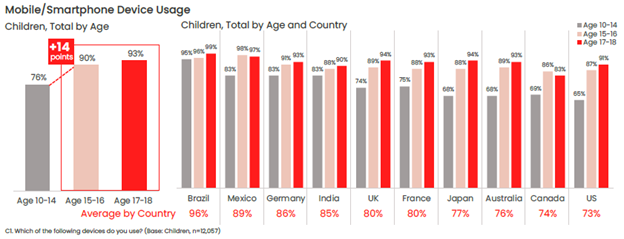
One of the top reasons parents give their child a phone is to stay in touch, so it likely follows that those phones will likely make their way into the classroom. Whether or not that’s the case for your child, back-to-school time is still a great time to help your child stay safer on their phone—and keep their phones safer too in the event of loss or theft.
Comprehensive online protection software can protect your phone in the same way that it protects your laptops and computers. Unfortunately, while many people use it on their laptops and computers, far fewer people use it on their phones—only about 42% of tweens and teens worldwide use it on their smartphones according to our most recent research.
Installing it can protect their privacy, keep them safe from attacks on public Wi-Fi, and automatically block unsafe websites and links, just to name a few things it can do. You can find our smartphone apps in both Google Play and the Apple App Store.
Updates do all kinds of great things for gaming, streaming, and chatting apps, such as adding more features and functionality over time. Updates do something else—they make those apps more secure. Hackers will hammer away at apps to find or create vulnerabilities, which can steal personal info or compromise the device itself. Updates will often include security improvements, in addition to performance improvements.
iPhones update apps automatically by default, yet you can learn how to turn them back on here if they’ve been set to manual updates. For Android phones, this article can help you set apps to auto-update if they aren’t set that way already.
Much the same goes for the operating system on smartphones too. Updates can bring more features and more security. iOS users can learn how to update their phones automatically in this article. Likewise, Android users can refer to this article about automatic updates for their phones.
Another finding from our latest global research is just how few people use a lock screen on their phones. Only 56% of parents said that they protect their smartphone with a password or passcode, and only 42% said they do the same for their child’s smartphone—a further 14% drop between parents and kids.
The issue here is clear. If an unlocked phone gets lost or stolen, all the information on it is an open book to a potential hacker, scammer, or thief. Enabling a lock screen if you haven’t already. It’s a simple feature found in both iOS and Android devices.
Preventing the actual theft of your phone is important too, as some hacks happen simply because a phone falls into the wrong hands. This is a good case for password or PIN protecting your phone, as well as turning on device tracking so that you can locate your phone or even wipe it remotely if you need to. Apple provides iOS users with a step-by-step guide for remotely wiping devices, and Google offers up a guide for Android users as well.
Strong, unique passwords offer another primary line of defense. Yet with all the accounts we have floating around, juggling dozens of strong and unique passwords can feel like a task—thus the temptation to use (and re-use) simpler passwords. Hackers love this because one password can be the key to several accounts. Instead, try a password manager that can create those passwords for you and safely store them as well.
Google Play and Apple’s App Store have measures in place to review and vet apps to help ensure that they are safe and secure. Third-party sites may not have that process in place. In fact, some third-party sites may intentionally host malicious apps as part of a broader scam. Granted, cybercriminals have found ways to work around Google and Apple’s review process, yet the chances of downloading a safe app from them are far greater than anywhere else. Furthermore, both Google and Apple are quick to remove malicious apps once discovered, making their stores that much safer.
One way that crooks can hack their way into your phone is via public Wi-Fi, such as at coffee shops, libraries, and other places on the go. These networks are public, meaning that your activities are exposed to others on the network—your banking, your password usage, all of it. One way to make a public network private is with a VPN, which can keep you and all you do protected from others on that Wi-Fi hotspot. Note that our VPN can turn on automatically for public Wi-Fi, protecting account credentials, search habits, and other activities online.
The same advice applies to these devices as well—strong online protection software, password management, VPN usage, and so on. What’s good for a smartphone is good for laptops and desktops too.
For laptops in particular, you can track these devices as well, just like a smartphone. The process differs from smartphones, yet it’s still quite straightforward. Windows and Mac users can enable the following settings—and you can click the links below for complete instructions from the source:
Putting these same protections in place on your laptops and desktops will help make your child, and your whole family, safer than before.
Note that on school-issued devices, your school district will likely have technology teams who manage them. As part of that, they typically have policies and restrictions in place to help keep them running safe and sound. If you have any questions about what kind of protections are in place on these school-issued devices, contact your school district.
While we’ve largely focused on protecting the phone itself, there’s also the importance of protecting the person who’s using it. In this case, your child—what they see, do, and experience on the internet. Device security is only part of the equation there.
Parents of tweens and teens know the concerns that come along with smartphone usage, ranging anywhere from cyberbullying, too much screen time, and simply wanting to know what their child is up to on their phone.
As you can imagine, each of these topics deserves its own treatment. The “Family Safety” section of our blog offers parents and their kids alike plenty of resources, and the list below can get you started on a few of the most pressing issues:
Without a doubt, while a child may get their first smartphone to “keep in touch,” that ownership blossoms into something far greater. And quite quickly. As they dive into the world of apps, social media, messaging, and gaming, take an interest, take it as an opportunity to spend time talking about their day and what it was like online.
By asking if they grabbed any cool pictures, what their favorite games are, and how their friends are when your child is texting them, questions like these can open a look into a world that would otherwise remain closed. This way, talking about the phone and what they’re doing on it becomes part of normal, everyday conversation. This can reap benefits down the road when your child encounters the inevitable bumps along the way, whether they’re dealing with a technical issue or something as difficult as cyberbullying or harassment. Talking about their life online on a regular basis may make them more apt to come forward when there’s a problem than they otherwise might.
In all, think of the smartphone as a fast pass into adulthood, thanks to how it puts the entirety of the internet right in your child’s hand. Protecting the device and the kid who’s using it will help ensure they get the absolute best out of all that potential.
The post Getting Your Kids Ready for School—And Their Smartphones Too appeared first on McAfee Blog.

With a buzz, your phone lets you know you got a text. You take a peek. It’s from the U.S. Postal Service with a message about your package. Or is it? You might be looking at a smishing scam.
“Smishing” takes its form from two terms: SMS messaging and phishing. Effectively, smishing is a phishing attack on your phone. Scammers love these attacks year-round, and particularly so during holiday shopping rushes. The fact remains that we ship plenty of packages plenty often, and scammers use that to their advantage.
Smishing attacks try to slip into the other legitimate messages you get about shipments. The idea is that you might have a couple on the way and might mistake the smishing attack for a proper message. Scammers make them look and sound legit, posing as the U.S. Postal Service or other carriers like UPS, DHL, and FedEx.
New data from McAfee’s State of the Scamiverse 2025 report reveals that text and email scams are on the rise worldwide. The average American is targeted by more than 14 scams every day, including an average of 3 deepfake videos. This surge in scam activity shows that scammers are increasingly relying on mobile attacks, as 76% of all tax scam activity in 2024 targeted mobile users via text, often using URL shorteners to disguise fraudulent links.
To pull off these attacks, scammers send out text messages from random numbers saying that a delivery has an urgent transit issue. When a victim taps on the link in the text, it takes them to a form page that asks them to fill in their personal and financial info to “verify their purchase delivery.” With the form completed, the scammer can then exploit that info for financial gain.
However, scammers also use this phishing scheme to infect people’s devices with malware. For example, some users received links claiming to provide access to a supposed postal shipment. Instead, they were led to a domain that did nothing but infect their browser or phone with malware. Regardless of what route the hacker takes, these scams leave the user in a situation that compromises their smartphone and personal data.
While delivery alerts are a convenient way to track packages, it’s important to familiarize yourself with the signs of smishing scams. Doing so will help you safeguard your online security without sacrificing the convenience of your smartphone. To do just that, take these straightforward steps.
Go directly to the source.
Be skeptical of text messages from companies with peculiar requests or info that seems too good to be true. Be even more skeptical if the link looks different from what you’d expect from that sender — like a shortened link or a kit-bashed name like “fed-ex-delivery dot-com.” Instead of clicking on a link within the text, it’s best to go straight to the organization’s website to check on your delivery status or contact customer service.
Enable the feature on your mobile device that blocks certain texts.
Many spammers send texts from an internet service to hide their identities. You can combat this by using the feature on your mobile device that blocks texts sent from the internet or unknown users. For example, you can disable all potential spam messages from the Messages app on an Android device. Head to “Settings,” tap on “Spam protection,” and then enable it. On iPhones, head to “Settings” > “Messages” and flip the switch next to “Filter Unknown Senders.”
One caveat, though. This can block legitimate messages just as easily. Say you’re getting your car serviced. If you don’t have the shop’s number stored on your phone, their updates on your repair progress will get blocked as well.
Use mobile device protection.
Our McAfee Mobile Security puts up a great defense. Devices can be attacked by malware and other forms of malicious software. Our mobile security app offers peace of mind by protecting your identity, privacy, and device.
Protect your privacy and identity all around.
McAfee+ plans offer strong protection for your identity, privacy, and finances. All the things those smishers are after. It includes credit and identity monitoring, social privacy management, and a VPN, plus several transaction monitoring features. Together, they spot scams and give you the tools to stop them dead in their tracks.
And if the unfortunate happens, our Identity Theft Coverage & Restoration can get you on the path to recovery. It offers up to $2 million in coverage for legal fees, travel, and funds lost because of identity theft. Further, a licensed recovery pro can do the work for you, taking the necessary steps to repair your identity and credit.
The post How Not to Fall for Smishing Scams appeared first on McAfee Blog.

Before your phone gets lost or stolen, put some basic steps in place.
You’ll want to act quickly, so preparation is everything. With the right measures, you can find it, recover it, or even erase it if needed. These steps can get you set up so you can do exactly that.
Lock your phone.
Locking your phone is one of the most basic smartphone security measures you can take. Trouble is, few of us do it. Our recent global research showed that only 56% of adults said that they protect their smartphone with a password, passcode, or other form of lock.[i] In effect, an unlocked phone is an open book to anyone who finds or steals a phone
Setting up a lock screen is easy. It’s a simple feature found on iOS and Android devices. iPhones and Androids have an auto-lock feature that locks your phone after a certain period of inactivity. Keep this time on the low end, one minute or less, to help prevent unauthorized access.
We suggest using a six-digit PIN or passcode rather than using a gesture to unlock your phone. They’re more complex and secure. Researchers proved as much with a little “shoulder surfing” test. They looked at how well one group of subjects could unlock a phone after observing the way another group of subjects unlocked it.[ii]
Turn on “Find My Phone.”
Another powerful tool you have at your disposal is the Find My Phone feature made possible thanks to GPS technology. The “find my” feature can help you pinpoint your phone if your lost or stolen phone has an active data or Wi-Fi connection and has its GPS location services enabled. Even if the phone gets powered down or loses connection, it can guide you to its last known location.
Setting up this feature is easy. Apple offers a comprehensive web page on how to enable and use their “Find My” feature for phones (and other devices too). Android users can get a step-by-step walkthrough on Google’s Android support page as well.
Back up your stuff in the cloud.
Thanks to cloud storage, you might be able to recover your photos, files, apps, notes, contact info, and more if your phone is lost or stolen. Android owners can learn how to set up cloud backup with Google Drive here, and iPhone users can learn the same for iCloud here.
Write down your phone’s unique ID number.
Here are a couple of acronyms. IMEI (International Mobile Equipment Identity) or MEID (Mobile Equipment Identifier) are two types of unique ID numbers assigned to smartphones. Find yours and write it down. In case of loss or theft, your mobile carrier, police department, or insurance provider might ask for the info to assist in its return or reimbursement for loss.
Beyond digital security measures, plenty of loss and theft prevention falls on you. Treat your phone like the desirable item it is. That’s a big step when it comes to preventing theft.
Keep your phone close.
And by close, we mean on your person. It’s easy to leave your phone on the table at a coffee shop, on a desk in a shared workspace, or on a counter when you’re shopping. Thieves might jump on any of these opportunities for a quick snatch-and-grab. You’re better off with your phone in your pocket or zipped up in a bag that you keep close.
Secure your bags and the devices you carry in them.
Enterprising thieves will find a way. They’ll snatch your bag while you’re not looking. Or they might even slice into it with a knife to get what’s inside, like your phone.
Keep your bag or backpack close. If you’re stopping to grab a bite to eat, sling the handles through a chair leg. If you have a strong metal carabiner, you can use that too. Securing your bag like that can make it much tougher for a thief to walk by and swipe it. For extra security, look into a slash-resistant bag.
If you have a credit card and ID holder attached to the back of your phone, you might want to remove your cards from it. That way, if your phone gets snatched, those important cards won’t get snatched as well.
In the event of your phone getting lost or stolen, a combination of device tracking, device locking, and remote erasing can help protect your phone and the data on it.
Different device manufacturers have different ways of going about it. But the result is the same — you can prevent others from using your phone, and even erase it if you’re truly worried that it’s in the wrong hands or gone for good. Apple provides iOS users with a step-by-step guide, and Google offers up a guide for Android users as well.
Apple’s Find My app takes things a step further. Beyond locating a lost phone or wiping it, Find My can also mark the item as lost, notify you if you’ve left it behind, or trigger a sound to help you locate it. (A huge boon in that couch cushion scenario!) Drop by Apple’s page dedicated to the Find My app for more details on what you can do on what devices, along with instructions how.
With preparation and prevention, you can give yourself reassurance if your phone gets lost or stolen. You have plenty of recovery options, in addition to plenty of ways to prevent bad actors from getting their hands on the sensitive info you keep on it.
[i] https://www.mcafee.com/content/dam/consumer/en-us/docs/reports/rp-connected-family-study-2022-global.pdf
[ii] https://arxiv.org/abs/1709.04959
The post What Should I do If My Phone Gets Stolen or Lost? appeared first on McAfee Blog.

We all love free stuff. (Costco samples, anyone?) However, when it comes to your family’s security, do free online protection tools offer the coverage you truly need?
Not always. In fact, they might invade the privacy you’re trying to protect.
Here’s why.
Free tools don’t offer the level of advanced protection that life on today’s internet needs. For starters, you’ll want malware and antivirus protection that’s as sophisticated as the threats they shut down. Ours includes AI technology and has for years now, which helps it shut down even the latest strains of malware as they hit the internet for the first time. We’re seeing plenty of that, as hackers have also turned to AI tools to code their malicious software.
Malware and antivirus protection protects your devices. Yet a comprehensive approach protects something else. You and your family.
Comprehensive online protection looks after your family’s privacy and identity. That keeps you safe from prying eyes and things like fraud and identity theft. Today’s comprehensive protection offers more features than ever, and far more than you’ll find in a free, and so incomplete, offering.
Consider this short list of what comprehensive online protection like ours offers you and your family:
Scam Protection
Is that email, text, or message packing a scam link? Our scam protection lets you know before you click that link. It uses AI to sniff out bad links. And if you click or tap on one, no worries. It blocks links to malicious sites.
Web Protection
Like scam protection, our web protection sniffs out sketchy links while you browse. So say you stumble across a great-looking offer in a bed of search results. If it’s a link to a scam site, you’ll spot it. Also like scam protection, it blocks the site if you accidentally hit the link.
Transaction Monitoring
This helps you nip fraud in the bud. Based on the settings you provide, transaction monitoring keeps an eye out for unusual activity on your credit and debit cards. That same monitoring can extend to retirement, investment, and loan accounts as well. It can further notify you if someone tries to change the contact info on your bank accounts or take out a short-term loan in your name.
Credit Monitoring
This is an important thing to do in today’s password- and digital-driven world. Credit monitoring uncovers any inconsistencies or outright instances of fraud in your credit reports. Then it helps put you on the path to setting them straight. It further keeps an eye on your reports overall by providing you with notifications if anything changes in your history or score.
Social Privacy Manager
Our social privacy manager puts you in control of who sees what on social media. With it, you can secure your profiles the way you want. It helps you adjust more than 100 privacy settings across your social media accounts in just a few clicks. It offers recommendations as you go and makes sure your personal info is only visible to the people you want. You can even limit some of the ways that social media sites are allowed to use your data for greater peace of mind.
Personal Data Cleanup
This provides you with another powerful tool for protecting your privacy. Personal Data Cleanup removes your personal info from some of the sketchiest data broker sites out there. And they’ll sell those lines and lines of info about you to anyone. Hackers and spammers included. Personal Data Cleanup scans data broker sites and shows you which ones are selling your personal info. From there, it provides guidance for removing your data from those sites. Further, when part of our McAfee+ Advanced and Ultimate, it sends requests to remove your data automatically.
Password Manager
Scammers love weak or reused passwords. Even more so when they’re weak and reused. It offers them an easy avenue to force their way into people’s accounts. Our password manager creates and securely stores strong, unique passwords for you. That saves you the hassle of creating strong, unique passwords for your dozens and dozens of accounts. And helps protect you from fraud.
Identity Theft Coverage & Restoration
This provides you with extra assurance while you shop. Say the unfortunate happens to you and find yourself a victim of identity theft. Our coverage and restoration plan provides up to $2 million in lawyer fees and reimbursement for lawyer fees and stolen funds. Further, a licensed expert can help you repair your identity and credit. In all, this saves you money and your time if theft happens to you.
Say your online protection leaves gaps in your family’s safety, or that it uses less-effective methods and technologies. That exposes you to threats — threats can cost you time and money alike if one of those threats gets through.
One example, consider the online crimes reported to the U.S. Federal Trade Commission. In 2023, they fielded 5.4 million fraud reports. Of them, 2.6 million reported a loss for a total of $10 billion. The median loss was $500 across all reports. Of course, that’s only the median dollar amount. That number can climb much higher in individual cases.
Source: U.S. Federal Trade Commission
Without question, protection is prevention, which can spare you some significant financial losses. Not to mention the time and stress of restoring your credit and identity — and getting your money back.
A “free” solution has to make its money somehow.
Free security solutions sometimes carry in-app advertising. More importantly, they might try to gather your user data to target ads or share it with others to make a profit. Also by advertising for premium products, the vendor indirectly admits that a free solution doesn’t provide enough security.
Further, these tools also offer little to no customer support, leaving users to handle any technical difficulties on their own. What’s more, most free security solutions are meant for use on only one device, whereas the average person owns several connected devices. And that’s certainly the case for many families.
Lastly, free solutions often limit a person’s online activity too. Many impose limits on which browser or email program the user can leverage, which can be inconvenient as many already have a preferred browser or email platform.
Free security products might provide the basics, but a comprehensive solution can protect you from a host of other risks — ones that could get in the way of enjoying your time online.
With comprehensive online protection in place, your family’s devices get protection from the latest threats in the ever-evolving security landscape. It keeps your devices safe. And it keeps you safe. With that, we hope you’ll give us a close look when you decide to upgrade to comprehensive protection.
The post Why Should I Pay for Online Protection? appeared first on McAfee Blog.

A text pops up on your phone. It’s your pal, and the text says, “What’s the password again?” It might be for a video streaming app, a delivery service, or a music site. But is it really OK to share passwords?
The answer to that question takes a couple of forms.
For starters, that app, service, or site you’re sharing has terms of use. Those terms might allow for sharing. Others might not. From that standpoint, sharing might break those terms.
Secondly, sharing passwords with someone outside your household carries security risks. And that’s what we’ll focus on here.
One set of research found that 79% of Americans surveyed said they shared passwords. Video streaming came in at 35%, delivery services at 29%, and music streaming at 9%.[i]
Yet that same research revealed something else. Only 7% of Americans said they worried about getting hacked despite all that password sharing.
The broader use a password sees, the more vulnerable it is. And that has a couple of dimensions to it.
The first is the more obvious of the two. Reusing passwords across accounts can lead to identity theft and fraud. Say a hacker gets a hold of a password on the dark web or directly through a data breach. If it’s reused across accounts, all those accounts could get compromised. The same is largely true of passwords that have little variation between them. When not unique, a hacker can figure out the variation with relatively little effort.
The second is a bit more subtle. Sharing passwords with people outside the household means those passwords get used on devices outside of the household. The question then is, are those devices secure? Do the people who own them use online protection software to keep themselves safer online? If not, those passwords could get exposed. One example — a friend logs into a streaming site on unprotected Wi-Fi. A hacker monitors the traffic, skims the password, and sells it on the dark web.
So, for several reasons, sharing passwords is not OK. And it brings up an important point about passwords in general. We have a lot of them. Yet each one must be secure.
So, we’ve mentioned some of the security risks around passwords. Primary among them, weak and reused passwords.
It’s no wonder people go the route of easy-to-remember passwords they use again and again. According to Pew Research, American adults feel overwhelmed by the number of passwords they have to keep track of. Depending on the age group, that feeling ranges from 61% to 74%.[ii]
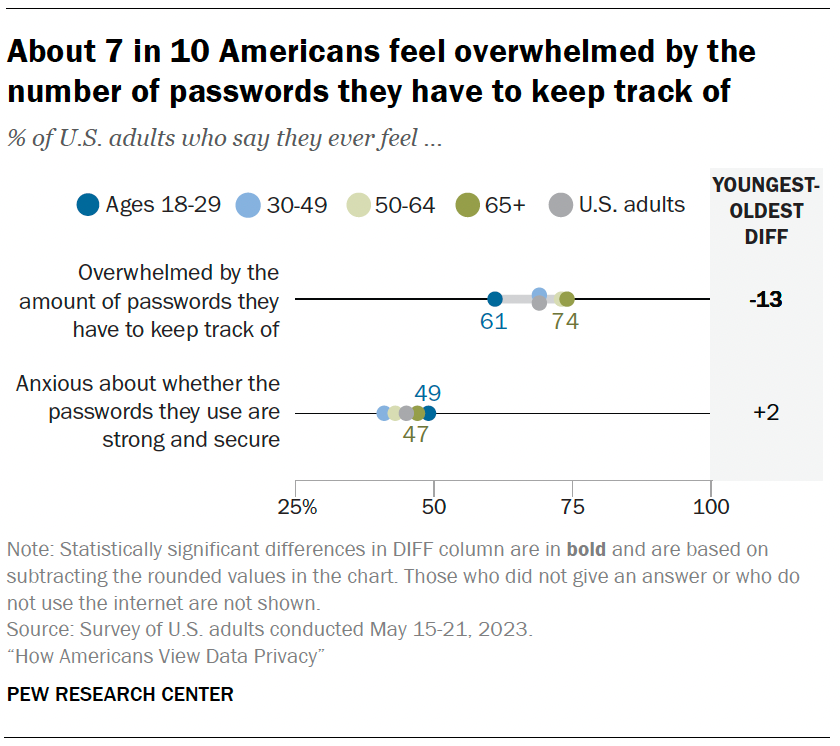
That sense of overwhelm takes shape in another interesting way. Increasingly, people are doing something about it. Faced with creating strong and unique passwords, more people let a password manager do the work for them. In 2019, only 20% of Americans surveyed said they used one. In 2023, that number leapt up to 32%.[iii] A solid 12% rise that now covers nearly a third of all Americans.
So, for anyone bogged down by passwords, a password manager offers an excellent solution.
And a safe one at that.
A password manager like ours helps you protect your accounts from hackers by securely creating and storing strong and unique passwords. The very kind of passwords that hackers hate. While you’re online, it auto-fills your info for faster logins. Best of all, you only have to remember a single password.
Don’t.
For one, sharing passwords might break the terms of use for the app, service, or site in question. Next, it can bring security issues with it as multiple people use it on multiple devices — ones that might or might not be secure.
On a related note, re-using passwords across several accounts increases your risk of getting hacked even more. Whether they’re weak and memorable or variations on a common theme, passwords like these make life easier for hackers.
As always, each of your accounts calls for a strong and unique password. And if you’re like the many who have dozens and dozens of accounts, a password manager can make that easy. And highly secure, too.
[i] https://www.thezebra.com/resources/home/dangers-of-sharing-passwords/
[ii] https://www.pewresearch.org/internet/2023/10/18/how-americans-protect-their-online-data/
[iii] Ibid.
The post Do You Share Passwords with Friends and Family? appeared first on McAfee Blog.

Are smartphones less secure than PCs? The answer to that is, they’re different. They face different security threats. Yet they certainly share one thing in common — they both need protection.
So, what makes a smartphone unique when it comes to security? And how do you go about protecting it? We’ll cover both here.
Several facts of life about smartphones set them apart when it comes to keeping your devices safer. A quick rundown looks like this:
First off, people keep lots of apps on their phones. Old ones, new ones, ones they practically forgot they had. The security issue that comes into play there is that any app on a phone is subject to vulnerabilities.
A vulnerability in just one of the dozens of apps on a phone can lead to problems. The adage of “the weakest link” applies here. The phone is only as secure as its least secure app. And that goes for the phone’s operating system as well.
Additionally, app permissions can also introduce risks. Apps often request access to different parts of your phone to work — such as when a messenger app asks for access to contacts and photos. In the case of malicious apps, they’ll ask for far more permissions than they need. A classic example involves the old “flashlight apps” that invasively asked for a wide swath of permissions. That gave the hackers all kinds of info on users, including things like location info. Today, the practice of malicious, permission-thirsty apps continues with wallpaper apps, utility apps, games, and more.
As for other malicious apps, sometimes people download them without knowing. This often happens when shopping in third-party app stores, yet it can happen in legit app stores as well — despite rigorous review processes from Apple and Google. Sometimes, hackers sneak them through the review process for approval. These apps might include spyware, ransomware, and other forms of malware.
Many people put their smartphones to personal and professional use.[i] That might mean the phone has access to corporate apps, networks, and data. If the phone gets compromised, those corporate assets might get compromised too. And it can work in the other direction. A corporate compromise might affect an employee’s smartphone.
More and more, our phones are our wallets. Digital wallets and payment apps have certainly gained popularity. They speed up checkout and make splitting meals with friends easy. That makes the prospect of a lost or stolen phone all the more serious. An unsecured phone in the hands of another is like forking over your wallet.
Lastly, spam texts. Unique to phones are the sketchy links that crop up in texting and messaging apps. These often lead to scam sites and other sites that spread malware.
With a good sense of what makes securing your smartphone unique, let’s look at several steps you can take to protect it.
Keeping your phone’s apps and operating system up to date can greatly improve your security. Updates can fix vulnerabilities that hackers rely on to pull off their malware-based attacks. it’s another tried and true method of keeping yourself safer — and for keeping your phone running great too.
With all that you keep and conduct on your phone, a lock is a must. Whether you have a PIN, passcode, or facial recognition available, put it into play. The same goes for things like your payment, banking, and financial apps. Ensure you have them locked too.
As mentioned above, app stores have measures in place to review and vet apps that help ensure they’re safe and secure. Third-party sites might very well not, and they might intentionally host malicious apps as part of a front. Further, legitimate app stores are quick to remove malicious apps from their stores once discovered, making shopping there safer still.
Check out the developer — have they published several other apps with many downloads and good reviews? A legit app typically has many reviews. In contrast, malicious apps might have only a handful of (phony) five-star reviews. Lastly, look for typos and poor grammar in both the app description and screenshots. They could be a sign that a hacker slapped the app together and quickly deployed it.
Yet better than combing through user reviews yourself is getting a recommendation from a trusted source, like a well-known publication or app store editors themselves. In this case, much of the vetting work has been done for you by an established reviewer. A quick online search like “best fitness apps” or “best apps for travelers” should turn up articles from legitimate sites that can suggest good options and describe them in detail before you download.
Another way hackers weasel their way into your device is by getting permissions to access things like your location, contacts, and photos — and they’ll use malicious apps to do it. If an app asks for way more than you bargained for, like a simple puzzle game that asks for access to your camera or microphone, it might be a scam. Delete the app.
So what happens if your phone ends up getting lost or stolen? A combination of device tracking, device locking, and remote erasing can help protect your phone and the data on it. Different device manufacturers have different ways of going about it, but the result is the same — you can prevent others from using your phone. You can even erase it if you’re truly worried that it’s gone for good. Apple provides iOS users with a step-by-step guide, and Google offers a guide for Android users as well.
Comprehensive online protection software can secure your phone in the same ways that it secures your laptops and computers. Installing it can protect your privacy, and keep you safe from attacks on public Wi-Fi, just to name a few things it can do. Ours also includes Text Scam Detector that blocks sketchy links in texts, messages, and email before they do you any harm. And if you tap that link by mistake, Text Scam Detector still blocks it.
[i] https://www.statista.com/statistics/1147490/share-adults-use-personal-smartphone-business-activities-by-country/
The post Are Mobile Devices Less Secure than PCs? appeared first on McAfee Blog.

Smartphone hacking is the unauthorized access to and control over a mobile device or its communications. This goes beyond a simple malware infection; it’s a targeted breach aimed at stealing your personal data, spying on your activities, or using your device for malicious purposes. Unlike general viruses that may just slow down your device, a hack can lead to severe real-world consequences. This article aims to increase your awareness about hacking methods, how to prevent it or determine if your phone has been infiltrated, and how to protect your phone moving forward.
Your smartphone is a goldmine of personal information, making it a high-value target for cybercriminals whose motivations are typically centered on financial gain and identity theft. Hackers seek banking credentials, credit card numbers, and access to payment apps for direct financial theft. Meanwhile, stealing your personal information—like emails, contacts, and passwords—allows them to commit identity fraud or sell on dark-web markets.
Beyond money, attackers may use your phone for surveillance, secretly activating your camera or microphone to spy on you. In other cases, they may hijack your device’s resources to include it in a botnet for larger attacks or hold your files hostage with ransomware. Understanding these threats is the first step in knowing how to protect yourself from them, so it’s vital to learn the methods hackers use to get into your phone.
While both iOS and Android are secure, their core philosophies create different opportunities for hackers. Android’s open-source nature allows for greater customization, including the ability to “sideload” third-party apps from outside the official Google Play Store. Unvetted apps with malicious code are a primary vector for malware.
In contrast, Apple’s iOS’s closed ecosystem makes it much harder to install unauthorized software. For this reason, many attacks targeting iPhones rely on social engineering, sophisticated zero-day exploits that target unknown vulnerabilities, or jailbroken devices, which strips away Apple’s built-in protections.
To protect your device, tailor your defense to its ecosystem. The best practice for Android users is to stick to the Google Play Store and ensure Google Play Protect is active, as it continuously scans your apps for harmful behavior. iPhone users concerned about targeted attacks should activate Lockdown Mode, an extreme feature that limits functionality to reduce the potential attack surface. Regardless of your platform, keeping your operating system updated is the single most important step you can take to stay secure.
Wondering how your phone gets compromised? Hackers use several common pathways.
A hacker might install spyware after you jailbreak or root your smartphone to bypass the security of their respective stores. Jailbreaking or rooting gives smartphone users more control over their devices, such as removing pre-installed apps and installing third-party apps from unvetted sources. However, this action removes barriers that keep viruses and malware from entering the smartphone’s system and spreading to apps, files, devices and other networks. And because Apple and Google don’t review the apps in those sources, this allows the hacker to post a bad app with relative ease.
Apple has a strict review policy before apps are approved for posting in the App Store. Meanwhile, Google started applying AI-powered threat detection, stronger privacy policies, supercharged developer tools, industry-wide alliances, and other methods in its app reviews. Bad actors, however, could still sneak malware into the stores by uploading infected app versions during updates. Other times, they’ll embed malicious code that triggers only in certain countries or encrypt malicious code into the app they submit, making it difficult for reviewers to sniff out.
Cybercriminals have several sophisticated methods to hack smartphones remotely. One common technique is phishing, where you might receive a text or email with a malicious link that, when clicked, installs spyware on your device. Another remote hacking vector is through unsecured public Wi-Fi networks, where hackers can intercept your data. Spyware can also be delivered via SMS payloads that require no user interaction.
Smishing (SMS phishing) is a common and effective way for hackers to attack your phone, where they send an urgent text with a malicious link, like a fake delivery notification or a bank alert, to trick you into clicking without thinking. Once you click, the link can lead to a fake website designed to steal your login credentials or directly download malware onto your device. Attackers also use MMS messages to send malicious files, like images or videos, which in some rare “zero-click” exploits, can infect your phone without you even opening the message.
To protect yourself, treat all unexpected links in text messages with suspicion. Never click on a link from an unknown sender. A key preventive step is to go into your messaging app’s settings and disable the automatic download of MMS files. This prevents malicious media from loading onto your device automatically. Always verify urgent requests by contacting the company or person directly through a trusted channel, not by using the contact information provided in the suspicious text.
In this method, hackers use techniques like drive-by downloads, which silently installs malware onto your device the moment a page loads—no click required. Malvertising is where malicious code is hidden in online ads that, if served on a site you visit, can trigger a spyware or ransomware download. These attacks are most effective against devices with outdated web browsers, as they target known security holes that have since been patched. Fake “update required” pop-ups are designed to scare you into installing malicious software disguised as a critical browser update. To protect yourself, always keep your mobile browser and operating system fully updated. Use your browser’s built-in safe-browsing features, and be cautious about granting permissions or clicking links on unfamiliar websites.
These two sophisticated attacks can give a hacker complete control over your phone number. In a SIM-swap attack, a criminal tricks your mobile carrier into transferring your phone number to a SIM card they control. In phone cloning, they copy the identifying information from your phone to another, making a functional duplicate. In either case, the attacker can then intercept your calls, texts, and two-factor authentication codes.
Proactive defense includes setting up a unique PIN or password on your account for an extra layer of security. Switch to an eSIM if possible, as eSIMs are not as easily swapped as physical cards. If you suspect an attack, immediately report the issue to your carrier and check your financial and email accounts for unauthorized activity. You can also use the dial codes, like *#62#, to see if your calls are being forwarded to an unknown number.
Malicious apps and spyware can secretly access your camera and microphone, potentially livestreaming audio and video to an attacker without your knowledge. Key warning signs include the camera indicator light turning on unexpectedly, significant and unexplained battery drain, or finding unfamiliar photos and videos in your gallery. To protect yourself, regularly audit the apps installed on your phone. Go into your device’s settings to review which apps have permission to access your camera and revoke access for any that don’t need it.
Network-based attacks occur over unsecured public Wi-Fi where attackers can intercept your data. Finally, unsecure cloud backups can be a weak point, as a compromised password for your Apple or Google account could give a hacker access to all the data you’ve stored. Knowing these attack vectors is the first step toward understanding how to know if your phone is hacked.
Because we spend so much time on our phones, it’s fairly easy to tell when something isn’t working right. Sometimes those issues are symptoms of an infection. Possible signs that your device has been hacked include:
If these symptoms are present, use the following tools to verify whether your device has been compromised:
The results of the scan are in: your smartphone has clearly been hacked. There is no time to lose. To start the process of blocking the hacker or removing the malware, follow these essential first steps:
Persistent problems with your smartphone after a factory reset, may indicate a sophisticated, low-level hack. If you are the victim of significant financial fraud or identity theft, or if the hack involves sensitive legal or corporate data, it is crucial to stop using your smartphone and get assistance. In these cases, continued use could tamper with evidence.
After reporting the hacking incident to your mobile carrier, and authorities, you may need a certified digital forensic analyst for deep analysis, especially in corporate or legal cases. Before you call, gather key information: the make and model of your phone, the date you first noticed issues, a list of suspicious apps or messages, and any known fraudulent activity on your accounts.
Certain dial codes, also known as Unstructured Supplementary Service Data (USSD) or Man-Machine Interface (MMI) codes, can help you check for signs of suspicious activity or hidden configurations. These codes can reveal call forwarding, SIM tracking, or conditional redirects that may indicate a compromise:
You can take simple, effective steps to protect yourself and your device from hackers. Here are some practical tips, from the basic to the more layered steps, to help you block hackers from accessing your phone.
To avoid the hassle of having a hacked phone in the first place, here are some fundamental measures you can do as part of your routine:
Beyond the foundational advice, fortifying your smartphone requires a layered defense. We suggest the following actions you can apply:
Securing your device doesn’t have to be complicated or time-consuming. In fact, many powerful protections are just a tap away. This quick checklist offers quick and simple security settings you can enable with minimal effort.
Does dialing *#21# show if I’m hacked?
This code shows if your calls and messages are being forwarded, which can be a sign of a hack, but it doesn’t detect other types of malware or spyware.
Can iPhones get viruses?
While less common due to Apple’s strong security structure, iPhones can still be compromised, especially through malicious apps from outside the App Store or sophisticated phishing attacks.
Will a factory reset remove spyware?
In most cases, yes. A factory reset erases all data and apps on your device, including most forms of malware and spyware, returning it to its original state.
Can my phone be hacked while powered off?
A phone that is truly powered off cannot be hacked remotely. When the device is off, its wireless radios (cellular, Wi-Fi, Bluetooth) are inactive, and the operating system is not running, cutting off any connection for an attacker to exploit. In Airplane Mode, only the radios are disabled, but leaves the OS running.
The myth of a phone being hacked while off often stems from two things: advanced, targeted attacks that fake a shutdown to compromise firmware, or physical attacks like a “cold boot” where a forensics expert with physical access can extract data from the RAM shortly after shutdown. To mitigate these extremely rare risks, always ensure your phone is fully encrypted, a default setting on modern iPhones and Androids, to make data unreadable even if accessed physically.
For everyday security, shutting off your phone is a good first step to sever any potential malicious connection.
Does my iPhone need antivirus?
If your iPhone is not jailbroken, you don’t need antivirus. But your phone should still get extra protection to deal with other cyberthreats such as scammy text messages, phishing and AI-driven attempts. Comprehensive online protection software like McAfee keeps you and your phone safer. It can:
Those are only some of the many McAfee capabilities that protect you and your phone.
Recognizing the signs your phone is hacked is the critical first step, but swift and correct action is what truly protects you.
You can usually determine your smartphone has been hacked by observing any unusual behavior patterns, such as unexplained battery drain, data usage spikes, a blitz of ad pop-ups, unexplained charges on your banking accounts, and even mysterious calls, texts, or apps. Another way to confirm a breach is by running built-in diagnostics such as security scans and security keys. If any of the odd behaviors listed above sound familiar, don’t wait. Take immediate action and implement a layered defense.
In the first place, you can significantly reduce your risk of being hacked through regular software updates, careful app management, and smart browsing habits. Another important component is installing a complete privacy, identity and device solution like McAfee that provides comprehensive protection.
Don’t wait until you suspect a breach; adopt these protective strategies today to keep your digital life private and secure.
The post How To Tell If Your Smartphone Has Been Hacked appeared first on McAfee Blog.

In today’s interconnected world, our mobile devices serve as essential tools for communication, productivity, and entertainment. However, for some tech-savvy users, the allure of unlocking the full potential of their devices through jailbreaking (for iOS) or rooting (for Android) can be tempting. While these processes offer users greater control and customization over their devices, they also raise significant questions about security implications.
To “jailbreak” means to allow the phone’s owner to gain full access to the root of the operating system and access all the features. Jailbreaking is the process of removing the limitations imposed by Apple and associated carriers on devices running the iOS operating system. Jailbroken phones came into the mainstream when Apple first released their iPhone and it was only on AT&T’s network. Users who wanted to use an iPhone with other carriers were not able to unless they had a jailbroken iPhone.
Similar to jailbreaking, “rooting” is the term for the process of removing the limitations on a mobile or tablet running the Android operating system. By gaining privileged control, often referred to as “root access,” over an Android device’s operating system, users can modify system files, remove pre-installed bloatware, install custom ROMs, and unlock features not accessible on stock devices.
Rooting or jailbreaking grants users deeper access to the device’s operating system, allowing for extensive customization of the user interface, system settings, and even hardware functionality. Advanced users can optimize system performance, remove unnecessary bloatware, and tweak settings to improve battery life, speed, and responsiveness.
However, hacking your device potentially opens security holes that may have not been readily apparent or undermines the device’s built-in security measures. Jailbroken and rooted phones are much more susceptible to viruses and malware because users can avoid Apple and Google application vetting processes that help ensure users are downloading virus-free apps.
In addition to security vulnerabilities, hacking your device may lead to a voided manufacturer’s warranty, leaving you without official support for repairs or replacements. Altering the device’s operating system can also lead to instability, crashes, and performance issues, especially if incompatible software or modifications are installed.
While rooting or jailbreaking may offer users enticing opportunities for customization and optimization of their mobile devices, the associated risks cannot be overlooked. By circumventing built-in security measures, users expose their devices to potential security vulnerabilities, making them more susceptible to viruses and malware. Ultimately, the decision to root or jailbreak a mobile device should be made with careful consideration of the trade-offs involved, as the security risks often outweigh the benefits.
When thinking about mobile security risks, consider adding reputable mobile security software to your device to augment the built-in security measures. These security solutions provide real-time scanning and threat detection capabilities, helping to safeguard sensitive data and maintain the integrity of the device’s operating system.
The post How Does Jailbreaking Or Rooting Affect My Mobile Device Security? appeared first on McAfee Blog.

“Vishing” occurs when criminals cold-call victims and attempt to persuade them to divulge personal information over the phone. These scammers are generally after credit card numbers and personal identifying information, which can then be used to commit financial theft. Vishing can occur both on your landline phone or via your cell phone.
The term is a combination of “voice,” and “phishing,” which is the use of spoofed emails to trick targets into clicking malicious links. Rather than email, vishing generally relies on automated phone calls that instruct targets to provide account numbers. Techniques scammers use to get your phone numbers include:
Once vishers have phone numbers, they employ various strategies to deceive their targets and obtain valuable personal information:
To protect yourself from vishing scams, you should:
Staying vigilant and informed is your best defense against vishing scams. By verifying caller identities, being skeptical of unsolicited requests for personal information, and using call-blocking tools, you can significantly reduce your risk of falling victim to these deceptive practices. Additionally, investing in identity theft protection services can provide an extra layer of security. These services monitor your personal information for suspicious activity and offer assistance in recovering from identity theft, giving you peace of mind in an increasingly digital world. Remember, proactive measures and awareness are key to safeguarding your personal information against vishing threats.
The post How to Protect Yourself from Vishing appeared first on McAfee Blog.

This has to be a first. Something from our blogs got made into a movie.
We’re talking about voice scams, the soundalike calls that rip people off. One such call sets the action in motion for a film released this weekend, “Thelma.”
The synopsis of the comedy reads like this …
“When 93-year-old Thelma Post gets duped by a phone scammer pretending to be her grandson, she sets out on a treacherous quest across the city to reclaim what was taken from her.”
Voice scams have been around for some time. They play out like an email phishing attack, where scammers try to trick people into forking over sensitive info or money — just in voice form over the phone. The scammer poses as someone the victim knows, like a close family member.
Yet the arrival of AI has made voice scams far more convincing. Cheap and freely available AI voice cloning tools have flooded the online marketplace in the past couple of years. They’re all completely legal as well.
Some cloning tools come in the form of an app. Others offer cloning as a service, where people can create a clone on demand by uploading audio to a website. The point is, practically anyone can create a voice clone. They sound uncanny too. Practically like the real thing, and certainly real enough over the phone. And it only takes a small sample of the target’s voice to create one.
Our own labs found that just a few seconds of audio was enough to produce a clone with an 85% voice match to the original. That number bounced up to 95% when they trained the clone further on a small batch of audio pulled from videos.
As to how scammers get a hold of the files they need, they have a ready source. Social media. With videos harvested from public accounts on YouTube, Instagram, TikTok, and other platforms, scammers have little trouble creating clones — clones that say whatever a scammer wants. All it takes is a script.
That’s where the attack comes in. It typically starts with a distress call, just like in the movie.
For example, a grandparent gets an urgent message on the phone from their grandchild. They’re stuck in the middle of nowhere with a broken-down car. They’re in a hospital across the country with a major injury. Or they’re in jail overseas and need to get bailed out. In every case, the solution to the problem is simple. They need money. Fast.
Sure, it’s a scam. Yet in the heat of the moment, it all sounds terribly real. Real enough to act right away.
Fearing the worst and unable to confirm the situation with another family member, the grandparent shoots the money off as instructed. Right into the hands of a scammer. More often than not, that money is gone for good because the payment was made with a wire transfer or through gift cards. Sometimes, victims pay out in cash.
Enter the premise for the movie. Thelma gets voice-scammed for thousands, then zips across Los Angeles on her friend’s mobility scooter to get her money back from the voice scammers.
The reality is of course more chilling. According to the U.S. Federal Trade Commission (FTC), nearly a million people reported a case of imposter fraud in 2023. Total reported losses reached close to $2.7 billion. Although not tracked and reported themselves, voice clone attacks certainly figure into this overall mix.
Even as we focus on the character of Thelma, voice clone attacks target people of all ages. Parents have reported cases involving their children. And married couples have told of scams that impersonate their older in-laws.
Common to each of these attacks is one thing: fear. Something horrible has happened. Or is happening. Here, scammers look to pull an immediate emotional trigger. Put plainly, they want to scare their victim. And in that fear, they hope that the victim immediately pays up.
It’s an odds game. Plenty of attacks fail. A parent might be sitting at the dinner table with their child when a voice clone call strikes. Or a grandchild might indeed be out of town, yet traveling with their grandmother when the scammer gives her a ring.
Yet if even a handful of these attacks succeed, a scammer can quickly cash in. Consider one attack for hundreds, if not thousands, or dollars. Multiply that by five, ten, or a dozen or so times over, a few successful voice clone scams can rack up big returns.
Yet you can protect yourself from these attacks. A few steps can make it more difficult for scammers to target you. A few others can prevent you from getting scammed if a voice clone pops up on the other end of the phone.
Make it tougher for scammers to target you by:
Clear your name from data broker sites. How’d that scammer get your phone number anyway? Chances are, they pulled that info off a data broker site. Data brokers buy, collect, and sell detailed personal info, which they compile from several public and private sources, such as local, state, and federal records, in addition to third parties. Our Personal Data Cleanup scans some of the riskiest data broker sites, shows you which ones are selling your personal info, and helps you remove your data.
Set your social media accounts to private. Scammers sift through public social media profiles in search of info on their targets. In some cases, an account can provide them with everything they need to launch an attack. Family names, family interests, where the family goes for vacation, where family members work — and videos that they can use for cloning. By making your accounts private, you deny scammers the resources they require. Our Social Privacy Manager can do this for you across all your accounts in only a few clicks.
Prevent getting scammed by:
Recognize that voice clone attacks are a possibility. As we’re still in the relatively early days of AI tools, not everyone is aware that this kind of attack is possible. Keeping up to date on what AI can do and sharing that info with your family and friends can help them spot an attack. As we’ve reported here before, voice clones are only the start. Other imposter scams run on video calls where a scammer takes on someone else’s voice and looks. All in real-time.
Always question the source. In addition to voice cloning tools, scammers have other tools that can spoof phone numbers so that they look legitimate. Even if it’s a voicemail or text from a number you recognize, stop, pause, and think. Does that really sound like the person you think it is? Hang up and call the person directly or try to verify the info before responding.
Set a verbal codeword with kids, family members, or trusted close friends. Even in the most high-tech of attacks, a low-tech precaution can keep everyone safe. Have a codeword. Save it for emergencies. Make sure everyone uses it in messages and calls when they ask for help. Further, ensure that only you and those closest to you know what the codeword is. This is much like the codewords that banks and alarm companies use to help ensure that they’re speaking to the proper account holder. It’s a simple, powerful step. And a free one at that.
The post Thelma – The Real-Life Voice Scam That Made It into the Movies appeared first on McAfee Blog.

By now you’ve probably heard of the term “phishing”—when scammers try to fool you into revealing your personal info or sending money, usually via email — but what about “vishing”? Vishing, or voice phishing, is basically the same practice, but done by phone.
There are a few reasons why it’s important for you to know about vishing. First off, voice phishing scams are prevalent and growing. A common example around tax season is the IRS scam, where fraudsters make threatening calls to taxpayers pretending to be IRS agents and demanding money for back taxes. Another popular example is the phony tech support scam, in which a scammer calls you claiming that they represent a security provider.
The scammers might say they’ve noticed a problem with your computer or device and want money to fix the problem, or even request direct access to your machine. They might also ask you to download software to do a “security scan” just so they can get you to install a piece of malware that steals your personal info. They might even try to sell you a worthless computer warranty or offer a phony refund.
These kinds of attacks can be very persuasive because the scammers employ “social engineering” techniques. This involves plays on emotion, urgency, authority, and even sometimes threats. The end result, scammers manipulate their victims into doing something for fraudulent purposes. Because scammers can reach you at any time on your most private device, your smartphone, it can feel more direct and personal.
Vishing scams don’t always require a phone call from a real person. Often, scammers use a generic or targeted recording, claiming to be from your bank or credit union. For instance, they might ask you to enter your bank account number or other personal details, which opens you up to identity theft.
Increasingly, scammers use AI tools in voice cloning attacks. With readily available voice cloning apps, scammers can replicate someone else’s voice with remarkable accuracy. While initially developed for benign purposes such as voice assistants and entertainment, scammers now use voice cloning tools to exploit unsuspecting victims.
The incoming number might even appear to have come from your bank, thanks to a trick called “caller ID spoofing,” which allows scammers to fake the origin of the call. They can do this by using Voice over Internet Protocol (VoIP) technology, which connects calls over the internet instead of traditional phone circuits, allowing them to easily assign incoming phone numbers.
Don’t risk losing your money or valuable personal info to these scams. Here’s how to avoid vishing attacks:
The post How to Avoid Being Phished by Your Phone appeared first on McAfee Blog.

Authored by Dexter Shin
Many government agencies provide their services online for the convenience of their citizens. Also, if this service could be provided through a mobile app, it would be very convenient and accessible. But what happens when malware pretends to be these services?
McAfee Mobile Research Team found an InfoStealer Android malware pretending to be a government agency service in Bahrain. This malware pretends to be the official app of Bahrain and advertises that users can renew or apply for driver’s licenses, visas, and ID cards on mobile. Users who are deceived by advertisements that they are available on mobile will be provided with the necessary personal information for these services without a doubt. They reach users in various ways, including Facebook and SMS messages. Users who are not familiar with these attacks easily make the mistake of sending personal information.
In Bahrain, there’s a government agency called the Labour Market Regulatory Authority (LMRA). This agency operates with full financial and administrative independence under the guidance of a board of directors chaired by the Minister of Labour. They provide a variety of mobile services, and most apps provide only one service per app. However, this fake app promotes providing more than one service.

Figure 1. Legitimate official LMRA website

Figure 2. Fake app named LMRA
Excluding the most frequently found fake apps pretending LMRA, there are various fake apps included Bank of Bahrain and Kuwait (BBK), BenefitPay, a fintech company in Bahrain, and even apps pretending to be related to Bitcoin or loans. These apps use the same techniques as the LMRA fake apps to steal personal information.
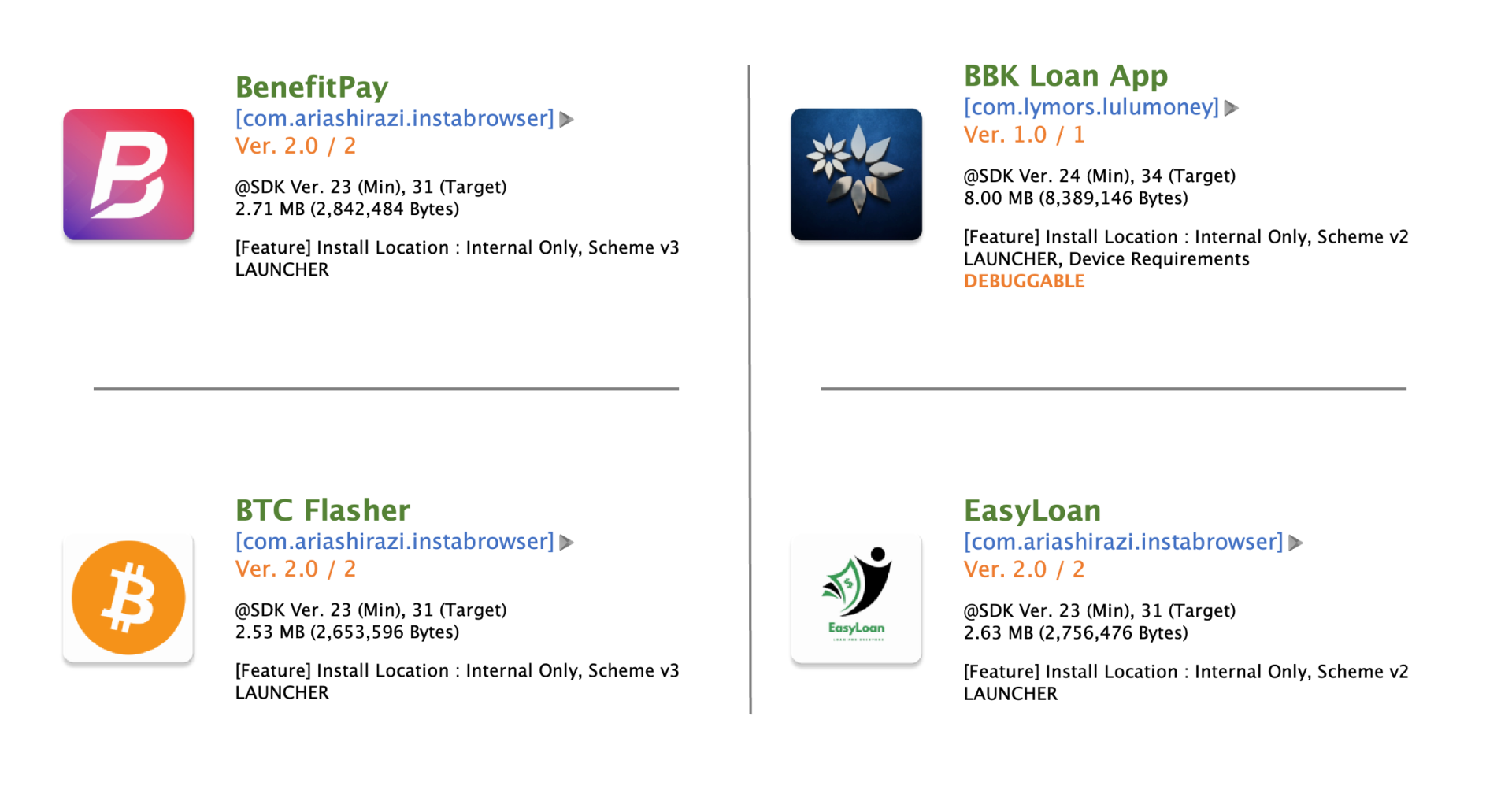
Figure 3. Various fake apps using the same techniques
From the type of app that this malware pretends, we can guess that the purpose is financial fraud to use the personal information it has stolen. Moreover, someone has been affected by this campaign as shown in the picture below.

Figure 4. Victims of financial fraud (Source: Reddit)
They distribute these apps using Facebook pages and SMS messages. Facebook pages are fake and malware author is constantly creating new pages. These pages direct users to phishing sites, either WordPress blog sites or custom sites designed to download apps.
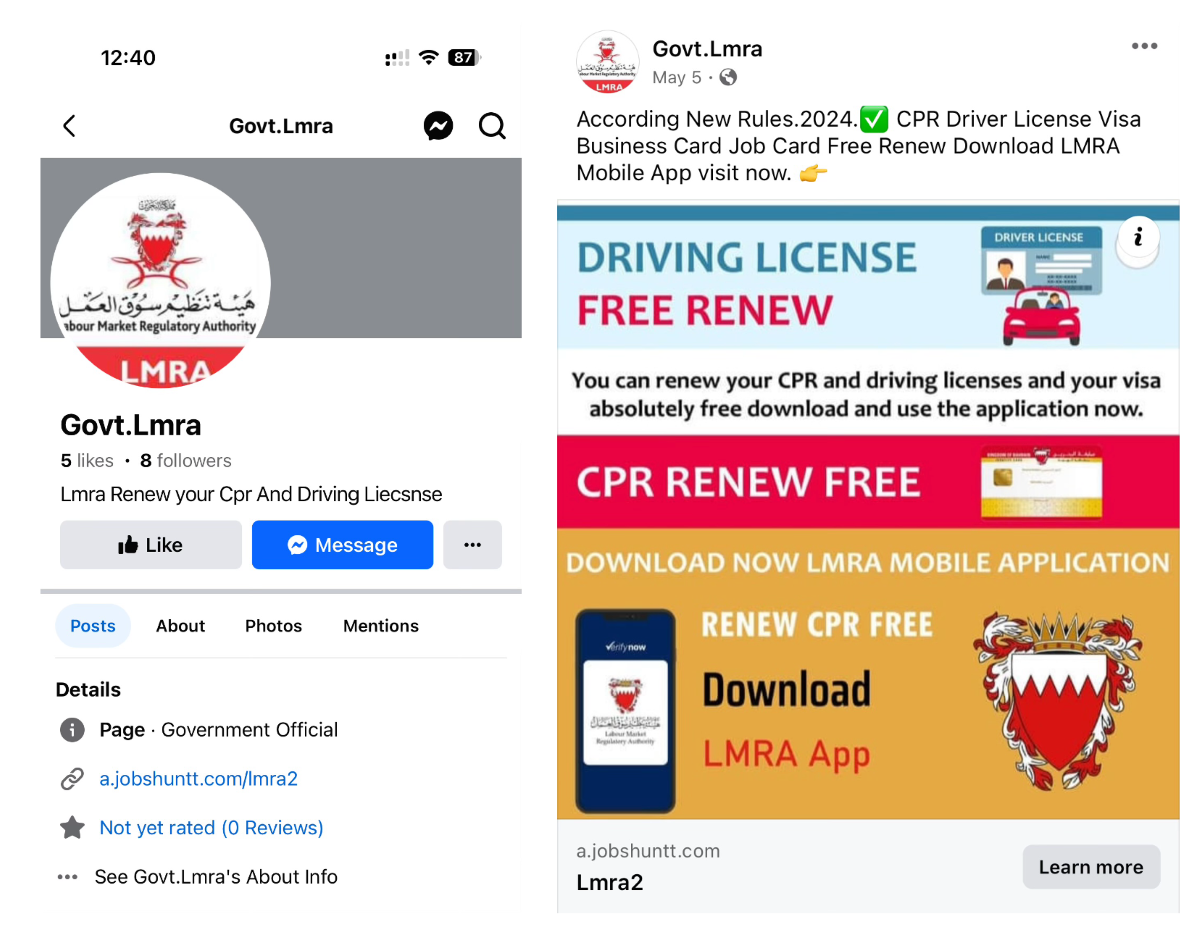
Figure 5. Facebook profile and page with a link to the phishing site

Figure 6. One of the phishing sites designed to download app
In the case of SMS, social engineering messages are sent to trick users into clicking a link so that they feel the need to urgently confirm.
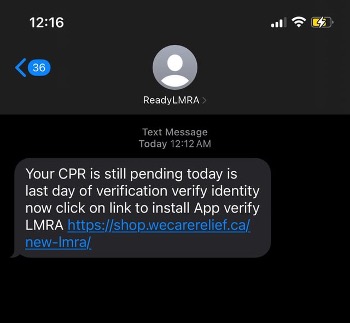
Figure 7. Phishing message using SMS (Source: Reddit)
When the user launches the app, the app shows a large legitimate icon for users to be mistaken. And it asks for the CPR and phone number. The CPR number is an exclusive 9-digit identifier given to each resident in Bahrain. There is a “Verify” button, but it is simply a button to send information to the C2 server. If users input their information, it goes directly to the next screen without verification. This step just stores the information for the next step.
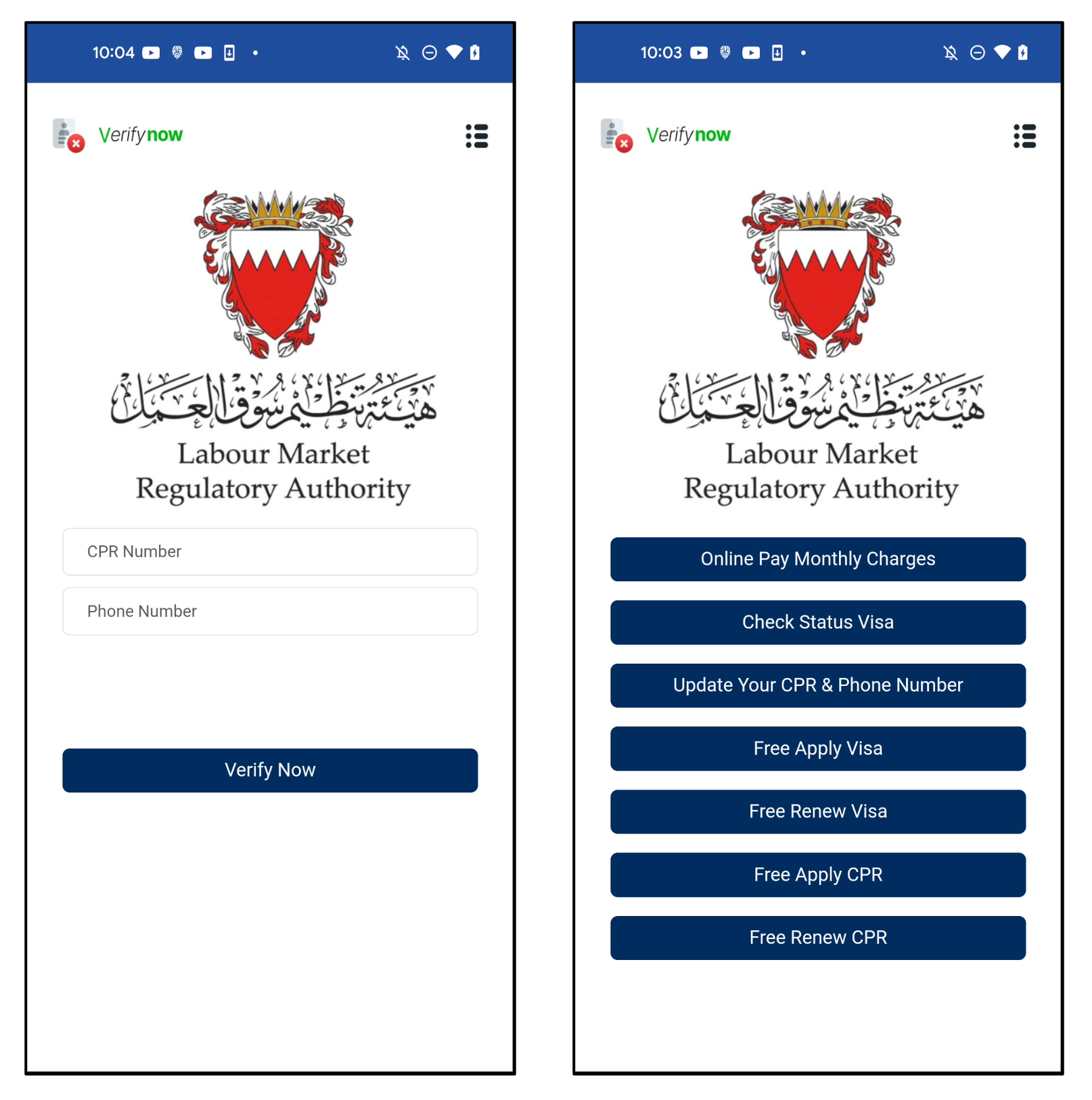
Figure 8. The first screen (left) and next screen of a fake app (right)
There are various menus, but they are all linked to the same URL. The parameter value is the CPR and phone numbers input by the user on the first screen.
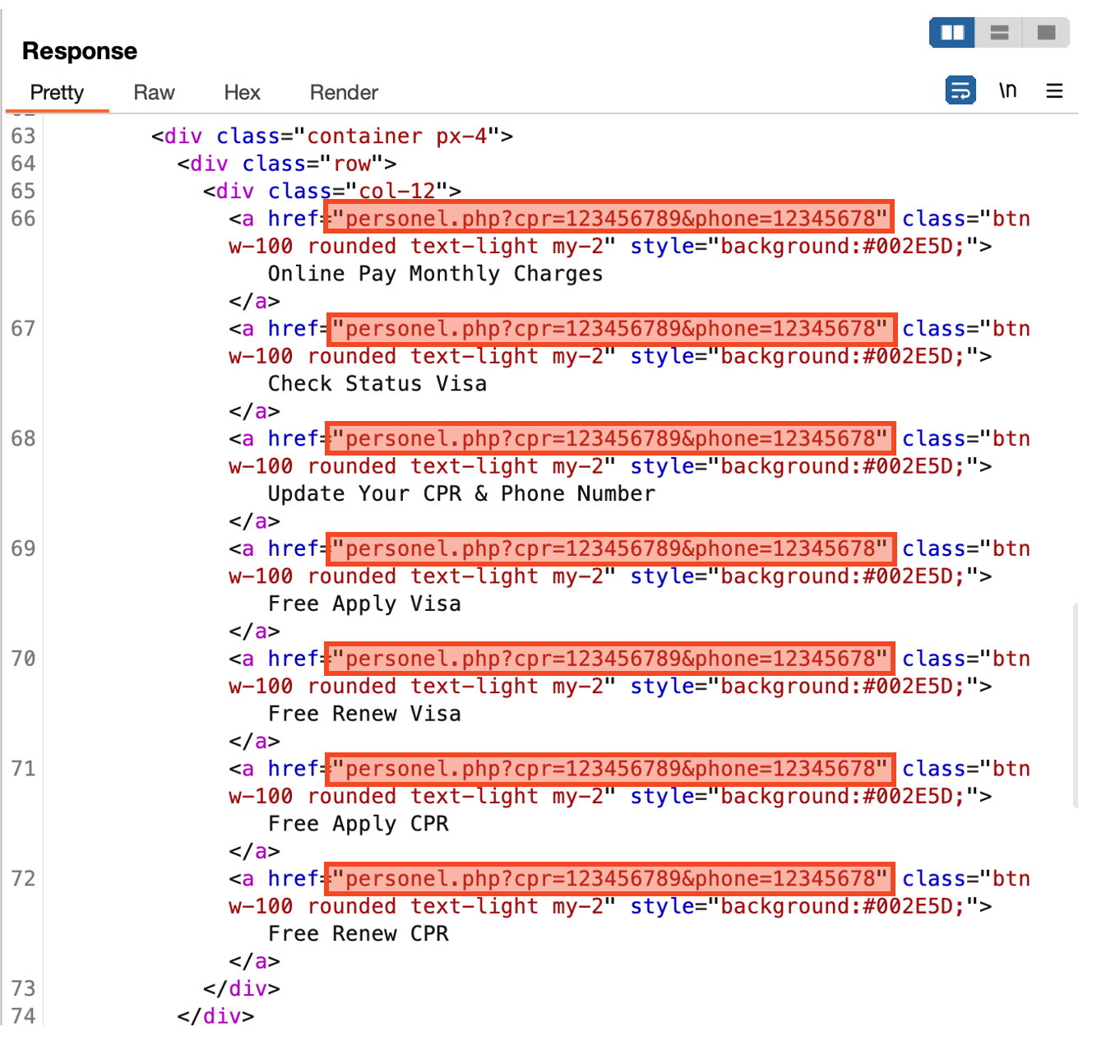
Figure 9. All menus are linked to the same URL
The last page asks for the user’s full name, email, and date of birth. After inputting everything and clicking the “Send” button, all information inputted so far will be sent to the malware author’s c2 server.
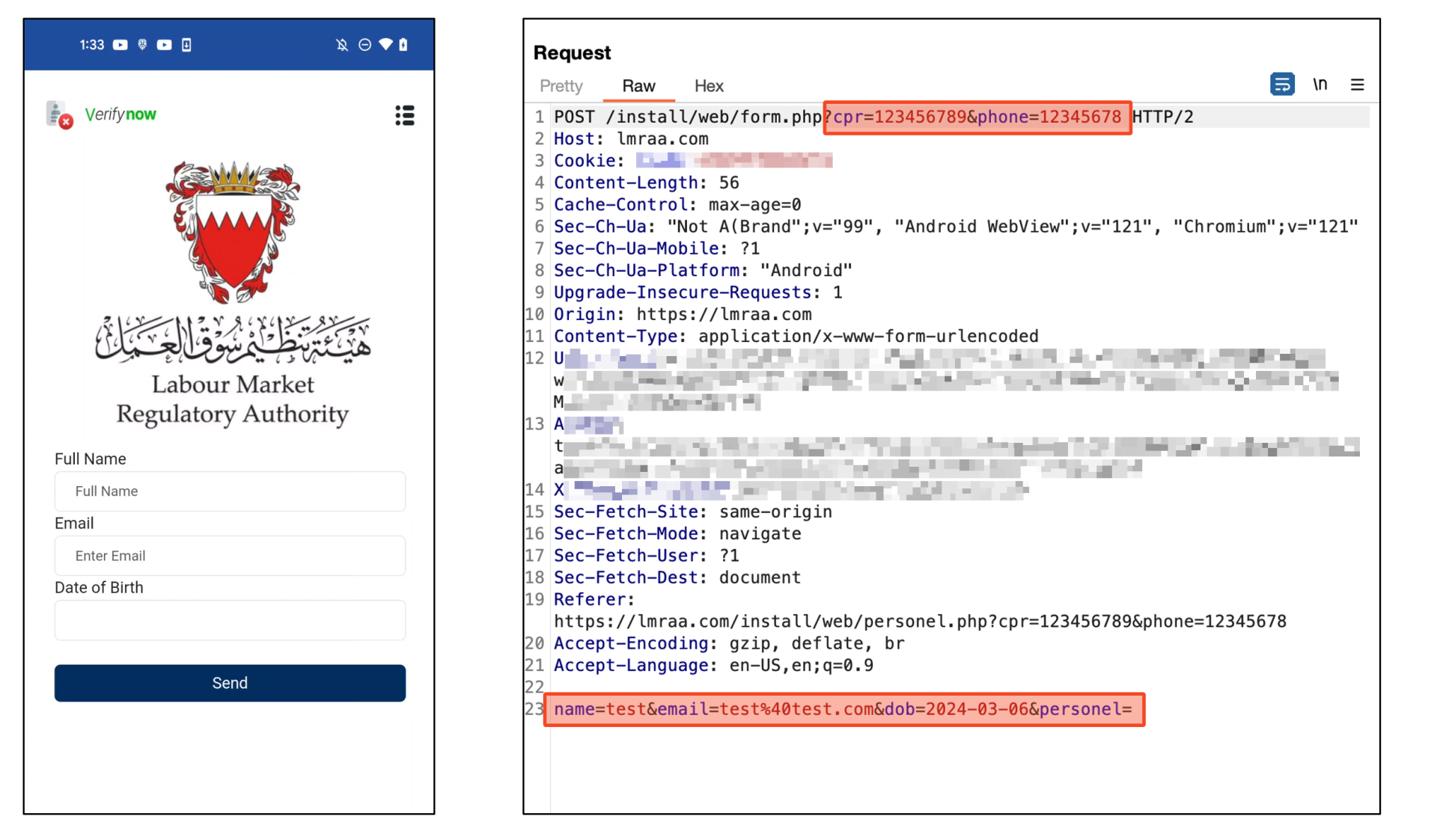
Figure 10. All data sent to C2 server
After sending, it shows a completion page to trick the user. It shows a message saying you will receive an email within 24 hours. But it is just a counter that decreases automatically. So, it does nothing after 24 hours. In other words, while users are waiting for the confirmation email for 24 hours, cybercriminals will exploit the stolen information to steal victims’ financial assets.
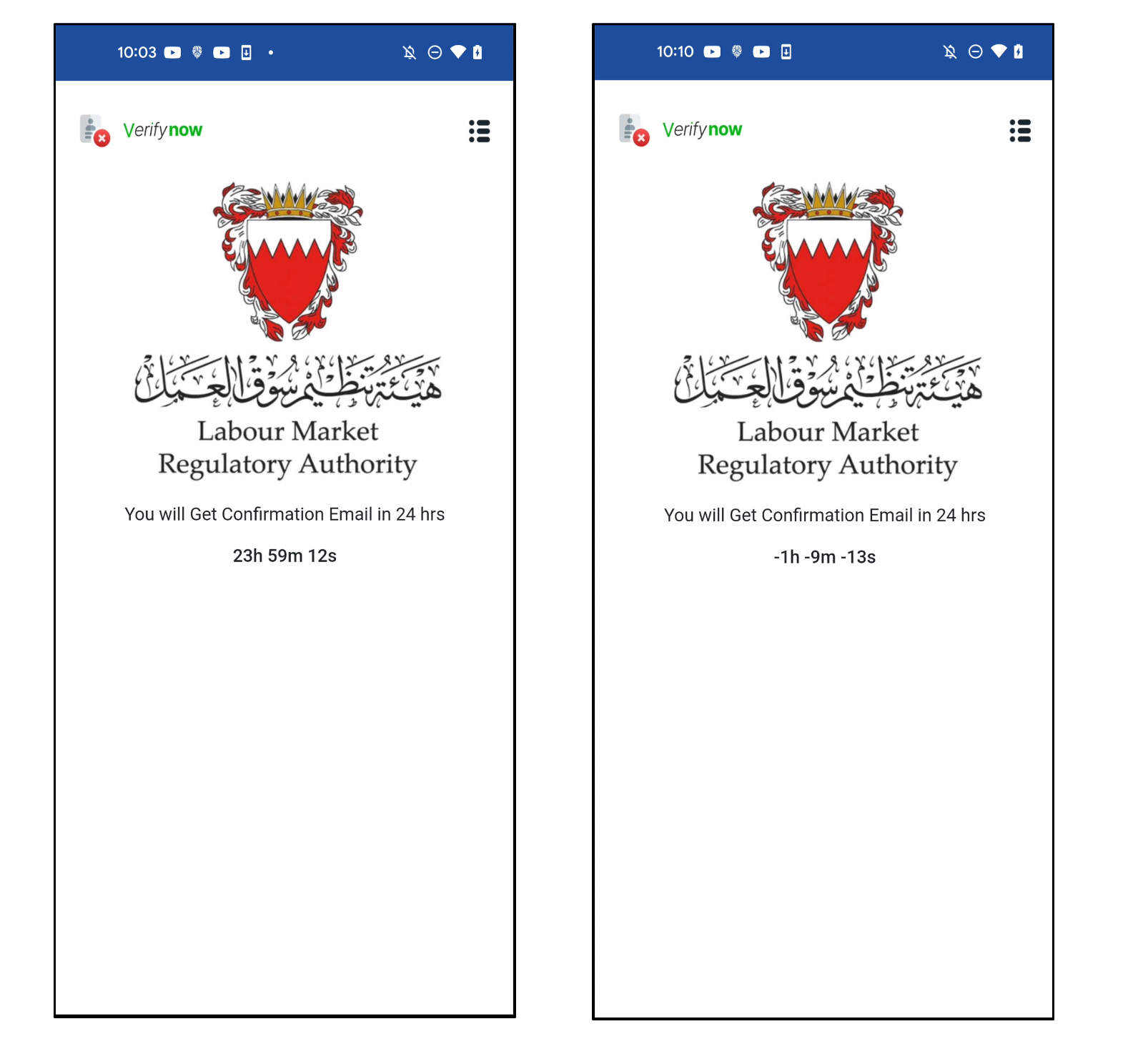
Figure 11. Completion page to trick users
In addition, they have a payload for stealing SMS. This app has a receiver that works when SMS is received. So as soon as SMS comes, it sends an SMS message to the C2 server without notifying the user.
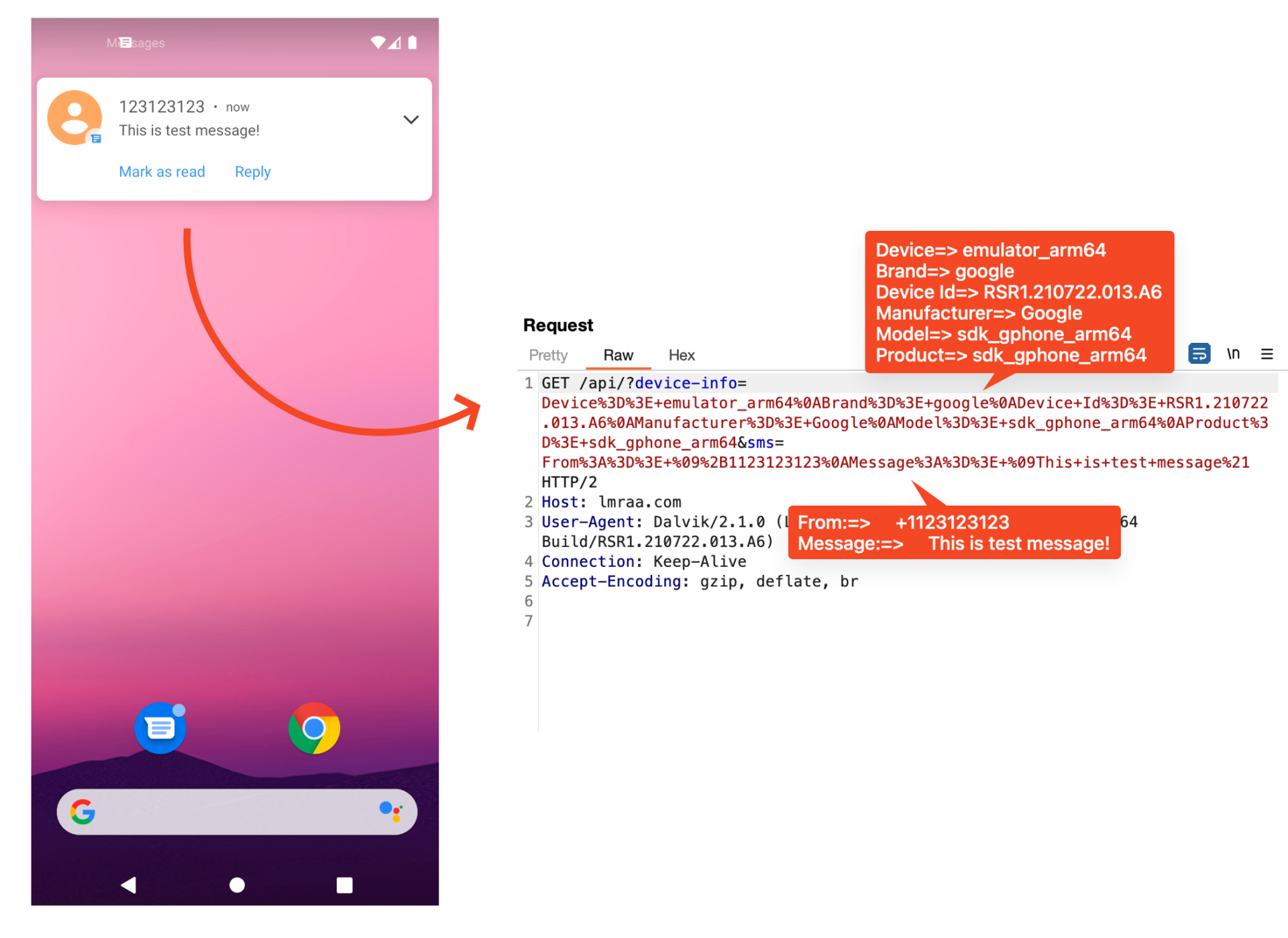
Figure 12. Payload for stealing SMS
We confirmed that there are two types of these apps. There is a type that implements a custom C2 server and receives data directly through web API, and another type is an app that uses Firebase. Firebase is a backend service platform provided by Google. Among many services, Firestore can store data as a database. This malware uses Firestore. Because it is a legitimate service provided by Google, it is difficult to detect as a malicious URL.
For apps that use Firebase, dynamically load phishing URLs stored in Firestore. Therefore, even if a phishing site is blocked, it is possible to respond quickly to maintain already installed victims by changing the URL stored in Firestore.
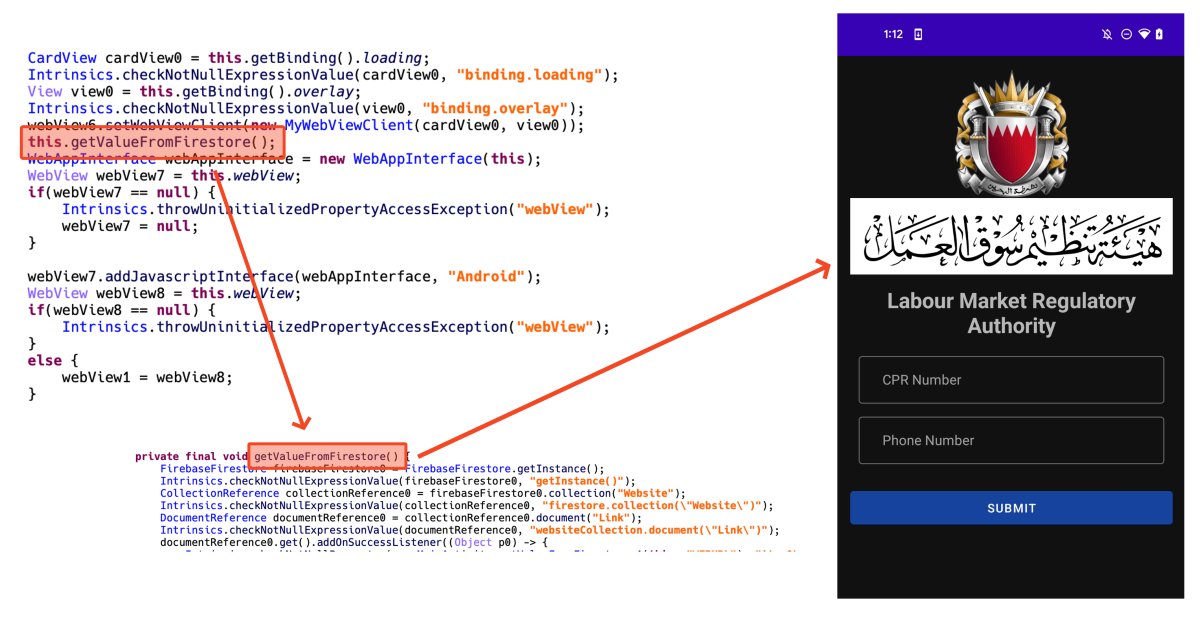
Figure 13. Dynamically loading phishing site loaded in webview
According to our detection telemetry data, there are 62 users have already used this app in Bahrain. However, since this data is a number at the time of writing, this number is expected to continue to increase, considering that new Facebook pages are still being actively created.
Recent malware tends to target specific countries or users rather than widespread attacks. These attacks may be difficult for general users to distinguish because malware accurately uses the parts needed by users living in a specific country. So we recommend users install secure software to protect their devices. Also, users are encouraged to download and use apps from official app stores like Google Play Store or Apple AppStore. If you can’t find an app in these stores, you must download the app provided on the official website.
McAfee Mobile Security already detects this threat as Android/InfoStealer. For more information, visit McAfee Mobile Security.
Samples:
| SHA256 | Package Name | App Name |
| 6f6d86e60814ad7c86949b7b5c212b83ab0c4da65f0a105693c48d9b5798136c | com.ariashirazi.instabrowser | LMRA |
| 5574c98c9df202ec7799c3feb87c374310fa49a99838e68eb43f5c08ca08392d | com.npra.bahrain.five | LMRA Bahrain |
| b7424354c356561811e6af9d8f4f4e5b0bf6dfe8ad9d57f4c4e13b6c4eaccafb | com.npra.bahrain.five | LMRA Bahrain |
| f9bdeca0e2057b0e334c849ff918bdbe49abd1056a285fed1239c9948040496a | com.lmra.nine.lmranine | LMRA |
| bf22b5dfc369758b655dda8ae5d642c205bb192bbcc3a03ce654e6977e6df730 | com.stich.inches | Visa Update |
| 8c8ffc01e6466a3e02a4842053aa872119adf8d48fd9acd686213e158a8377ba | com.ariashirazi.instabrowser | EasyLoan |
| 164fafa8a48575973eee3a33ee9434ea07bd48e18aa360a979cc7fb16a0da819 | com.ariashirazi.instabrowser | BTC Flasher |
| 94959b8c811fdcfae7c40778811a2fcc4c84fbdb8cde483abd1af9431fc84b44 | com.ariashirazi.instabrowser | BenefitPay |
| d4d0b7660e90be081979bfbc27bbf70d182ff1accd829300255cae0cb10fe546 | com.lymors.lulumoney | BBK Loan App |
Domains:
Firebase(for C2):
The post Fake Bahrain Government Android App Steals Personal Data Used for Financial Fraud appeared first on McAfee Blog.

According to Pew, three-in-ten U.S. adults say they have used a dating site or app. That number climbs to 53% for people under the age of 30. More and more people are turning to digital platforms to find love and companionship or simply to expand their social circles. However, as the popularity of online dating grows, so do the potential risks associated with it. From privacy concerns to identity theft, the digital dating world can be fraught with peril if you’re not careful. But fear not, by following a few simple guidelines, you can navigate the online dating scene safely and securely.
This article is for you or anyone you know who may be hopping onto an online dating app like Match, Bumble, Plenty of Fish, eHarmony, Tinder, or OkCupid. Think of it as an advice column of a different sort, where we talk about dating in light of your online privacy and safety.
For starters, we have a couple of previous blogs that offer sound advice about online dating. The first covers ways you can protect your privacy when you’re using online dating apps, which starts with picking a dating app that has a good reputation. The second rounds out the topic with further online dating advice for adults and teens alike. Give them a look!
It starts with basic hygiene. Digital hygiene, that is. Before you dive into a dating app, ensure that your device (and all your connected devices while you’re at it) has a comprehensive security solution in place. As you surf, chat, and meet up online, you’ll want to know that you’re protected against malware, viruses, phishing attacks, sketchy links, and so forth. Other features will come in handy (and be necessary as well), like ones that help you manage your passwords, protect your identity, safeguard your privacy, and more—all of which we’ll talk about in a bit.
Picking the right app is like picking the right date. From a security standpoint, these apps are the keepers of highly personal information about you, so you’ll want to know how they handle data, what privacy protections are in place, what information they gather when you first sign up, and what they continue to gather as you use the app. Do your research. Read up on their privacy policies. See what other people have to say about their experiences. And get a sense of what the app is all about. What’s its approach to dating? What kind of relationships are they focusing on? Make sure all of it feels right to you.
Only give the app the information that’s absolutely necessary to sign up. Dating apps ask questions so that they can help you find an ideal match, yet only share what you feel comfortable sharing. This is true from a personal standpoint, but it’s true from a security standpoint too. Anything you share along those lines could be at risk of a hack or a breach, the likes of which were reported by Wired and Forbes last year. If your info is compromised, it could lead to anywhere from identity theft to harassment, so when you use a dating app, keep the sharing to a minimum—and keep your eyes peeled for any suspicious activity across your social media, online accounts, and even your finances.
Another password to remember! That’s just what you need, right? Right! It absolutely is, and a strong one is vital. You can create one and manage all of your passwords with McAfee+’s password manager. It’ll encrypt your passwords and use multi-factor authentication, which offers even further protection from hacks and attacks on your account.
You can help keep your chats more private, and just about anything else you’re doing online, by using a VPN (virtual private network). For example, our VPN uses bank-level encryption to keep your personal data and activities private from hackers. And it’ll hide other information associated with your dating account while you’re online, like personal details, credit card numbers, and so forth. Given the security risks we’ve talked about so far, you’ll want to look into a VPN.
If you’re not using a VPN on your device, don’t use your dating app on public Wi-Fi. The issue is this: plenty of public Wi-Fi hotspots aren’t secure. Someone else on the network could easily intercept the information you send over it, including your passwords, any photos you share, and any chats you have. In other words, using public Wi-Fi without protection is like opening a door that leads right to you and your most personal data. This applies to everything on public Wi-Fi, not just dating apps. If you use public Wi-Fi at all, you really should use a VPN.
In the ever-evolving landscape of online dating, safeguarding your privacy and security is paramount. By implementing strategies such as using strong passwords, employing a reliable VPN, and exercising caution on public Wi-Fi, you can navigate the digital dating sphere with confidence. Remember, your safety and privacy are non-negotiable priorities in the pursuit of love and companionship online.
The post How to Safely Date Online appeared first on McAfee Blog.

There are now over 5 billion active social media users worldwide, representing 62.3% of the global population. While social networks serve as valuable tools for staying connected with loved ones and documenting life events, the ease of sharing information raises concerns. With a mere few clicks, posts and messages can inadvertently divulge significant personal details, potentially compromising privacy and leaving individuals vulnerable to identity theft. That’s why it’s crucial to make sure you’ve got the know-how to keep your privacy protected while using these platforms.
To empower you in this digital age, we’ve compiled a comprehensive guide featuring ten essential tips to fortify your online security and preserve your privacy on social networks:
Whether you’re a seasoned social media user or just dipping your toes into the digital waters, these strategies will equip you with the knowledge and tools needed to safeguard your online identity effectively. With the added support of McAfee+, you can ensure an extra layer of security to keep your online presence more secure and private through advanced privacy features, 24/7 identity monitoring and alerts, and real-time protection against viruses, hackers, and risky links.
The post How to Protect Yourself on Social Networks appeared first on McAfee Blog.

From impersonating police officers in Pennsylvania to employees of the City of San Antonio, scammers have been impersonating officials nationwide in order to scam people. A nurse in New York even lost her life savings to a spoofing scam. Phone spoofing is a technique used by callers to disguise their true identity and phone number when making calls. By altering the caller ID information displayed on the recipient’s phone, spoofers can make it appear as though the call is coming from a different number, often one that looks more trustworthy or familiar to the recipient. This deceptive practice is commonly employed by telemarketers, scammers, and individuals seeking to engage in fraudulent activities, making it more difficult for recipients to identify and block unwanted or suspicious calls.
Most spoofing is done using a VoIP (Voice over Internet Protocol) service or IP phone that uses VoIP to transmit calls over the internet. VoIP users can usually choose their preferred number or name to be displayed on the caller ID when they set up their account. Some providers even offer spoofing services that work like a prepaid calling card. Customers pay for a PIN code to use when calling their provider, allowing them to select both the destination‘s number they want to call, as well as the number they want to appear on the recipient’s caller ID.
Scammers often use spoofing to try to trick people into handing over money, personal information, or both. They may pretend to be calling from a bank, a charity, or even a contest, offering a phony prize. These “vishing” attacks (or “voice phishing”), are quite common, and often target older people who are not as aware of this threat.
For instance, one common scam appears to come from the IRS. The caller tries to scare the receiver into thinking that they owe money for back taxes, or need to send over sensitive financial information right away. Another common scam is fake tech support, where the caller claims to be from a recognizable company, like Microsoft, claiming there is a problem with your computer and they need remote access to fix it.
There are also “SMiShing” attacks, or phishing via text message, in which you may receive a message that appears to come from a reputable person or company, encouraging you to click on a link. But once you do, it can download malware onto your device, sign you up for a premium service, or even steal your credentials for your online accounts.
The convenience of sending digital voice signals over the internet has led to an explosion of spam and robocalls over the past few years. Between January 2019 and September 2023, Americans lodged 2.04 million complaints about unwanted phone calls where people or robots falsely posed as government representatives, legitimate business entities, or people affiliated with them.
Since robocalls use a computerized autodialer to deliver pre-recorded messages, marketers and scammers can place many more calls than a live person ever could, often employing tricks such as making the call appear to come from the recipient’s own area code. This increases the chance that the recipient will answer the call, thinking it is from a local friend or business.
And because many of these calls are from scammers or shady marketing groups, just registering your number on the FTC’s official “National Do Not Call Registry” does little help. That’s because only real companies that follow the law respect the registry.
To really cut back on these calls, the first thing you should do is check to see if your phone carrier has a service or app that helps identify and filter out spam calls.
For instance, both AT&T and Verizon have apps that provide spam screening or fraud warnings, although they may cost you extra each month. T-Mobile warns customers if a call is likely a scam when it appears on your phone screen, and you can sign up for a scam-blocking service for free.
There are also third-party apps such as RoboKiller that you can download to help you screen calls, but you should be aware that you will be sharing private data with them.
Enhance your smartphone security effortlessly with McAfee+ which has 24/7 identity monitoring and alerts, advanced privacy features, and AI-powered security for real-time protection against viruses, hackers, and risky links.
The post How to Stop Phone Spoofing appeared first on McAfee Blog.

You consider yourself a responsible person when it comes to taking care of your physical possessions. You’ve never left your wallet in a taxi or lost an expensive ring down the drain. You never let your smartphone out of your sight, yet one day you notice it’s acting oddly.
Did you know that your device can fall into cybercriminals’ hands without ever leaving yours? SIM swapping is a method that allows criminals to take control of your smartphone and break into your online accounts.
Don’t worry: there are a few easy steps you can take to safeguard your smartphone from prying eyes and get back to using your devices confidently.
First off, what exactly is a SIM card? SIM stands for subscriber identity module, and it is a memory chip that makes your phone truly yours. It stores your phone plan and phone number, as well as all your photos, texts, contacts, and apps. In most cases, you can pop your SIM card out of an old phone and into a new one to transfer your photos, apps, etc.
Unlike what the name suggests, SIM swapping doesn’t require a cybercriminal to get access to your physical phone and steal your SIM card. SIM swapping can happen remotely. A hacker, with a few important details about your life in hand, can answer security questions correctly, impersonate you, and convince your mobile carrier to reassign your phone number to a new SIM card. At that point, the criminal can get access to your phone’s data and start changing your account passwords to lock you out of your online banking profile, email, and more.
SIM swapping was especially relevant right after the AT&T data leak. Cybercriminals stole millions of phone numbers and the users’ associated personal details. They could later use these details to SIM swap, allowing them to receive users’ text or email two-factor authentication codes and gain access to their personal accounts.
The most glaring sign that your phone number was reassigned to a new SIM card is that your current phone no longer connects to the cell network. That means you won’t be able to make calls, send texts, or surf the internet when you’re not connected to Wi-Fi. Since most people use their smartphones every day, you’ll likely find out quickly that your phone isn’t functioning as it should.
Additionally, when a SIM card is no longer active, the carrier will often send a notification text. If you receive one of these texts but didn’t deactivate your SIM card, use someone else’s phone or landline to contact your wireless provider.
Check out these tips to keep your device and personal information safe from SIM swapping.
With just a few simple steps, you can feel better about the security of your smartphone, cellphone number, and online accounts. If you’d like extra peace of mind, consider signing up for an identity theft protection service like McAfee+. McAfee, on average, detects suspicious activity ten months earlier than similar monitoring services. Time is of the essence in cases of SIM swapping and other identity theft schemes. An identity protection partner can restore your confidence in your online activities.
The post How to Protect Your Smartphone from SIM Swapping appeared first on McAfee Blog.

According to reports from the Federal Trade Commission’s Consumer Sentinel database, text message scams swindled $372 million from Americans in 2023 alone. The staggering figure highlights a growing concern for consumers globally, who increasingly interact with brands and service providers via text, email, and even social media. As our reliance on technology continues, it is important for everyone to understand how to spot scam texts amid the real messages they receive. amid the real messages they receive.
With such frequent communication from brands and organizations, you can be hard-pressed to figure out what is a scam or not. This practical and actionable advice may be able to help you spot the imposters and protect yourself against even the most hard-to-identify scam messages.
Most of us probably avoid reading disclaimers and terms of service from brands and organizations. Paying attention to guidelines for how an organization will contact you will help you stay safe from scams. Just take it from entertainment host, Andy Cohen.
Cohen received an email he thought was from his bank’s fraud department. Later, the scammer texted Cohen claiming to be from the bank, asking for more information. Cohen ended up sending the scammer money because he believed they were a bank representative. These days, many banks and brands have FYIs on their website about how to spot a legitimate text. Like this page from Chase, which goes over what a real Chase text looks like.
We have a similar disclosure on our site. For example, our customer service teams will never request sensitive information such as social security numbers, PINs, or bank or payment details. As soon as you sign up for a new account, it’s a good idea to check for this sort of disclaimer and familiarize yourself with contact methods and the type of information organizations might request.
Scam messages are so successful because scammers make them look real. During the holidays, when shoppers are ready to leap at deals, scam messages can be hard to resist. With an increased volume of scam texts during major shopping seasons, it’s no wonder open rates can be as high as 98%.
Consumers can protect themselves against realistic-looking scam messages by verifying the source of the message. If an email hits your mobile inbox, click on the sender’s name to expand their full email address. Typical brand emails will have a “do not reply” somewhere in the address or an official “@branddomain.com” email address. Scam email addresses often appear as strings of gibberish.
If unsure whether a text from a company is real, log into your account directly to see if it reflects the overdue bill or extra store credit that the text message suggests.
Knowing about the latest cybersecurity trends is always good practice. Scammers change their tactics constantly. Text scams that were popular one year may be totally out of style the next time you get a scam message.
Individuals looking for a place to start can check out FTC, FBI, and CISA websites. Those agencies offer valuable insights about fraud trends and recommendations about how people can protect themselves. The Better Business Bureau (BBB) has an interactive scam tracking tool, and AARP provides tips for older Americans who may not be as in tune with the latest tech trends and tools.
Thankfully, the software designed to protect against scams evolves, as well. Consumers can turn to product suites that offer features like finding and removing personal info from sites that sell it, adjusting social media controls, and even providing alerts about suspicious financial transactions.
For scam texts, AI is here to help. Text Scam Detector uses AI to scan SMS text messages and alert you about unsafe links. Users can delete those messages without opening them, reducing the risk of compromise and removing any question about whether the message is fraudulent or for real.
The $372 million figure is a stark reminder of growing fraud. As we continue into the digital age, the threat of fraudulent communications from scammers looms. To safeguard against bad actors, consumers must be proactive. By paying attention to brand communication guidelines, verifying the source of messages, remaining educated, and using modern privacy and identity products, consumers can avoid scams before they start.
The post How to Tell If Your Text Message Is Real appeared first on McAfee Blog.
APKDeepLens is a Python based tool designed to scan Android applications (APK files) for security vulnerabilities. It specifically targets the OWASP Top 10 mobile vulnerabilities, providing an easy and efficient way for developers, penetration testers, and security researchers to assess the security posture of Android apps.
APKDeepLens is a Python-based tool that performs various operations on APK files. Its main features include:
To use APKDeepLens, you'll need to have Python 3.8 or higher installed on your system. You can then install APKDeepLens using the following command:
git clone https://github.com/d78ui98/APKDeepLens/tree/main
cd /APKDeepLens
python3 -m venv venv
source venv/bin/activate
pip install -r requirements.txt
python APKDeepLens.py --help
git clone https://github.com/d78ui98/APKDeepLens/tree/main
cd \APKDeepLens
python3 -m venv venv
.\venv\Scripts\activate
pip install -r .\requirements.txt
python APKDeepLens.py --help
To simply scan an APK, use the below command. Mention the apk file with -apk argument. Once the scan is complete, a detailed report will be displayed in the console.
python3 APKDeepLens.py -apk file.apk
If you've already extracted the source code and want to provide its path for a faster scan you can use the below command. Mention the source code of the android application with -source parameter.
python3 APKDeepLens.py -apk file.apk -source <source-code-path>
To generate detailed PDF and HTML reports after the scan you can pass -report argument as mentioned below.
python3 APKDeepLens.py -apk file.apk -report
We welcome contributions to the APKDeepLens project. If you have a feature request, bug report, or proposal, please open a new issue here.
For those interested in contributing code, please follow the standard GitHub process. We'll review your contributions as quickly as possible :)

Four in ten Americans say they use peer-to-peer payment services, like Venmo, PayPal, or Apple Pay, at least once a month. These platforms have made it even easier to send money by adding QR codes that people can quickly scan to pull up someone’s profile and complete a payment. Two-thirds of restaurants have started including QR codes on tables to access menus. Scanning QR codes has become a normal, convenient way to exchange money or information.
Unfortunately, scammers are always looking for ways to take advantage of moments when people are primed to part with their money. The Federal Trade Commission is warning that scammers now use QR codes to hide harmful links to steal personal information. This new type of phishing attack, called “quishing,” highlights how scamming methods are constantly changing. In response, artificial intelligence (AI) is becoming an even more crucial part of defending against scammers.
To protect yourself against phishing attacks, it’s crucial to remain vigilant and employ proactive measures. Make sure to scrutinize all incoming emails, text messages, or social media communications for any signs of suspicious or unsolicited requests, especially those urging immediate action or requesting sensitive information.
Avoid clicking links, downloading attachments, or scanning QR codes from unknown or untrusted sources. Check the legitimacy of the sender by cross-referencing contact information with official sources or contacting the organization directly through trusted channels.
Before accepting where a QR code is going to take you, carefully examine the associated URL. Verify its authenticity by scrutinizing for any discrepancies, such as misspellings or altered characters, especially if it resembles a familiar URL.
Safeguard your mobile device and accounts by regularly updating the operating system. Additionally, bolster the security of your online accounts by implementing robust passwords and integrating multi-factor authentication measures to thwart unauthorized access.
As fraudsters continually evolve their tactics, distinguishing between what’s real and what’s fake becomes increasingly challenging. However, there is formidable technology available to safeguard against their schemes. AI can analyze vast amounts of data in real-time to detect patterns and anomalies indicative of fraudulent behavior. By continuously learning from new data and adapting algorithms, AI can stay ahead of evolving fraud tactics.
The McAfee+ suite of identity and privacy protections uses AI for identity protection, transaction monitoring, credit monitoring, and proactive Text Scam Detector to keep you safe from even the most sophisticated scam attempts. Text Scam Detector employs AI technology to block risky sites, serving as a secondary defense against accidental clicks on spam links. This ensures that even after being tricked into clicking, your device won’t open the fraudulent site.
Don’t leave your digital defenses to chance. See for yourself what advanced security looks like today.
The post How to Protect Against New Types of Scams Like QR Phishing appeared first on McAfee Blog.

Smartphones have enabled a whole new digital world, where apps are gateways to just about any service imaginable. However, like many technological developments, mobile app proliferation can be a bit of a two-edged sword. A report analyzing more than 1 billion smartphone transactions found 45,000 malicious mobile apps, many of which were in the gaming category.
From ad fraud to taking advantage of embedded system security issues, fraudsters are consistently targeting smartphone apps. The trouble is that it’s not always immediately clear which apps pose a threat in a world where one in 36 mobile apps are considered high-risk.
These security concerns require a proactive approach with the ability to spot the signs of fraud or malice so that those apps can be avoided from the get-go. That’s where the four Rs of personal mobile security come into play.
Review
Staying informed about common scam tactics and emerging threats through reliable cybersecurity resources can empower consumers to make informed decisions and recognize potential risks more effectively. Our annual Consumer Mobile Threat Report always gives up-to-date information about the cyberattack landscape.
Understanding what a malicious or scam app looks like can help you avoid downloading a fraudulent app. For example, many fraud apps have very short descriptions or reviews from people who have previously been duped. In addition to scrutinizing the descriptions and reviews of apps, it’s essential to download apps only from trusted sources such as official app stores like Google Play Store or Apple App Store. Third-party app stores or unknown websites may host malicious apps.
Re-check
Fraudsters excel at creating seemingly legitimate apps to carry out scams, often by deploying deceptive tactics such as requesting unnecessary permissions or operating stealthily in the background. Exercise caution and conduct thorough checks of device settings whenever installing a new app.
It’s also essential to remain vigilant for indicators of suspicious activity, especially if you may have installed apps without security checks in the past. Be on the lookout for anomalies, such as unauthorized subscriptions, unfamiliar social media logins, or unusually rapid battery drain, which could signal the presence of fraudulent apps operating without their knowledge. Some malicious apps may also consume data in the background, leading to unusual spikes in data usage. Regularly monitoring data usage can help individuals detect and address any unauthorized app activity.
Revoke
Over time, it’s easy to inadvertently grant excessive permissions to apps or connect accounts to services that you no longer use or trust. This can create vulnerabilities that malicious actors could exploit to gain unauthorized access to sensitive information.
Conduct an app review on your phone and revoke permissions or access granted to apps or services that are no longer needed or trusted. It’s essential to regularly audit and remove unnecessary permissions, apps, or connections to minimize the potential attack surface and reduce the risk of unauthorized access.
Reinforce
Reinforce your security posture with modern tools. Antivirus software remains a cornerstone of digital defense, offering proactive detection and mitigation of various threats, including malware, ransomware, and phishing attempts. For enhanced protection, consumers can opt for comprehensive security suites such as McAfee+, which not only includes antivirus capabilities but also integrates features like firewall protection, secure browsing, and identity theft prevention.
By leveraging these advanced security solutions, users can significantly reduce their vulnerability to cyberattacks and safeguard their personal and sensitive information effectively. Additionally, staying informed about emerging threats and regularly updating security software ensures ongoing resilience against evolving cyber threats in today’s dynamic digital landscape.
The post The Four Rs of Personal Mobile Security appeared first on McAfee Blog.